inbox and environment news: Issue 509
September 5 - 11, 2021: Issue 509
Time Of Ngoonungi
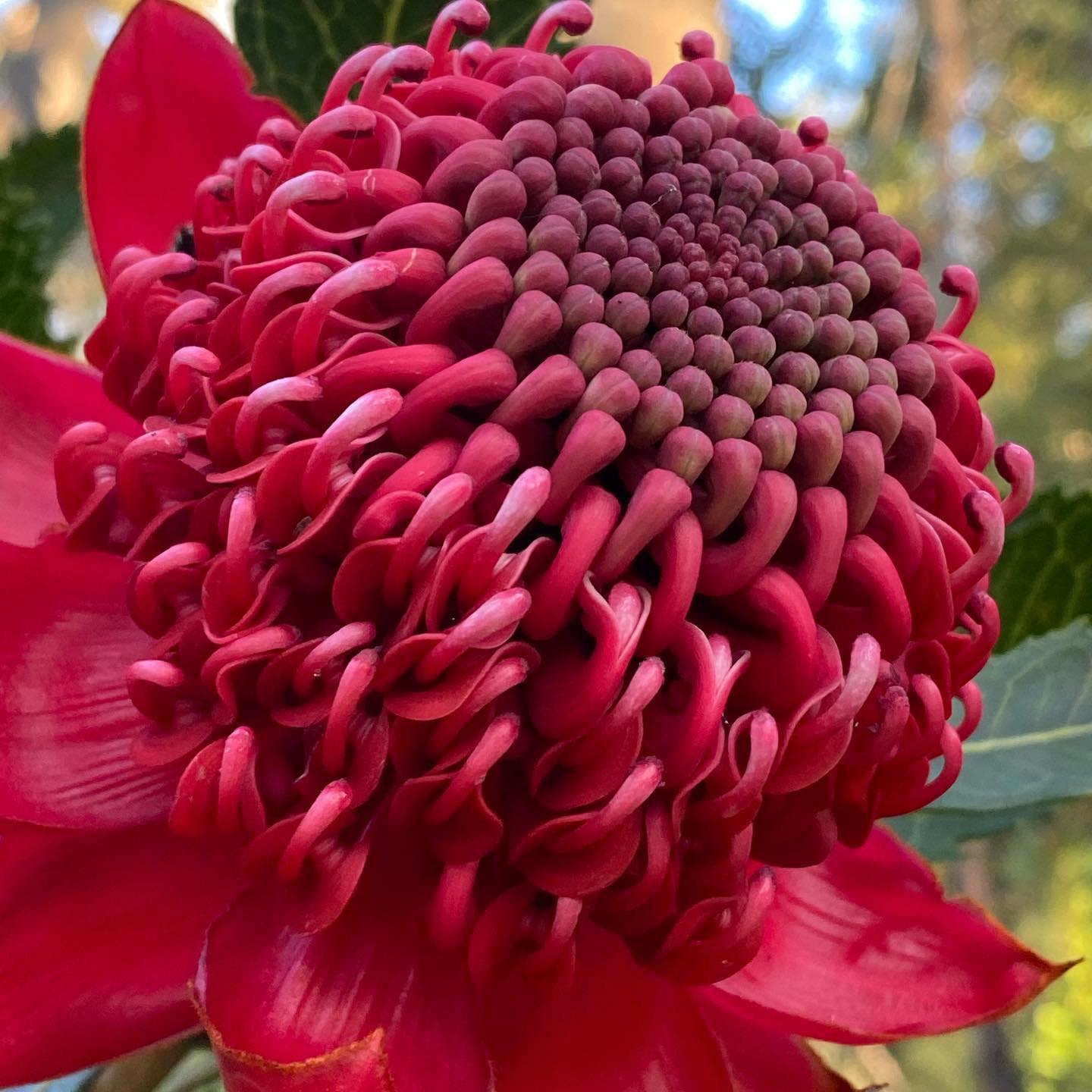
Migratory Bird Season
Baby Wildlife Season

Harry the ringtail possum. Sydney Wildlife photo
Avalon Public School Sunflower Project

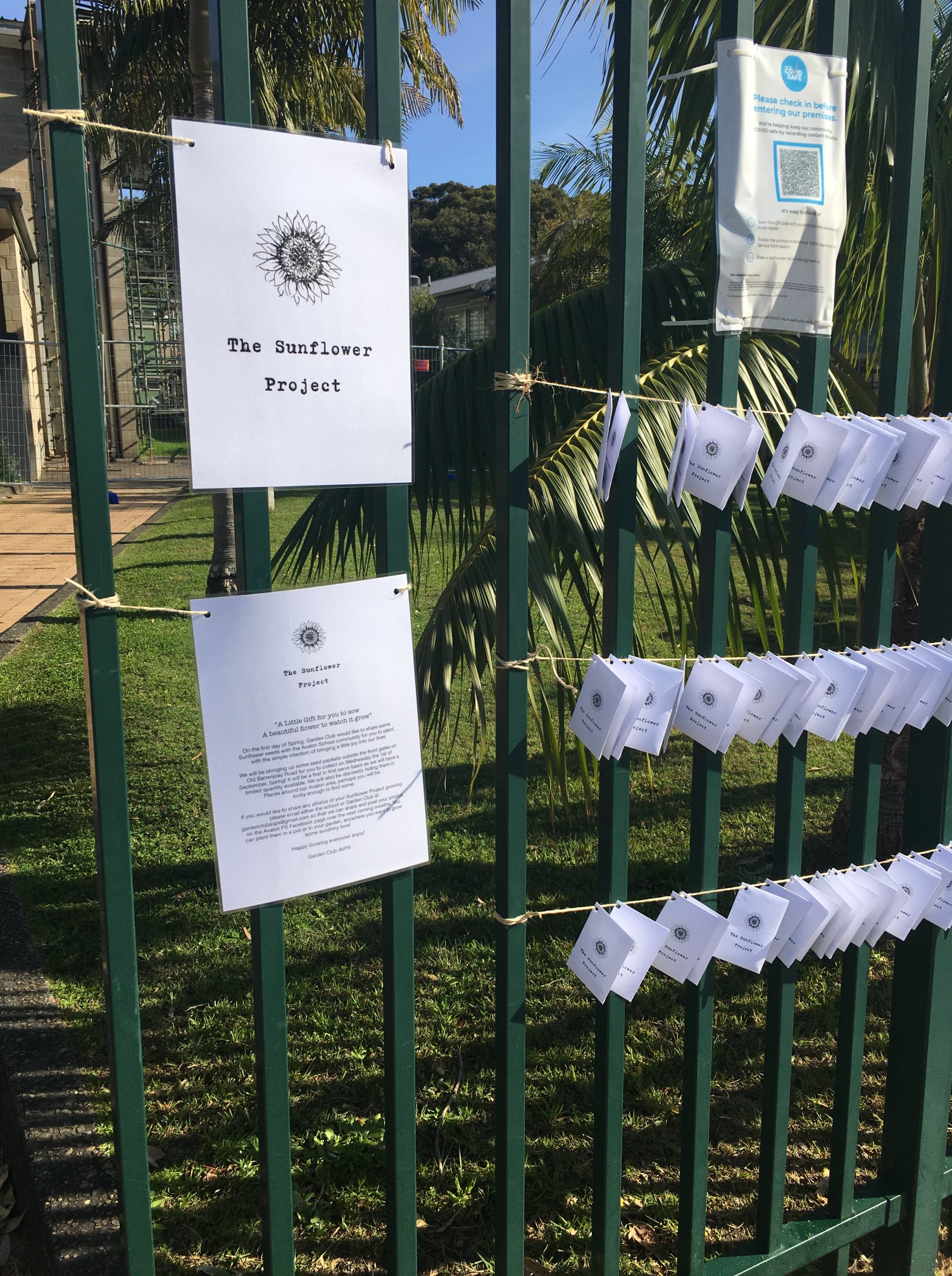
Federal Environment Minister Approves Coal Mine Expansion Beneath Sydney Water Catchment Until December 31st 2067
IPC Rejects Hume Coal Proposal Due To Threat Posed To Water And Communities
A Majority In Every Seat Want More Climate Action: Poll Of Mackellar Voters
- One-in-four voters (28%) rate climate change as the most important issue to determine their vote at the next federal election, while another 39% rate it as important, making climate important to 67% of voters.
- One-in-three (29%) voters in inner metro electorates and one-in-four (26%) voters in rural electorates say climate change is the most important issue for them at the next election.
- Half (50%) of Coalition voters want greater action on climate change and one-in-five Coalition voters say it is the issue that will determine their vote.
- Six out of ten voters (61%) support action to cut Australia’s greenhouse emissions by at least half by 2030.
- Nationally, 71% of voters do not see coal and gas as part of Australia’s future energy mix, with a majority in every seat rejecting plans for the government to build new gas and coal-fired power plants.
- 67% of voters think the Morrison government should pay more attention to expert advice on climate change.
- A majority in the Hunter Valley coal region of NSW and in the Queensland ‘coal seats’ of Flynn, Maranoa, Capricornia, Kennedy and Dawson do not believe new coal and gas plants should be built to supply Australia’s future energy needs.
Statistics For Mackellar:
- 80% of voters believe greater climate action will help nature and wildlife survive extreme weather.
- 67% of voters do not believe that new coal or gas power stations should be a priority for the federal government.
- 64% of voters believe the federal government need to be doing more to address climate change.
- 66% of voters say Labor and Coalition plans for climate action will influence their vote.
Human progress is no excuse to destroy nature. A push to make ‘ecocide’ a global crime must recognise this fundamental truth
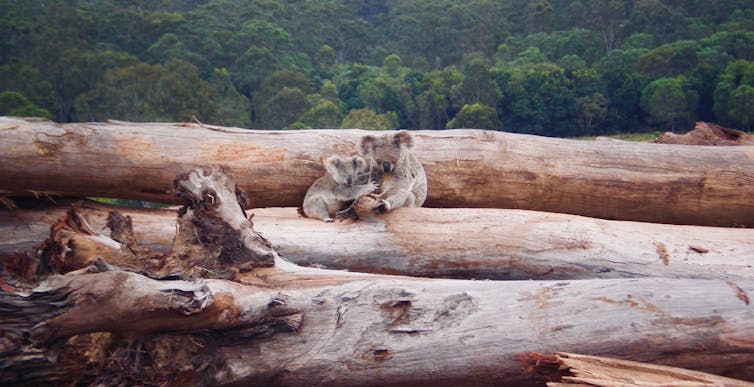
Scientists recently confirmed the Amazon rainforest is now emitting more carbon dioxide than it absorbs, due to uncontrolled burning and deforestation. It brings the crucial ecosystem closer to a tipping point that would see it replaced by savanna and trigger accelerated global heating.
This is not an isolated example of nature being damaged at a mass scale. The Intergovernmental Panel on Climate Change this month confirmed global heating is now affecting every continent, region and ocean on Earth. That includes Australia, which is a global deforestation hotspot and where the Great Barrier Reef is headed for virtual extinction.
In the face of such horrors, a new international campaign is calling for “ecocide” – the killing of ecology – to be deemed an international “super crime” in the order of genocide. The campaign has attracted high-profile supporters including French President Emmanuel Macron, Pope Francis and Swedish activist Greta Thunberg.
Making ecocide an international crime is an appropriate response to the gravity of this harm and could help prevent mass environmental destruction. But whether it does so will depend on how the crime is defined.
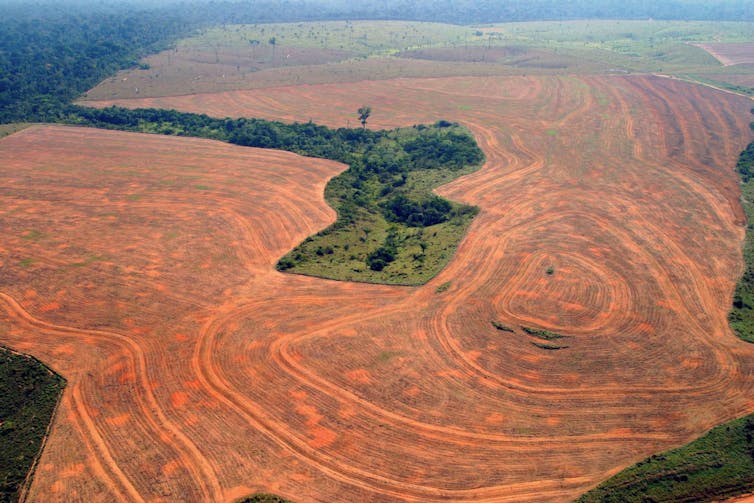
Defining Ecocide
The global campaign is being led by the Stop Ecocide Foundation. Last month an independent legal panel advising the campaign released a proposed amendment to the Rome Statute of the International Criminal Court. It would make ecocide a crime, defining it as:
unlawful or wanton acts committed with knowledge that there is a substantial likelihood of severe and either widespread or long-term damage to the environment being caused by those acts.
Defining a new international crime is a tricky balance. It must:
- capture the gravity, nature and extent of the harm
- set appropriate, but not impossible, standards of proof
- set moral standards that other international laws should follow.
The draft definition marks an important step in getting ecocide on the international agenda. And it does a good job of defining and balancing the core elements of ecocide – “severe” and either “widespread” or “long-term” damage to “any element of the environment”.
Laudably, these core elements show a concern for ecosystem integrity, human rights to a healthy environment, and the way grave damage to ecosystems can have devastating local and planetary consequences well into the future. This is a significant achievement.
Despite these strengths, lawyers and scholars, including ourselves, have identified problems with the definition.
Read more: Repeating mistakes: why the plan to protect the world’s wildlife falls short

Towards An Ecological Approach
A key concern is that the proposed definition considers only “unlawful” or “wanton” acts to be ecocide.
Most environmental destruction is not illegal. We need look no further than Australia’s land clearing laws or, indeed, federal environment law which has comprehensively failed to protect nature.
Under the proposed definition, lawful acts are only ecocidal if they are “wanton” – defined as “reckless disregard for damage which would be clearly excessive in relation to the social and economic and benefits anticipated”.
This condition assumes some ecocidal damage is acceptable in the name of human progress. According to the panel, such “socially beneficial acts” might include building housing developments and transport links.
This assumption furthers the human-centred privilege and “get-out-of-jail” clauses that have so weakened international environmental law to date.
We are not saying that housing, transport links or farms should not be built. But, in a period some scientists are calling the sixth mass extinction, they cannot come at the expense of crucial species and ecosystems. Sustainable development must respect this boundary.
The assumption also fails to recognise the gravity of ecocide. Such trade-offs – formally known as “derogations” – are rejected by international conventions governing slavery, torture, sexual violence, and fundamental human rights.
For example, the Convention Against Torture states:
no exceptional circumstances whatsoever, whether a state of war or a threat of war, internal political instability or any other public emergency, may be invoked as a justification of torture.
An international crime of ecocide must meet a similar standard. It should recognise that all forms of life, and the ecological systems that support them, have value for their own sake.
This perspective is known as multispecies justice. It holds that human well-being is bound to flourishing ecosystems, which have an intrinsic value outside the human use for them.
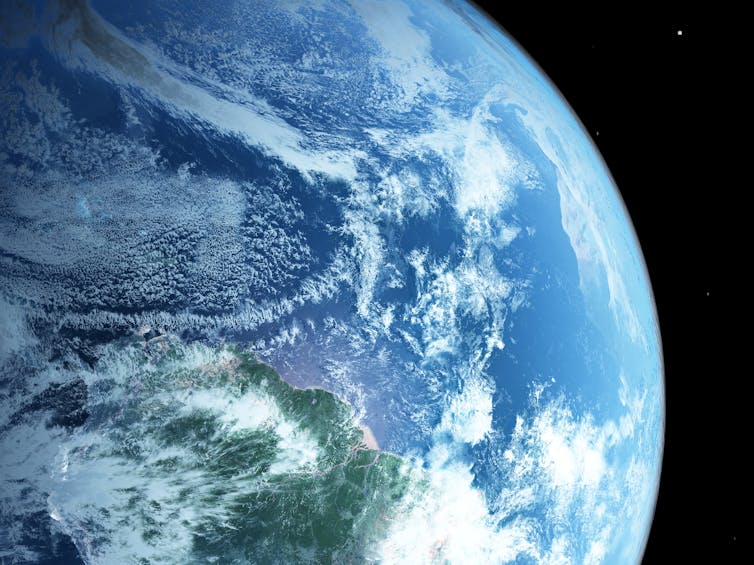
Genocide – the annihilation of human groups – is recognised as a crime against humanity. As political philosopher Hannah Arendt argued, genocide is an attack on human diversity that erodes the “very nature of mankind” and poses a grave threat to global order.
In the same way, the definition of ecocide should recognise that acts which destroy biological diversity, and lead to species extinction, threaten the very nature and survival of Earth’s multi-species community.
In Nazi-occupied Eastern Europe, the Balkans and more recently Myanmar, millions were killed and dispersed under a crime against humanity known as “ethnic cleansing”. Yet this killing and dispersal is happening to non-human communities as we write. The vast habitat destroyed by deforestation is as important to displaced animals as our homes are to us.
And this is a shared calamity. Mass environmental destruction is an attack on the foundations of all life that makes up the biosphere, of which humanity is only a part.
Read more: There's no end to the damage humans can wreak on the climate. This is how bad it's likely to get
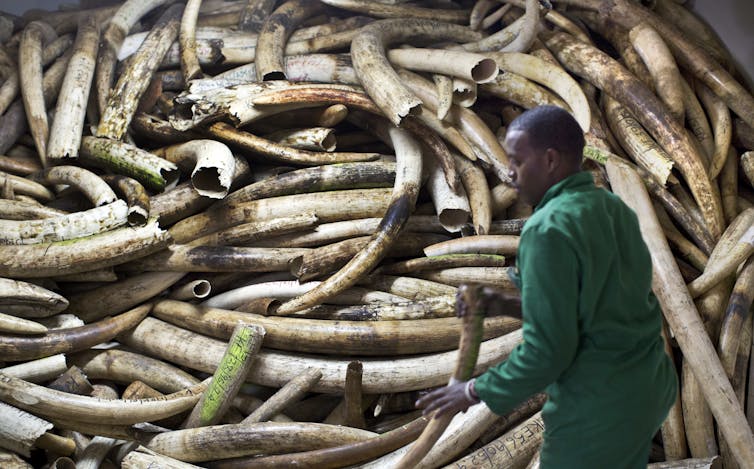
What Should Be Done?
The Stop Ecocide Foundation says the proposed definition will now be “made available for states to consider”.
As they do so, we ought to work towards a definition of ecocide that puts non-human lives at its centre. The crime of ecocide must be defined in a way that honours its victims – the myriad beings of the Earth.
In the meantime, political efforts to rein in biodiversity destruction must become an urgent global priority. And citizens can press their governments to criminalise the ecocidal acts that have become business as usual.
The Stop Ecocide Foundation chair Jojo Mehta provided the following response to this article:
The “unlawful or wanton” threshold is important, for the following reasons.
The other international crimes are based on acts which are already criminal under national laws. Not only would it be a stretch to expect states to accept a completely new across-the-board offence at international level, but it would crudely cut across both national legislation and the work of all those improving regulation and best practice.
With the word “unlawful”, existing laws in their specificity are given much needed reinforcement, and the evolution of new ones is supported. Thus the crime will dynamically grow more powerful, while respecting differences between national bodies of law.
“Wanton” addresses cases where the activity is legal but the likely destruction is disproportionately severe. It shouldn’t be assumed that the social and economic benefits mentioned are those of investors or wealthy consumers, nor that these will outweigh damage.
Effects, including cultural effects, on local and indigenous communities, and the wider implications of ecological harm, must be considered too.
This definition doesn’t aim to prevent each and every form of environmental harm – that is the job of national laws and regulations - but to make it clear that provoking the worst harms is a deeply serious crime worthy of sitting alongside genocide and war crimes. This is an incredibly powerful and – we believe – a profoundly transformative message.
Read more: Ordinary people, extraordinary change: addressing the climate emergency through 'quiet activism' ![]()
Anthony Burke, Professor of Environmental Politics & International Relations, UNSW and Danielle Celermajer, Professor of Sociology and Social Policy, University of Sydney
This article is republished from The Conversation under a Creative Commons license. Read the original article.
The Great Australian Dream? New homes in planned estates may not be built to withstand heatwaves
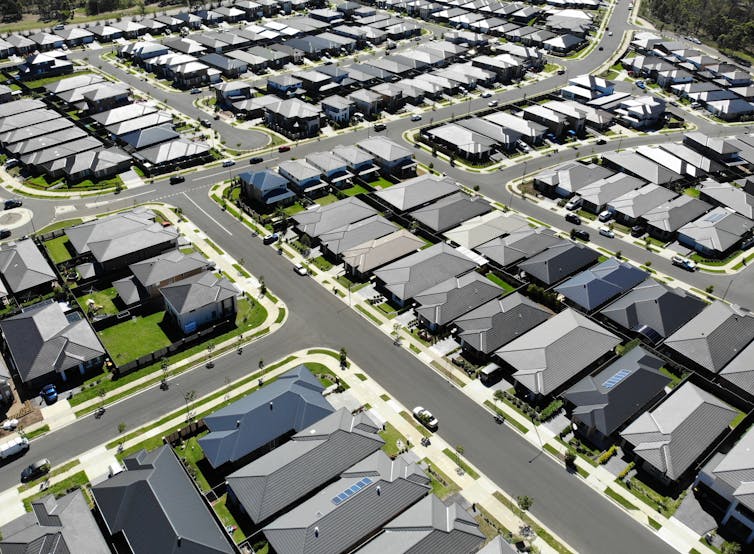
The design and construction of new homes in Australia may leave residents vulnerable to heatwaves and local councils can do little to fix the situation, our new research has found.
Our study focused on the Jordan Springs development at Penrith in Western Sydney. We found the estate may not be fit to withstand future heatwaves, potentially putting residents at risk and leaving them dependent on increasingly expensive air conditioning.
Australians are already experiencing significant heatwaves. And the Intergovernmental Panel on Climate Change this month warned heatwaves will become even more frequent, intense and longer.
Rising house prices in Australia’s major cities are driving many people to more affordable housing estates on the city fringe. But without interventions from state governments and local councils, such estates may be unsustainable as heatwaves intensify.
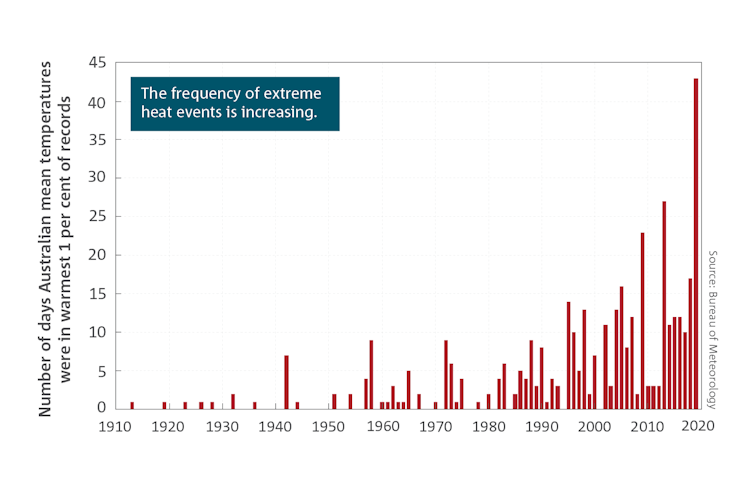
Exacerbating Hot Temperatures
Jordan Springs is a ten-year-old planned housing estate located 7km from Penrith. As of the 2016 Census, the estate was home to 5,156 residents. It currently consists of 1,819 homes and it is forecast to grow to about 13,000 residents in 4,800 homes.
Our research involved:
- collecting secondary information about the area, including climate forecasts, regional growth forecasts and planning law
- conducting surveys and interviews with residents, government and council officials and scientific experts
- examining the estate’s physical exposure to heat through aerial imagery and ground cover analyses.
Inland suburbs are significantly hotter than those on the coast, due to the lack of cooling coastal breezes. That is true of Penrith, which lies 60km west of Sydney’s central business district. On average, Penrith experiences three times more days above 30℃ than the CBD.
Jordan Springs is compliant with building regulations and individual homes are compliant with NSW’s Building Sustainability Index (BASIX). However, we found the estate’s built environment exacerbates the region’s hot temperatures and exposes residents to higher indoor temperatures. This points to a need for better planning regulations and building design.
We suspect our findings may be true for other planned estate developments across New South Wales and Australia, but more research is needed to confirm this.
Read more: Houses for a warmer future are currently restricted by Australia's building code
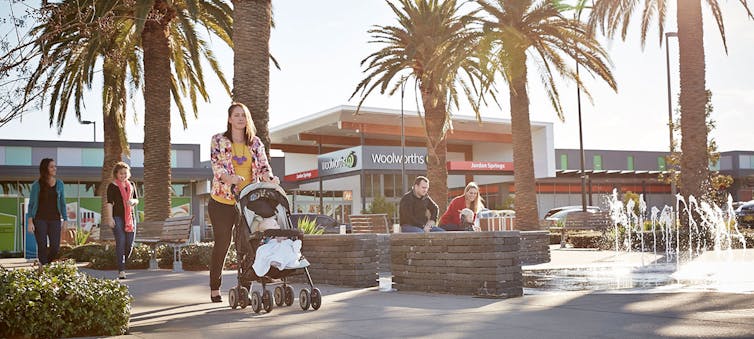
What We Discovered
Homes in the estate are built close together, with minimum side and rear distances from adjoining properties of 1.8m and 6m respectively. This can prevent air flow and allow heat to accumulate during the day. The close proximity also reduces space for vegetation.
The estate’s streets are wide and buildings are low. This reduces shade and maximises exposure to the sun of roofs, roads and other hard surfaces.
Almost 59% of Jordan Springs is heat-trapping hard surface cover such as concrete and asphalt. This compares to just 10% combined tree and shrub cover. A lack of greenery can contribute to the accumulation of heat.
Houses, roofs, and surrounding surfaces (such as roads, walls and fences) are generally dark-coloured, which increases heat absorption. For example, dark roofs have been recorded as 20-30℃ hotter than light coloured roofs (see images below).
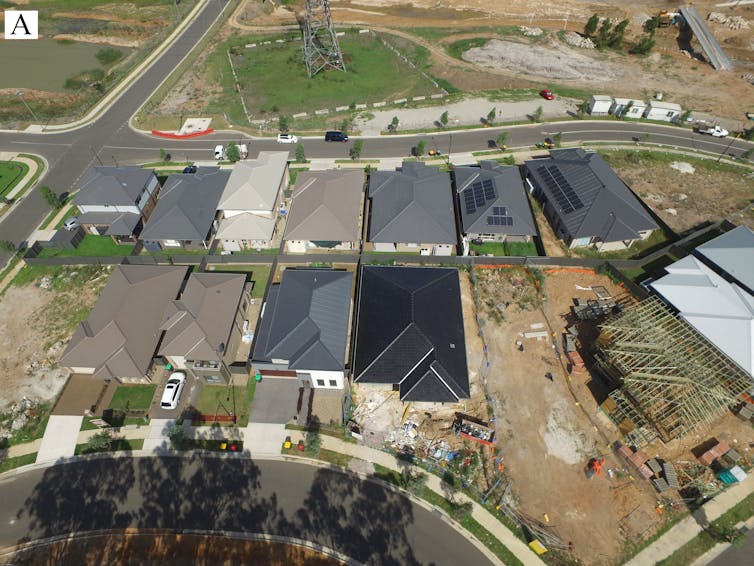

The NSW government last week recognised the problem dark roofs pose in hot weather, announcing light-coloured roofs will be mandatory in new homes in parts of southwest Sydney.
At Jordan Springs, we found some houses were poorly insulated and draughty. Yet many of these homes still attained a high BASIX star rating for energy efficiency.
The Conversation sought a response from the developer, Lend Lease. A company spokesperson said given the technical nature of the findings, it could not provide an adequate comment by deadline.
A Persistent Problem
During heatwaves, the built environment can exacerbate already dangerous conditions for humans. Many people turn on their air conditioners to beat the heat, increasing energy use and leading to higher electricity bills.
So why does this situation persist?
One councillor believes the profit imperative of developers is a factor, telling us:
the developers are only thinking about their shareholders and directors … I don’t believe that the developer is eco-friendly.
Meanwhile, a scientific expert said:
Today people don’t build double brick because of the cost […] they are about building fast and moving on and building more because of the profit they make […] everything must be cheap or else you can’t be fast.
In recent years there have been media reports of private certifiers signing off on buildings which do not meet planning guidelines. One local councillor told us this can result in homes that don’t perform well in hot weather.
And even if councils could enforce stricter rules, they risk losing interest from developers – and associated financial benefits. A frustrated council official said if one council had strict rules around housing developments and heat, and the neighbouring council did not, then:
developers are more likely to go there to build housing … It’s a tricky balance. We still want growth, and we want to work with developers, but we want to improve how we are doing things.
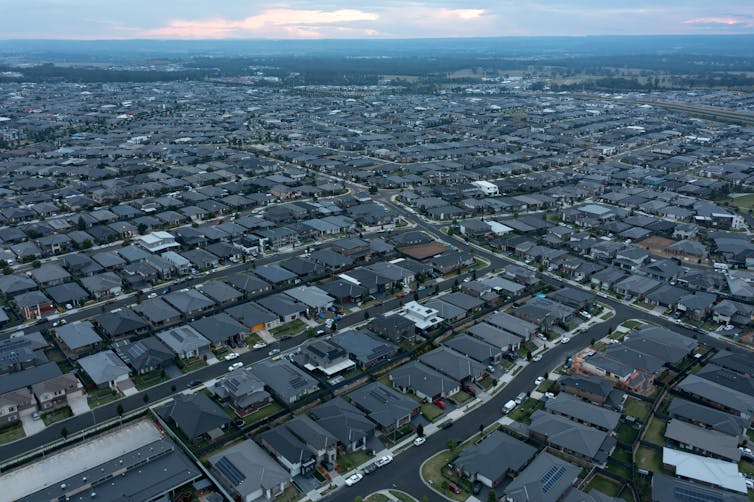
So Where To Now?
Clearly, many planned housing estates are not fit-for-purpose in our changing climate. But residents can take action to help their homes and estates stay cooler in hot weather.
Where possible, install heat-resistant features such as blinds, shades and awnings to increase passive cooling and reduce air conditioning dependence. Plant trees and shrubs in home gardens and encourage communities to engage in estate-wide greening initiatives.
Councils and developers should ensure prospective residents understand the benefits of light-coloured materials, passive design and urban green space. This will encourage them to make more informed decisions during the construction process.
But ultimately, the responsibility to ensure the heat-resilience of current and future housing rests with state governments and developers. While building new homes and returning profits is important, the well-being of citizens in a warmer world must be the paramount concern.
Read more: The world endured 2 extra heatwave days per decade since 1950 – but the worst is yet to come ![]()
Victoria Haynes, Research Officer, University of Sydney; Dale Dominey-Howes, Professor of Hazards and Disaster Risk Sciences, University of Sydney, and Emma Calgaro, Research Associate, Sydney Policy Lab, University of Sydney
This article is republished from The Conversation under a Creative Commons license. Read the original article.
This shy little wallaby has a white moustache and shares its name with a pub meal. Yet it’s been overlooked for decades

Am I not pretty enough? This article is part of The Conversation’s new series introducing you to Australia’s unloved animals that need our help.
For many people, the term “wallaby” may describe a single species, or rather just a small kangaroo. So you may be surprised to learn there are actually more than 50 known species of wallaby in Australia.
The parma wallaby (Macropus parma) is one of Australia’s smallest. It’s no larger than a house cat, with a body length up to 55 centimetres and a tail about the same length again. It has thick, brownish-grey fur, and a defining white moustache.
But this is about as much as can be said for its appearance, as even its moustache is common to many other wallaby species, such as the yellow-footed rock-wallaby.
Here, we aim to defend the voiceless. The parma wallaby’s failure to charm with either its looks or charisma has condemned it to obscurity by the general public and wildlife researchers alike, potentially dooming it to extinction.
The Parma’s Resurrection
So overlooked is the parma wallaby that for more than 30 years, it was presumed extinct until 1966, when a feral population was discovered on Kawau Island, New Zealand.
The species was introduced there a century earlier by former Prime Minister of New Zealand, Sir George Grey, who’s zoological interests led to Kawau becoming home to a menagerie of exotic animals.
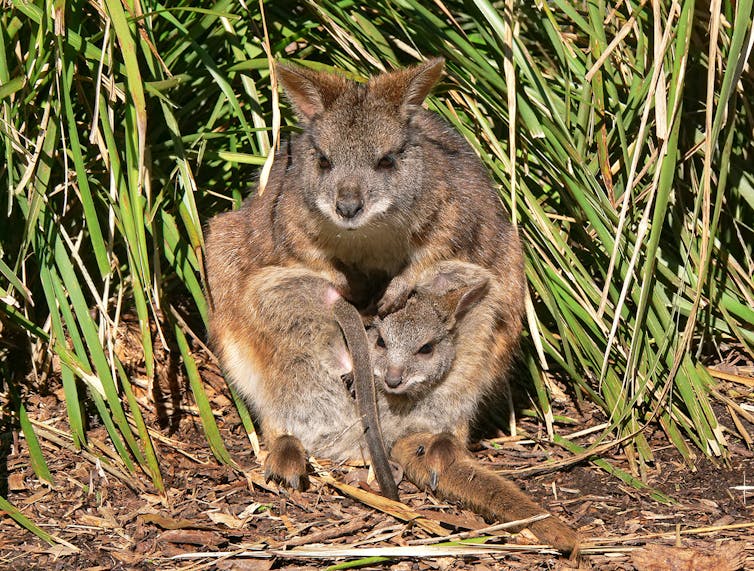
This sudden rediscovery resurrected the parma from the pages of natural history books, prompting a reintroduction program to re-establish the Kawau Island population in Australia. This occurred on two occasions, once on Pulbah Island in Lake Macquarie, and near Robertson, NSW. But both attempts were considered abject failures, with all reintroduced, marked individuals found dead, mostly due to predation by dogs and foxes.
Despite this unsuccessful program, the sudden spotlight on the species led to its rediscovery on the mainland in 1972 near Gosford, NSW. Soon after, a state-wide parma survey was conducted.
An Elusive Species
But since then, its ecology has largely gone unstudied and, once again, the parma has faded to obscurity.
The IUCN Red List — the pre-eminent assessment of the conservation status of the world’s biodiversity — has relied on a guestimate of population size, placing it at under 10,000 individuals.
Despite little monitoring the species is still considered only “near threatened” on the Red List, but events like the Black Summer bushfires may have significantly reduced its population.
Read more: Meet the broad-toothed rat: a chubby-cheeked and inquisitive Australian rodent that needs our help
As a result of its cryptic nature and very recent rediscovery in the wild, there is scarce known about the ecology of the parma wallaby. We don’t even know the exact origins of its name.
We do know its preferred habitat is moist eucalyptus forest with thick, shrubby understory. It shelters there during the day, often with nearby grassy areas as, at night, they typically feed on grass and herbs. They’re also found in rainforest margins and drier eucalypt forest, but to a lesser extent.
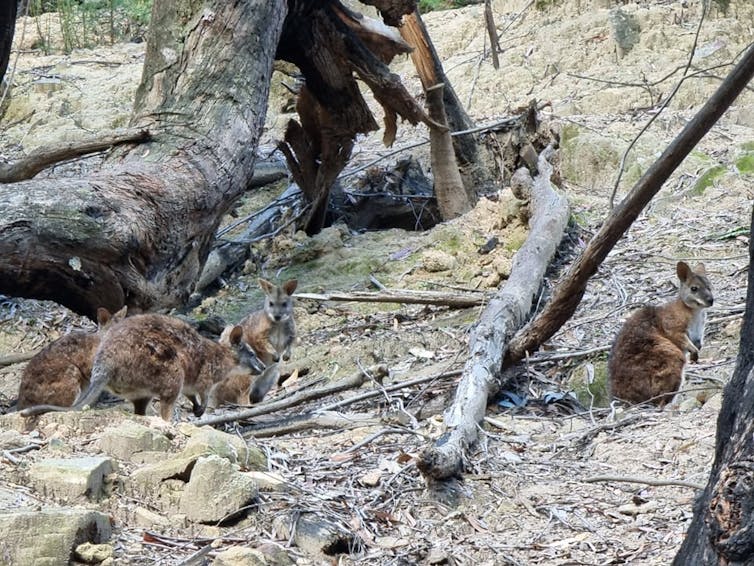
The Parma Wallaby Is Under Threat
We also know the parma wallaby’s range is in decline and has been since European colonisation.
The species once occurred from southern Queensland to the Bega area in the southeast of NSW. Now, its range is confined to the coast and ranges of central and northern NSW. It’s patchily distributed throughout cool, high-altitude forests along the Great Dividing Range.
It weighs around 5 kilograms, placing it in the critical weight range category. This means it’s vulnerable to feral predators, such as dogs, cats and foxes.
Read more: One cat, one year, 110 native animals: lock up your pet, it's a killing machine
Another major threat facing parma wallabies is habitat destruction from catastrophic bushfires.
The 2019-2020 Black Summer bushfires killed, injured or displaced an estimated three billion animals. Over half (55%) of the parma’s key habitat was severely burned. Coupled with the loss of those that would have perished in the flames, the species is now considered vulnerable in NSW.

Saving The Parma
The recent bushfire Royal Commission raised the issue that Australia doesn’t have a comprehensive, central source of information about its native flora and fauna. This is especially urgent, given seemingly “drab” species like the parma wallaby that have gone unnoticed for too long.
All species rely on interactions with a plethora of other species to survive in a complex system from which humans are not exempt. But with so little known about these interconnected relationships, we don’t know what the broader impacts to the ecosystem would be if one species disappeared.
Imagine a Jenga tower where each species is a wooden block. You can never really be certain which block you remove will cause the tower to collapse. Australia has an appalling extinction record, and we can’t afford to be playing Jenga with our biodiversity — whether it’s a boring bird, an ugly fish or just another wallaby.
Our ongoing research aims to help fill this conservation gap. We focus on a range of conservation actions the parma wallaby needs immediately.
These include carrying out field surveys to gauge the extent of their survival, and identifying the places that need refuge vegetation recovery. Refuge patches of bushland are important because they provide parma wallabies escape routes and places to hide, helping protect them from predation.
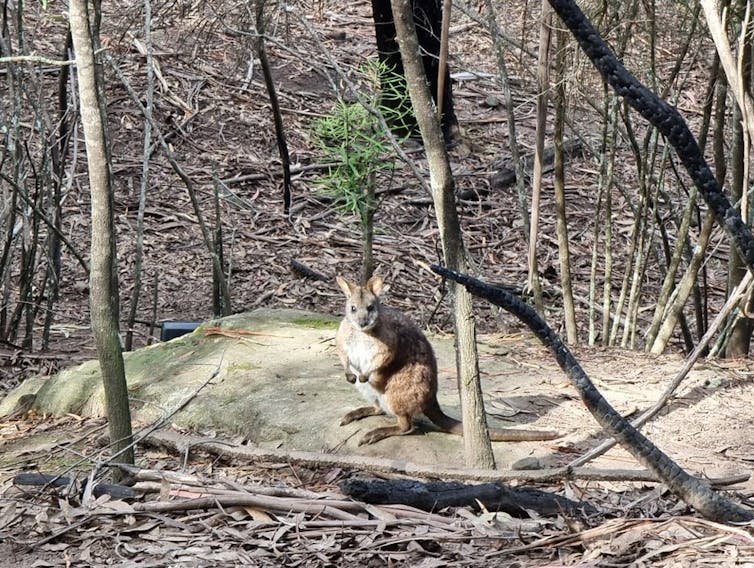
But You Can Help, Too
Given the breadth of catastrophic fires is expected to increase under climate change, we can all help threatened species like the parma wallaby bounce back.
Come bushfire season, you can reduce the fire risk around your home by clearing anything that could fuel a fire — long grass, weeds and leaves on the ground and in guttering.
The parma wallaby, like many other little mammals, is vulnerable to introduced predators, especially cats. By keeping your cat indoors, you could be sparing the lives of 186 animals per year.

You can urge your politicians to value Australia’s unique and precious biodiversity. They are the ones who will ultimately determine whether our threatened species survive or go extinct.
Finally, you can volunteer. There are many volunteer-based conservation projects all over Australia, run by government agencies, charities, and universities.
With the ongoing pandemic travel restrictions, there’s no better time to experience the rich biodiversity this country has to offer, and discover less celebrated, but still fascinating, species like the parma wallaby.![]()
Elliott Dooley, PhD Candidate, University of Newcastle and Matt Hayward, Professor of Conservation Science, University of Newcastle
This article is republished from The Conversation under a Creative Commons license. Read the original article.
NSW Sustainability Awards Now Open For Entry
- NSW Net Zero Action Award
- NSW Biodiversity Award
- NSW Circular Transition Award
- NSW Clean Technology Award
- NSW Large Business Transformation Award
- NSW Small to Medium Business Award
- NSW Youth as our Changemakers Award
- Minister's Young Climate Champion Award
- NSW Clean Technology Award: Recognises outstanding initiatives by an organisation or organisations in collaboration that show- case efficient resources through renewable energy, low emissions technology, and appreciable pollution reduction (beyond compliance) of Australia's water, air, and land.
- NSW Biodiversity Award: Recognises outstanding initiatives by an organisation or organisations in collaboration that protect our habitat, flora and/or fauna to ensure Australia's ecosystems are secured and flourish for future generations.
- NSW Circular Transition Award: Recognises outstanding achievements in innovative design in waste and pollution systems and products, through to regenerating strategies. The award will go to a company that has adopted a technology, initiative or project that is helping the business move from a linear to a circular model.
- NSW Large Business Transformation Award: Recognises outstanding achievements that demonstrate business and values alignment with multiple UN Sustainable Development Goals and by integrating sustainability principles and practices across business activities.
- NSW Youth as our Changemakers Award: Recognises young innovators aged between 18-35 years, who bring fresh perspectives, bold ideas and compelling initiatives that align with any or the multiple UN SDG's.
- NSW Net Zero Action Award: Recognises organisations, (company, business association, NGOs) that can demonstrate a tangible program or initiative that evidences transition toward a 1.5-Degree goal, through a publicly communicated net zero commitment, plus data, disclosures and investments to support it.
- NSW Small to Medium Business Award: Recognises outstanding achievements that demonstrate business and values alignment with multiple UN Sustainable Development Goals and by integrating sustainability principles and practices across business activities.
- Minister's Young Climate Champion Award: The Minister's Young Climate Champion Award recognises young innovators aged under 18 years who bring bold ideas for a safe and thriving climate future that align with any of the UN SDGs. Young and passionate minds who have taken outstanding actions that benefit the sustainability of their communities and help address climate change will be showcased in this award, which is a celebration of young people with drive, commitment and a passion for sustainability and the environment.
This bird’s stamina is remarkable: it flies non-stop for 5 days from Japan to Australia, but now its habitat is under threat
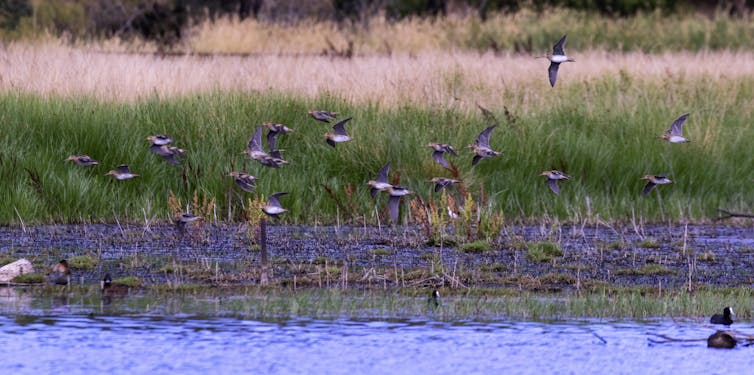
Imagine having to fly non-stop for five days over thousands of kilometres of ocean for your survival. That’s what the Latham’s Snipe shorebird does twice a year, for every year of its life.
This migratory shorebird, similar in size to a blackbird, completes this gruelling migration to warmer climes, where it prepares itself for its return flight and the next breeding season.
Unfortunately, their wetland habitat is now being lost to development and other pressures, putting this tough little bird at risk.
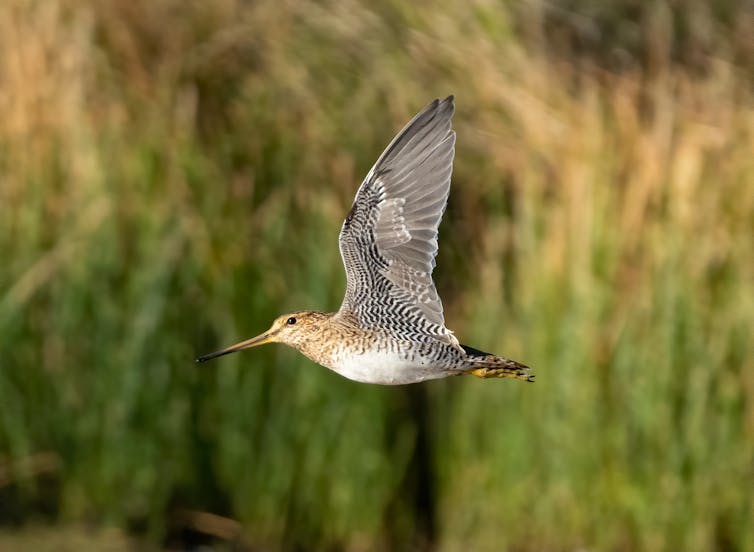
Read more: Be still, my beating wings: hunters kill migrating birds on their 10,000km journey to Australia
A Feat Of Incredible Endurance
Latham’s Snipe breeds in northern Japan and parts of eastern Russia during May-July and spends its non-breeding season (September to March) along Australia’s eastern coast.
Like other migratory shorebirds, it has incredible endurance, undertaking a non-stop, over-ocean flight between its breeding and non-breeding grounds.
It arrives at its destination severely malnourished and spends the Australian summer months building up its strength and body fat to complete its long return flight.
Unlike many other migratory shorebird species in Australia, you won’t find Latham’s Snipe in large flocks enjoying picturesque estuaries and bays. Instead, it hides away in thickly vegetated wetlands during the day to avoid local predators.
Their characteristic brown mottled feathers help them hide in wetlands.
Large eyes high on their heads allow them to see far and wide. Their exceptional eyesight helps them constantly scan for dangers at night, when they forage for food in open wet and muddy areas.
Latham’s Snipe is the ultimate sun-seeker. It breeds in the northern hemisphere when the snows have melted and the weather is warm, then returns to the southern hemisphere to take advantage of spring rains, warmer weather and food-rich wetlands.
It spends its entire time in Australia feeding, resting and growing new flight feathers in preparation for the long haul back to Japan in autumn.
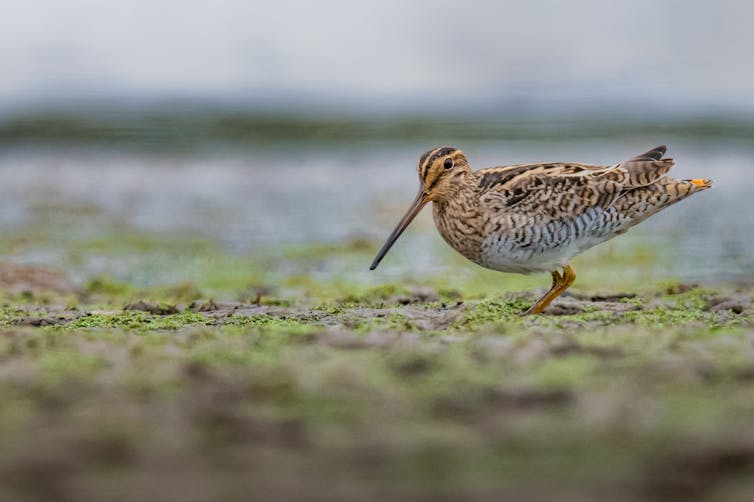
No Food And Nowhere To Rest
Latham’s Snipe, formerly known as the Japanese Snipe, was once a popular game bird. Hunting and wetland loss during the 20th century have contributed to a decline in Latham’s Snipe in south-eastern Australia.
The signing of the Japan Australia Migratory Bird Agreement in 1981 has stopped snipe hunting in both countries. However, their wetland habitat continues to be lost due to land development and drying of wetlands.
Imagine flying for five days straight, arriving at your destination emaciated and exhausted, only to find your habitat has disappeared. No food and nowhere to rest. This is the crisis facing Latham’s Snipe and many other migratory shorebird species.
No Formal Protection For Many Of Its Wetlands
Under the Australian government Environment Protection and Biodiversity Conservation Act, any grouping of 18 or more snipe at a wetland site is considered nationally important. Unfortunately, however, development on snipe habitat still occurs.
In 2014 — triggered by a plan to allow housing construction on an important snipe wetland area — a team of passionate researchers and citizen scientists banded together to initiate a monitoring program of Latham’s Snipe in south-west Victoria.
After the first year of the monitoring, the Latham’s Snipe Project expanded to other parts of the country with help from a large number of dedicated volunteers and professionals.
The story from this monitoring is still unfolding but two clear patterns are emerging:
Latham’s Snipe often congregate in urban wetlands; and
the majority of these important wetlands have no formal protection from development or disturbance.
7,000km, Non-Stop, In Three Days
Between 2016 and 2020, the Latham’s Snipe Project started tagging snipe with small electronic devices to try and learn about their migratory routes.
The team uncovered an amazing migration from a female snipe captured in Port Fairy. She left her breeding grounds in northern Japan and flew directly to south-east Queensland in three days, a non-stop flight of around 7,000km. A trip that might normally take around five days, this incredible individual did in three.
This is one of the fastest bird migrations on record and highlights how demanding these over-ocean migrations are. It also shines the spotlight on the critical importance of good quality wetland habitat when the snipe return to Australia.
Urban development continues to threaten Latham’s Snipe habitats. Several snipe sites in eastern Australia are at risk from housing developments and large infrastructure projects.
However, a different way of doing things is possible.
Eco-friendly developments like the Cape Paterson Ecovillage in Victoria provide hope. Here, researchers and citizen scientists have worked with the developer to help design conservation areas within the development to protect and restore wetlands for snipe.
Such progress is heartening, but a critically important next step is to make changes to local planning schemes that explicitly recognise wetlands for Latham’s Snipe.

Read more: Birds use massive magnetic maps to migrate – and some could cover the whole world ![]()
Birgita Hansen, Senior Research Fellow, Federation University and Better Data for Better Decisions Constellation Leader, Food Agility CRC, Federation University Australia
This article is republished from The Conversation under a Creative Commons license. Read the original article.
Robber barons and high-speed traders dominate Australia’s water market
Scott Hamilton, The University of Melbourne and Stuart Kells, La Trobe UniversityWhat began as an informal arrangement between neighbouring farmers, where one farm’s surplus water could be transferred to another, has over the past two decades morphed into a complex set of commodity markets whose annual turnover exceeds A$1.8 billion.
When the Murray–Darling Basin water markets were established, little consideration was given to training farmers or equipping them with the tools they would need.
“Many older farmers struggle even to use a smartphone,” one farmer told us in research for our book Sold Down The River, to be published this week. “They simply can’t use the water trading platforms.”
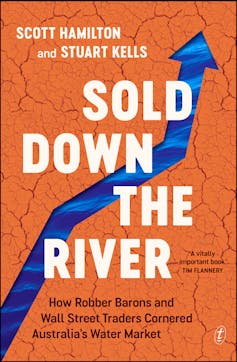
But others can, to their huge advantage. “Being a water broker is a lot like buying and selling shares or any other financial asset,” one investor said last year.
“There is no depreciation, there’s no goodwill, there is no maintenance and repairs. There are not many asset classes that are that good.”
The 2015 film adaptation of Michael Lewis’s bestselling The Big Short ends with a chilling line.
Investment genius Michael Burry had predicted the 2007 US housing market collapse and the ensuing financial crisis but, the movie said, was now “focusing all of his trading on one commodity — water”.
In a shocking report delivered to the treasurer in February, the Australian Competition and Consumer Commission found “scant rules governing the conduct of market participants, and no particular body to oversee trading activities, undermining confidence in fair and efficient markets”.
In particular, water market intermediaries such as brokers and exchange platforms currently operate in a mostly unregulated environment, resulting in a lack of clarity regarding the role brokers play, and permitting undisclosed conflicts of interest to arise.
Trading behaviours that can undermine the integrity of markets, such as market manipulation, are not prohibited, insider trading prohibitions are insufficient, and information gaps make these types of detrimental conduct difficult to detect.
The report has shifted the debate about water in the Murray-Darling Basin. Regulators, politicians, officials and researchers all realise that something has gone horribly wrong.
Scant Rules, Little Oversight
At the beginning of the water trading experiment, little effort was put into defining the goals of water trading, or how its success would be measured.
Yet despite that oversight, it’s easy to conclude that on any relevant measure the market has failed. It has failed the environment. It has failed farmers and towns. It has failed to recognise the rights of Indigenous Australians. And it has failed in its basic function of allocating water to where it can best be used.
Like a plane crash, the market failed because crucial systems and backups broke down simultaneously.
Here are the top four fractures in the multi-point failure:
Essential design steps weren’t taken. The designers spent little time on ensuring proper market conduct and integrity. There are multiple exchanges and at no particular moment is there a clear picture of the market value of water rights, even within the same valley. Large irrigators appear to be taking water over which they don’t have rights and selling it outside the markets to farmers of walnuts and other thirsty crops, leaving dying rivers in their wake.
To ensure the water market was “liquid”, the designers removed restrictions on who could own and trade water rights. Then they took the extraordinary step of exempting traders from regulation that would normally apply to financial markets and markets for commodities. External traders used tactics no one anticipated including market manipulation and high-speed trading.
The Commonwealth Water Act gave responsibility for overseeing the markets to the Australian Competition and Consumer Commission, whose expertise is competition, rather than the Australian Securities and Investments Commission, whose expertise is in finance. A 2014 regulation expressly exempted basic tradable water rights from the definition of “derivative” under the ASIC Act.
There is little precision in the water policy debate. Terms such as “hoarding”, “efficiency”, “speculation” and “investment” are used without consistency or clarity. People in and around the Murray-Darling Basin have been talking over each other for years, allowing rorts that should have been caught early to persist.
Added to these are a series of counter-intuitive tax advantages and subsidies that drive water rights away from the best land toward arid lands far down-river.
The Silence Is Deafening
A giant policy experiment is sucking hundreds of millions of dollars each year out of the Murray-Darling Basin, and it is sending water away from our most productive land and what used to be our most vibrant food-bowl communities.
The federal government has had the report of the Competition Commission’s water markets inquiry since February. The silence is deafening.
Read more: Water injustice runs deep in Australia. Fixing it means handing control to First Nations
In our research and in our book, we have mapped out a way forward for allocating scarce irrigation water and balancing the management of our largest river system.
Indigenous rights, environmental sustainability and food security are but some of what’s at stake.![]()
Scott Hamilton, Strategic Advisory Panel Member, Australian-German Energy Transition Hub, The University of Melbourne and Stuart Kells, Adjunct Professor, College of Arts, Social Sciences and Commerce, La Trobe University
This article is republished from The Conversation under a Creative Commons license. Read the original article.
Flies like yellow, bees like blue: how flower colours cater to the taste of pollinating insects
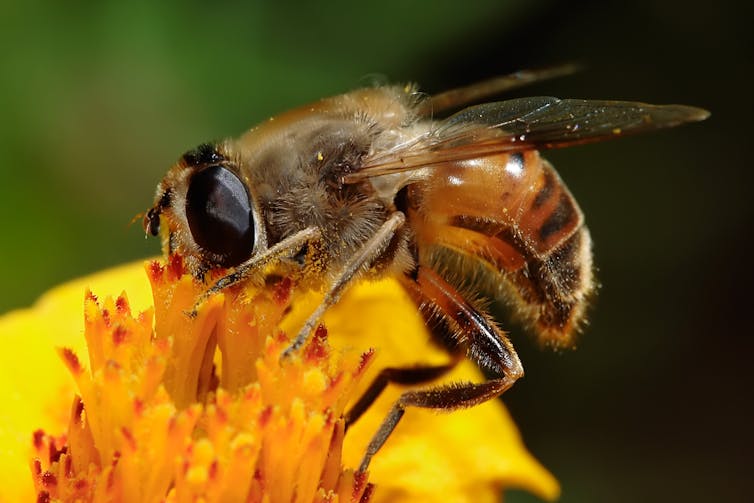
We all know the birds and the bees are important for pollination, and we often notice them in gardens and parks. But what about flies?
Flies are the second most common type of pollinator, so perhaps we should all be taught about the bees, the flies and then the birds. While we know animals may see colour differently, little was known about how fly pollination shapes the types of flowers we can find in nature.
In our new study we address this gap in our knowledge by evaluating how important fly pollinators sense and use colour, and how fly pollinated flowers have evolved colour signals.
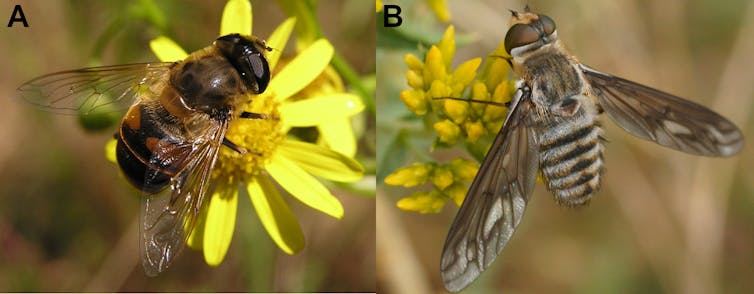
The Way We See Influences What We Choose
We know that different humans often have preferences for certain colours, and in a similar way bees prefer blue hues.
Our colleague Lea Hannah has observed that hoverflies (Eristalis tenax) are much better at distinguishing between different shades of yellow than between different blues. Other research has also reported hoverflies have innate responses to yellow colours.
Read more: The mystery of the blue flower: nature's rare colour owes its existence to bee vision
Many flowering plants depend on attracting pollinators to reproduce, so the appearance of their flowers has evolved to cater to the preferences of the pollinators. We wanted to find out what this might mean for how different insects like bees or flies shape flower colours in a complex natural environment where both types of insect are present.
The Australian Case Study
Australia is a natural laboratory for understanding flower evolution due to its geological isolation. On the mainland Australian continent, flowers have predominately evolved colours to suit animal pollination.
Around Australia there are plant communities with different pollinators. For example, Macquarie Island has no bees, and flies are the only animal pollinator.
We assembled data from different locations, including a native habitat in mainland Australia where both bees and flies forage, to model how different insects influence flower colour signal evolution.
Measuring Flower Colours
Since we know different animals sense colour in different ways, we recorded the spectrum of different wavelengths of light reflected from the flowers with a spectrometer. We subsequently modelled these spectral signatures of plant flowers considering animal perception, allowing us to objectively quantify how signals have evolved. These analyses included mapping the evolutionary ancestry of the plants.
Generalisation Or Specialisation?
According to one school of thought, flower evolution is driven by competition between flowering plants. In this scenario, different species might have very different colours from one another, to increase their chances of being reliably identified and pollinated. This is a bit like how exclusive brands seek customers by having readily identifiable branding.
An alternative hypothesis to competition is facilitation. Plants may share preferred colour signals to attract a higher number of specific insects. This explanation is like how some competing businesses can do better by being physically close together to attract many customers.
Read more: Plants use advertising-like strategies to attract bees with colour and scent
Our results demonstrate how flower colour signalling has dynamically evolved depending on the availability of insect pollinators, as happens in marketplaces.
In Victoria, flowers have converged to evolve colour signals preferred by their pollinators. The flowers of fly-pollinated orchids are typically yellowish-green, while closely related orchids pollinated by bees have more bluish and purple colours. The flowers appeared to share the preferred colours of their main pollinator, consistent with a facilitation hypothesis.
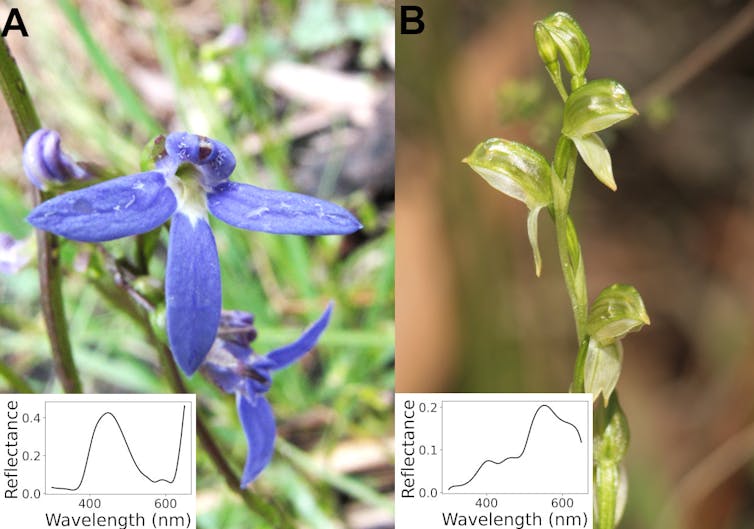
Our research showed flies can see differences between flowers of different species in response to the pollinator local “market”.
On Macquarie Island, where flies are the only pollinators, flower colours diverge from each other – but still stay within the range of the flies’ preferred colours. This is consistent with a competition strategy, where differences between plant species allow flies to more easily identify the colour of recently visited flowers.
When both fly and bee pollinators are present, flowers pollinated by flies appear to “filter out” bees to reduce the number of ineffective and opportunistic visitors. For example, in the Himalayas specialised plants require flies with long tongues to access floral rewards. This is similar to when a store wants to exclusively attract customers specifically interested in their product range.
Our findings on fly colour vision, along with novel precision agriculture techniques, can help using flies as alternative pollinators of crops. It also allows us to understand that if we want to see a full range of pollinating insects including beautiful hoverflies in our parks and gardens, we need to plant a range of flower types and colours.![]()
Jair Garcia, Research fellow, RMIT University; Adrian Dyer, Associate Professor, RMIT University, and Mani Shrestha, Postdoc & International Fellow, Disturbance Ecology, Bayreuth University
This article is republished from The Conversation under a Creative Commons license. Read the original article.
Australia’s coastal waters are rich in Indigenous cultural heritage, but it remains hidden and under threat
Jonathan Benjamin, Flinders University; Chelsea Wiseman, Flinders University; John McCarthy, Flinders University; Peter Jeffries, Indigenous Knowledge, and Sean Ulm, James Cook UniversityWhen people arrived in Australia more than 65,000 years ago, they landed on shores that are now deep under water. The first footprints on this continent took place on these now-submerged landscapes.
More than 2 million square kilometres of Australia’s continental landmass — an area larger than Queensland — was drowned by sea-level rise over the last 20,000 years. This land was once home to thousands of generations of Indigenous peoples.
Read more: Australia's coastal living is at risk from sea level rise, but it's happened before
Despite the scale of this vast drowned cultural landscape, Australia has fallen behind international best practice in locating, recording and protecting submerged Indigenous cultural places.
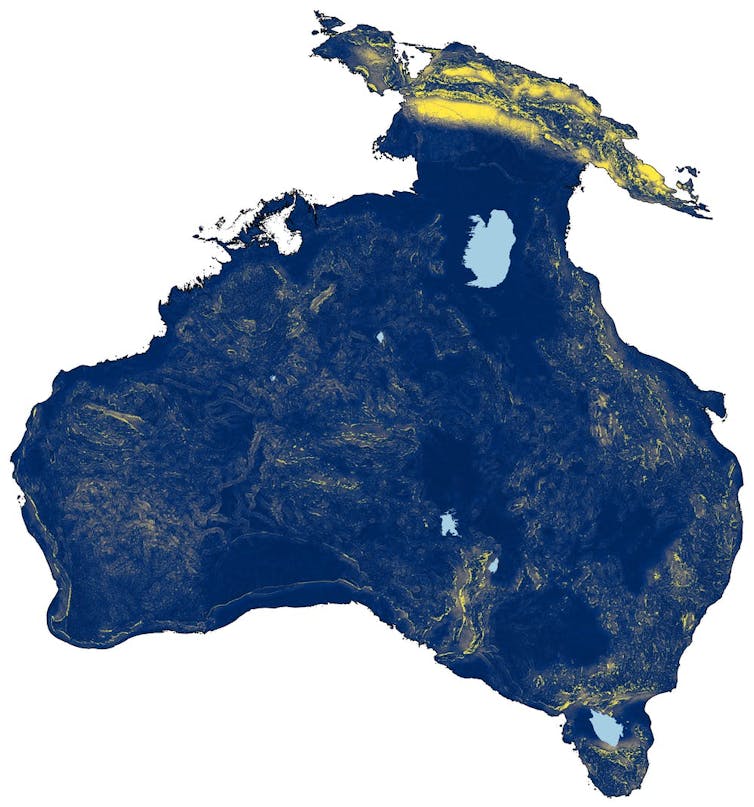
Last year, our team reported the discovery of nearly 300 stone artefacts submerged on the continental shelf off northwestern Australia.
This discovery demonstrated that submerged Indigenous sites are likely to exist around the continent, but remain unknown due to a lack of investigation.
The Big Picture And The Local Scale
In two new studies published in Australian Archaeology, we outline approaches to help us better understand and manage Indigenous underwater cultural heritage.
Through a two-pronged approach at both the local and regional level, we review big data to predict the location of sites. We also put boots on the ground and divers in the water to find and record them.
At the local level, our research at Murujuga in northwest Australia indicates we must combine archaeological data from above and below the water to understand the past landscape at periods of lower sea level.
Drawing on evidence from across terrestrial, coastal and submerged environments, we found archaeological material in all three zones.
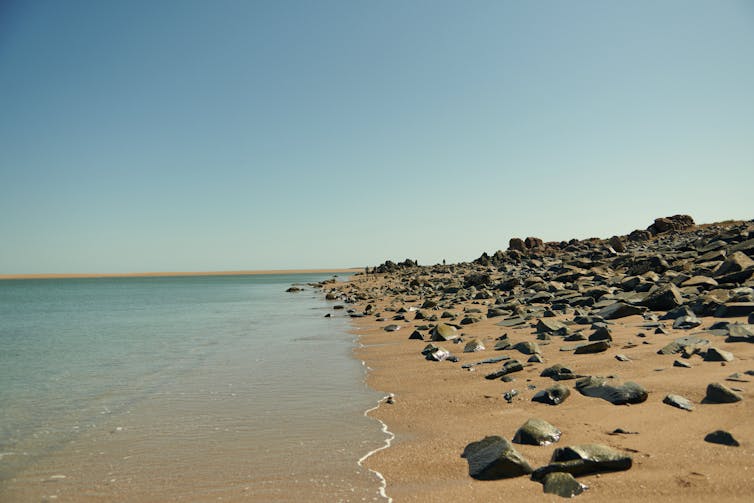
Our study also aligns archaeological practice with histories of Indigenous Australians, who describe cultural landscapes extending into Sea Country. Some oral histories describe past sea-level rise and drowned cultural landscapes.
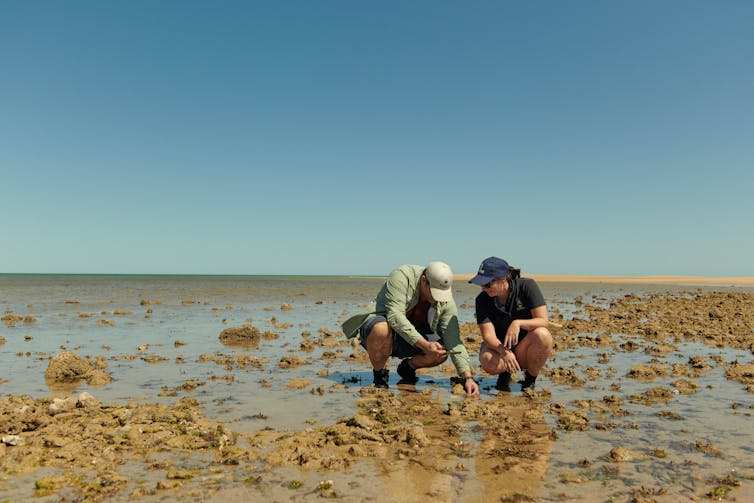
At the regional scale, our study shows how research into submerged landscapes can be expanded across Australia. Taking the Northern Territory as a case study, we assessed the potential for archaeological material to be preserved on the seabed.
National environmental frameworks, such as Marine bioregional plans for Australia’s seabed focus largely on marine biodiversity and habitats, only acknowledging archaeology through a selection of historic shipwrecks.
With few regional or state-level mechanisms in place to inform marine management planning, Indigenous underwater cultural heritage has been ignored or marginalised. There is now an opportunity and an ethical obligation to integrate Indigenous perspectives and traditional knowledge into marine science research.
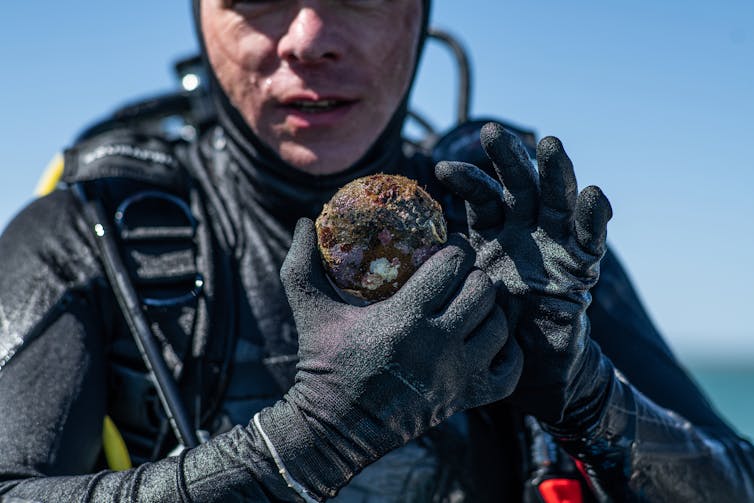
Threats To Underwater Indigenous Heritage
Indigenous underwater cultural heritage is threatened by a variety of activities, including dredging, offshore cables and pipelines, seabed mining, and oil and gas exploration.
Such developments can cause significant damage and even explosions and fires in the sea, as witnessed recently in the Gulf of Mexico.
We can expect increased pressure on coastal and submerged sites with the increasing impacts of climate change. Without mechanisms to consider the archaeology in the intertidal zone of Australia (the transitional area between land and sea) and the seabed, such disturbances will occur out of sight and out of mind.
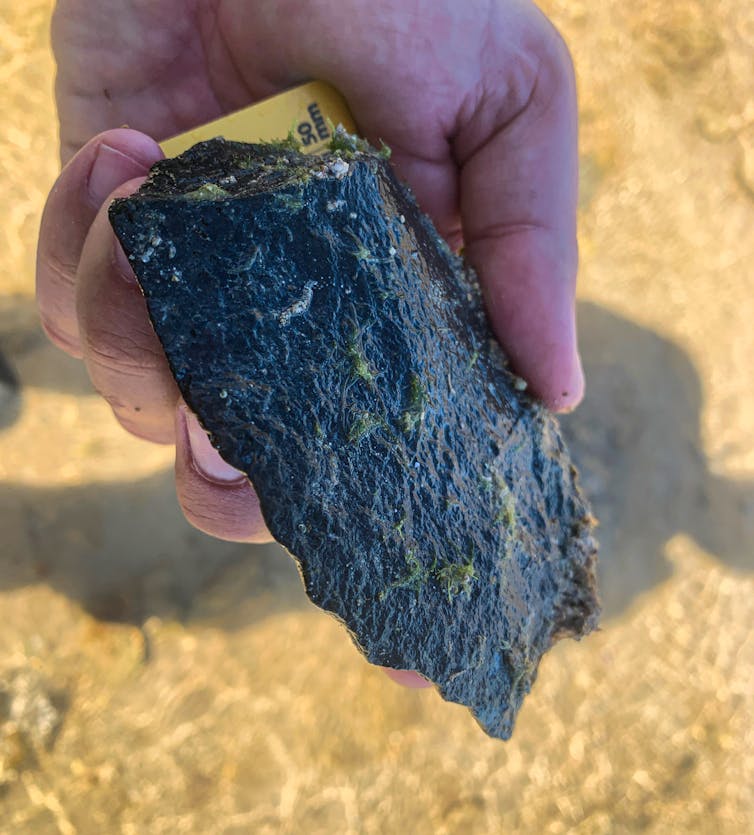
Some state and local laws protect underwater cultural heritage, but these vary across the country. The national Underwater Cultural Heritage Act also does not adequately protect Indigenous cultural heritage.
The UNESCO Convention on the Protection of the Underwater Cultural Heritage protects all heritage greater than 100 years old, including both colonial-era sites and Indigenous underwater cultural heritage. But Australia’s national policy currently does not align with the convention.
Our Systems Must Change
Archaeologists working in partnership with Indigenous communities must take a central role in scientific research, management of marine environments and industry-led campaigns, incorporating archaeology into environmental impact assessments.
Industry has begun to respond. One company, Woodside Energy, for example, has acknowledged the importance of this issue, and has engaged with the Murujuga Aboriginal Corporation. The company says it has
sought to understand the potential heritage values of the submerged cultural landscape for the proposed Scarborough pipeline.
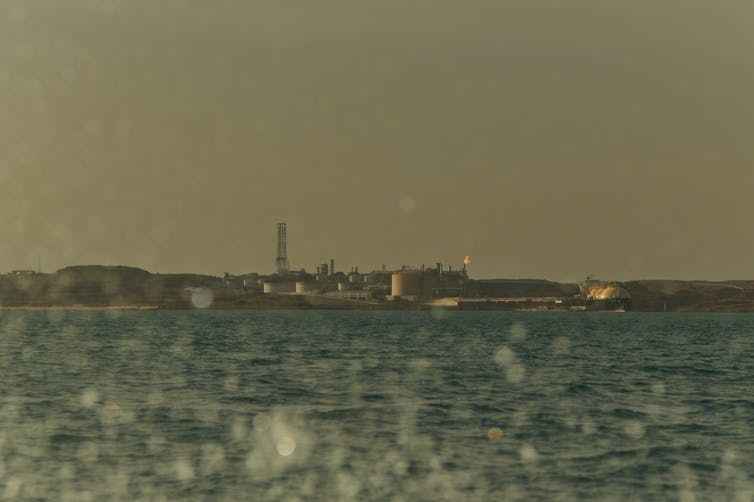
This is a new paradigm for the offshore sector in Australia and a sign of things to come as industry and policy-makers respond to scientific advances and new knowledge.
Coastal peoples all over the world have made a significant contribution to human history. Only through underwater archaeology can we fully understand these past peoples who called coastal environments their home.![]()
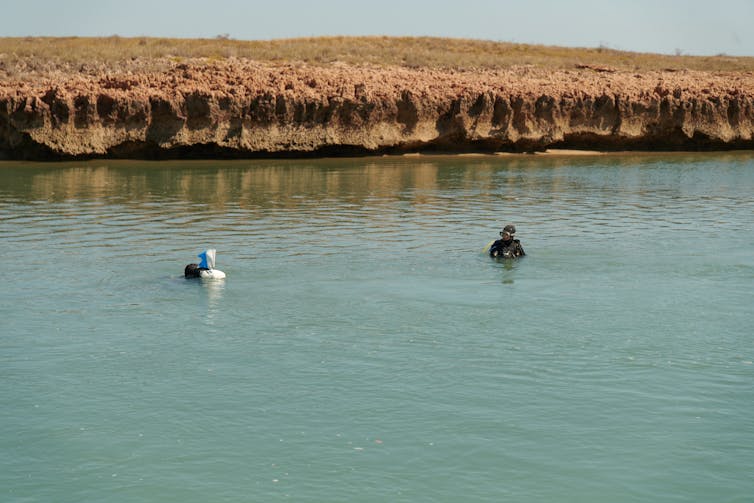
Jonathan Benjamin, Associate Professor in Maritime Archaeology, Flinders University and ARC Centre of Excellence for Australian Biodiversity and Heritage, Flinders University; Chelsea Wiseman, PhD Candidate, Flinders University; John McCarthy, ARC DECRA Fellow, Flinders University; Peter Jeffries, CEO of Murujuga Aboriginal Corporation, Indigenous Knowledge, and Sean Ulm, Deputy Director, ARC Centre of Excellence for Australian Biodiversity and Heritage, James Cook University
This article is republished from The Conversation under a Creative Commons license. Read the original article.
Decaying forest wood releases a whopping 10.9 billion tonnes of carbon each year. This will increase under climate change
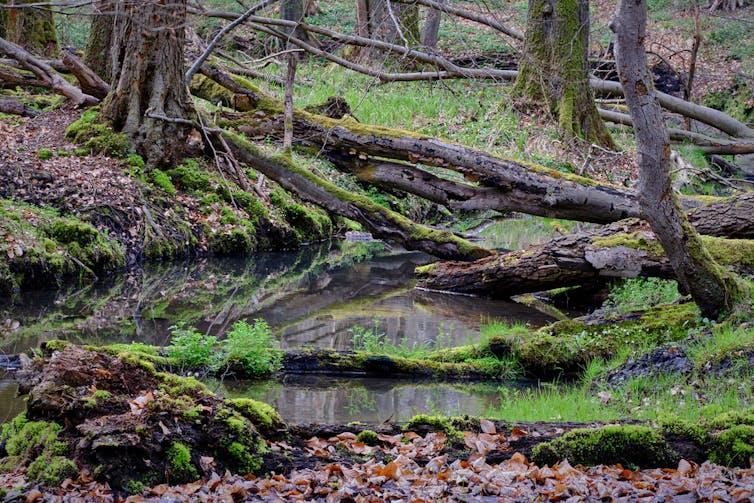
If you’ve wandered through a forest, you’ve probably dodged dead, rotting branches or stumps scattered on the ground. This is “deadwood”, and it plays several vital roles in forest ecosystems.
It provides habitat for small mammals, birds, amphibians and insects. And as deadwood decomposes it contributes to the ecosystem’s cycle of nutrients, which is important for plant growth.
But there’s another important role we have little understanding of on a global scale: the carbon deadwood releases as it decomposes, with part of it going into the soil and part into the atmosphere. Insects, such as termites and wood borers, can accelerate this process.
The world’s deadwood currently stores 73 billion tonnes of carbon. Our new research in Nature has, for the first time, calculated that 10.9 billion tonnes of this (around 15%) is released into the atmosphere and soil each year — a little more than the world’s emissions from burning fossil fuels.
But this amount can change depending on insect activity, and will likely increase under climate change. It’s vital deadwood is considered explicitly in all future climate change projections.
An Extraordinary, Global Effort
Forests are crucial carbon sinks, where living trees capture and store carbon dioxide from the atmosphere, helping to regulate climate. Deadwood — including fallen or still-standing trees, branches and stumps — makes up 8% of this carbon stock in the world’s forests.
Our aim was to measure the influence of climate and insects on the rate of decomposition — but it wasn’t easy. Our research paper is the result of an extraordinary effort to co-ordinate a large-scale cross-continent field experiment. More than 30 research groups worldwide took part.
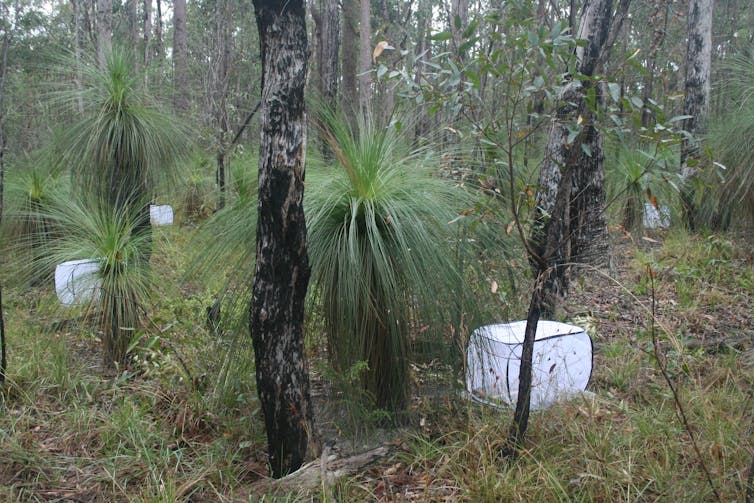
Wood from more than 140 tree species was laid out for up to three years at 55 forest sites on six continents, from the Amazon rainforest to Brisbane, Australia. Half of these wood samples were in closed mesh cages to exclude insects from the decomposition process to test their effect, too.
Some sites had to be protected from elephants, another was lost to fire and another had to be rebuilt after a flood.
What We Found
Our research showed the rate of deadwood decay and how insects contribute to it depend very strongly on climate.
We found the rate increased primarily with rising temperature, and was disproportionately greater in the tropics compared to all other cooler climatic regions.
In fact, deadwood in tropical regions lost a median mass of 28.2% every year. In cooler, temperate regions, the median mass lost was just 6.3%.
More deadwood decay occurs in the tropics because the region has greater biodiversity (more insects and fungi) to facilitate decomposition. As insects consume the wood, they render it to small particles, which speed up decay. The insects also introduce fungal species, which then finish the job.
Read more: Wood beetles are nature's recyclers – with a little help from fungi
Of the 10.9 billion tonnes of carbon dioxide released by deadwood each year, we estimate insect activity is responsible for 3.2 billion tonnes, or 29%.
Let’s break this down by region. In the tropics, insects were responsible for almost one-third of the carbon released from deadwood. In regions with low temperatures in forests of northern and temperate latitudes — such as in Canada and Finland — insects had little effect.
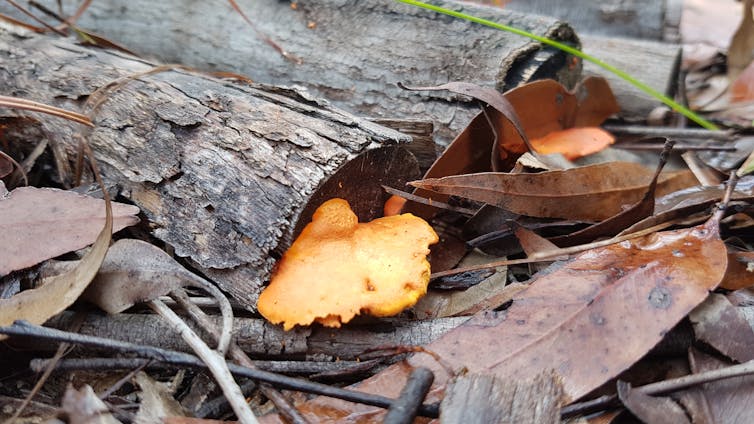
What Does This Mean In A Changing Climate?
Insects are sensitive to climate change and, with recent declines in insect biodiversity, the current and future roles of insects in deadwood are uncertain.
But given the vast majority of deadwood decay occurs in the tropics (93%), and that this region in general is set to become even warmer and wetter under climate change, it’s safe to say climate change will increase the amount of carbon deadwood releases each year.
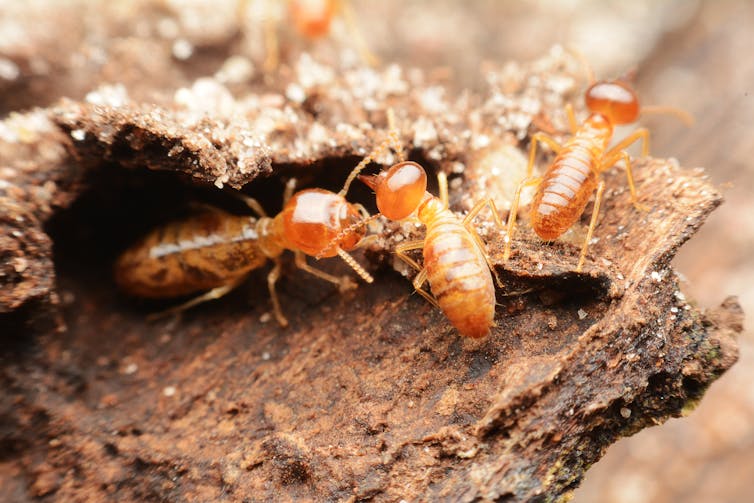
It’s also worth bearing in mind that the amount of carbon dioxide released is still only a fraction of the total annual global deadwood carbon stock. That is, 85% of the global deadwood carbon stock remains on forest floors and continues to store carbon each year.
We recommend deadwood is left in place — in the forest. Removing deadwood may not only be destructive for biodiversity and the ability of forests to regenerate, but it could actually substantially increase atmospheric carbon.
Read more: Photos from the field: zooming in on Australia's hidden world of exquisite mites, snails and beetles
For example, if we used deadwood as a biofuel it could release the carbon that would otherwise have remained locked up each year. If the world’s deadwood was removed and burned, it would be release eight times more carbon than what’s currently emitted from burning fossil fuels.
This is particularly important in cooler climatic regions, where decomposition is slower and deadwood remains for several years as a vital carbon sink.
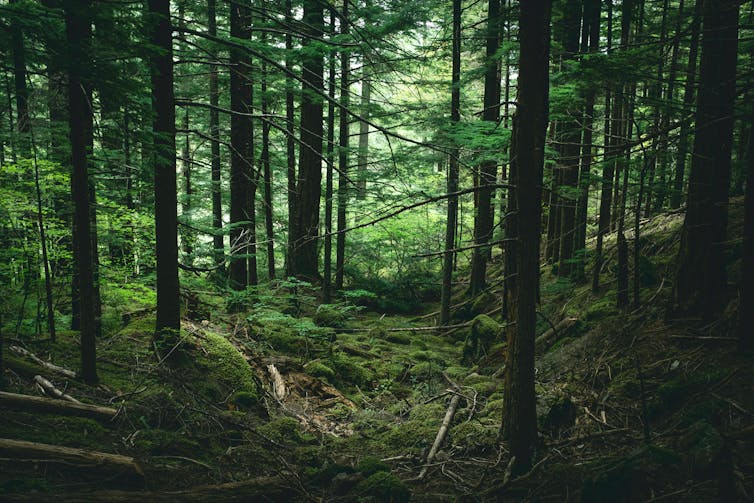
What Next?
The complex interplay of interactions between insects and climate on deadwood carbon release makes future climate projections a bit tricky.
To improve climate change predictions, we need much more detailed research on how communities of decomposer insects (such as the numbers of individuals and species) influence deadwood decomposition, not to mention potential effects from insect diversity loss.
But insect diversity loss is also likely to vary regionally and would require long-term studies over decades to determine.
For now, climate scientists must take the enormous annual emissions from deadwood into account in their research, so humanity can have a better understanding of climate change’s cascading effects.
Read more: Trees can't save us from climate change – but society will always depend on forests – podcast ![]()
Marisa Stone, Adjunct Research Fellow, Centre for Planetary Health and Food Security, Griffith University; David Lindenmayer, Professor, The Fenner School of Environment and Society, Australian National University; Kurtis Nisbet, Scientific Officer, Griffith University, and Sebastian Seibold, Adjunct Teaching Professor, Technical University of Munich
This article is republished from The Conversation under a Creative Commons license. Read the original article.
1,600 years ago, climate change hit the Australian Alps. We studied ancient lake mud to learn what happened
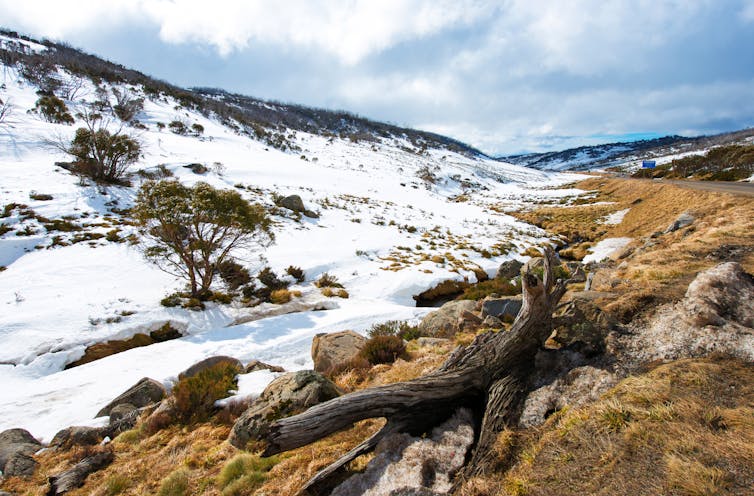
If you’ve ever visited Australia’s highest peak — Mount Kosciuszko — you might remember the long uphill trek to the summit past some of Australia’s most picturesque and rugged landscapes. Vibrant snow gums, boardwalks with meadows of exquisite alpine plants, and blinding patches of snow.
As you approach the summit, a quartet of stunning blue lakes appear, created by glaciers during the last ice age that carved new valleys out of the mountain.
Lakes like these are windows to the past, offering an opportunity to understand how our climate and environment has changed over hundreds to thousands of years. One such lake, Club Lake — so-named for its resemblance to a suit in a deck of cards — was the focus of our new study.
After studying the lake’s sediment, we learned the Australian Alps experienced a sudden climate change about 1,600 years ago that brought a long spell of warmer conditions. What makes this sudden warming event particularly interesting is that it bears striking similarity to today.
Climate Change In The Australian Alps
The Australian alpine region is the traditional home of a number of Aboriginal groups, including the Ngarigo, Walgalu and Djilamatang people. It is also home to highly diverse flora and fauna that occur nowhere else, from billy buttons (Craspedia costiniana) known for their vibrant yellow rosette of tiny flowers, to the broad-toothed rat and its chubby cheeks.
But this unique wildlife is under immense threat from climate change.
By 2100, Australia may warm by at least 4℃, with bushfires becoming more frequent and devastating. The fragile alpine ecosystem will be hit particularly hard by these changes.
Read more: Meet the broad-toothed rat: a chubby-cheeked and inquisitive Australian rodent that needs our help
Many of Australia’s alpine species are already near their climatic limits, and are constrained by altitude. They’re at risk of becoming regionally extinct if their climatic thresholds are exceeded. As the temperature warms, treelines move upslope to cooler temperatures, pushing alpine flora and fauna to higher elevations. At some point they can go no higher — they’re squeezed out of their niche.
The critically endangered mountain pygmy-possum, for example, relies on the seasonal snowpack for winter hibernation, but increased temperatures are limiting this habitat.
A Dip Into The Past
Our study showed Club Lake holds vital clues to the link between rising temperatures, loss of native plant species and more frequent fires in the Snowy Mountains.
Lake sediments are used all over the world as indicators of climate and environmental change because of the unique way they trap material. A body of water can act as a seal that ensures sediments are largely undisturbed over time.
We extracted sediments from the bottom of Club Lake to a depth of 35 centimetres. This equates to about 3,500 years of history, approximately 100 years for each centimetre.
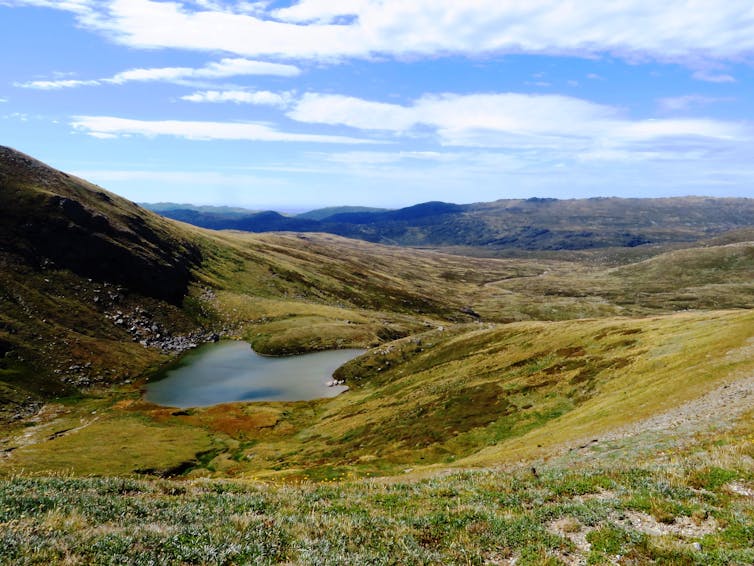
To work out how temperatures have changed over this time, we looked for the presence of molecular fossils, called “lipid biomarkers”. Analysing these biomarkers in the laboratory can tell us what the temperature in the environment was like, hundreds or thousands of years ago.
In the 3,500 years we examined, we detected a gradual warming trend. Superimposed on this, we found a sudden warming event that started 1,600 years ago, and lasted about six centuries. We suspect it was due to an atmospheric phenomenon linking higher tropical sea surface temperatures to southeastern Australia.
We’re not yet sure how much of Australia was affected by this warming, but other research from 2018 measured similar temperature changes in stalagmites from the Yarrangobilly caves 50 kilometres away.
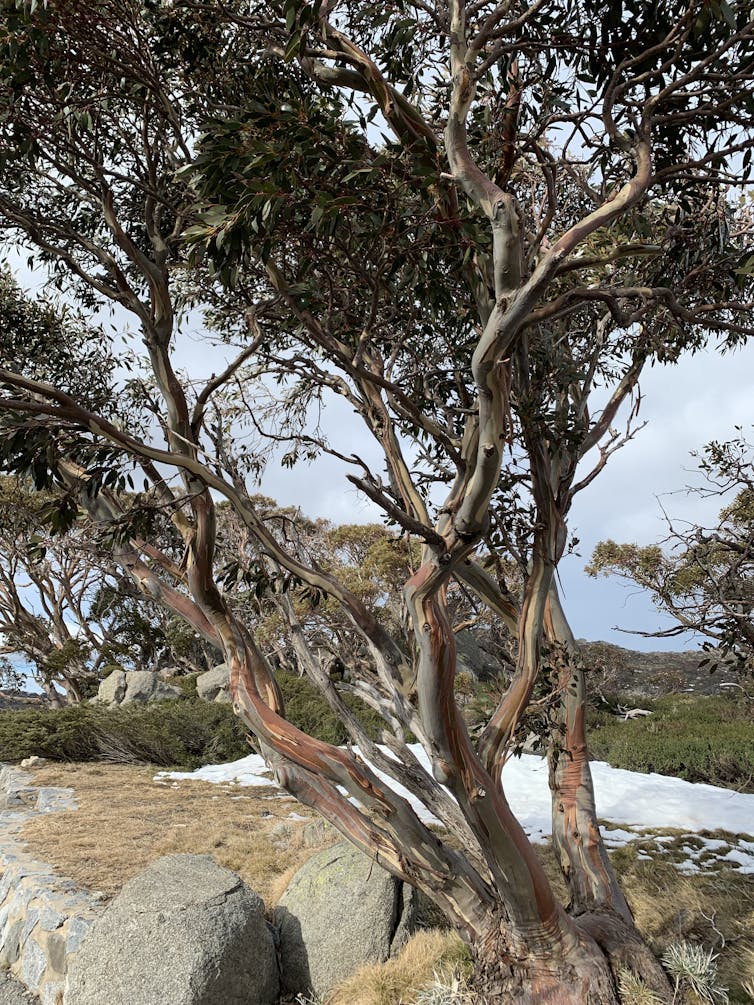
What Happened During This Climate Change?
During this unusual warmth, alpine herbs and shrubs declined, while the abundance of trees, particularly eucalyptus, increased. We know this by looking at grains of pollen preserved at different depths within the lake sediment samples, which indicates what types of plants were growing nearby.
We also found small particles of charcoal, produced by bushfires, embedded within the sediment layers. This showed the changes in vegetation also coincided with greater fire activity.
What surprised us most, however, was discovering a large increase in mercury at this time.
Mercury, which occurs naturally in the environment, is the only metal that’s liquid at room temperature, and is particularly sensitive to temperature changes. Higher temperatures enhance mercury deposition from the atmosphere, and our study shows a five-fold increase in mercury flux 1,600 years ago.

Industrial activities over the last 150 years, such as burning coal, have increased the abundance of mercury significantly. Our findings suggest future climate change is likely to increase the risk of mercury exposure not just in cities, but also in the seemingly remote Australian alpine environment.
Mercury contamination is a significant public health and environmental problem. At certain levels it’s poisonous to the nervous system, and it does not easily degrade.
What Can We Do?
Insights from the past can help governments, environmental agencies, and scientists come up with effective strategies to protect the vulnerable flora and fauna of the Australian Alps. But it’s not just changes in climate they’ll have to contend with in future.
There are other perils, such as soil erosion and habitat fragmentation from the legacy of sheep and cattle grazing, and tourism. Invasive pests and pathogens are likely to further reduce the resilience of these alpine ecosystems.

Restoration programs over the last 50 years have aimed to revitalise the natural vegetation in the Kosciuszko National Park following 135 years of grazing — finally banned in 1969 — and the environmental damage caused by the Snowy River Hydro-Electric scheme.
More recently, the federal government has committed A$3.5 million towards recovery from the devastating 2019-2020 bushfires. Incorporating Aboriginal knowledge into mainstream fire management is essential for tackling future crises.
This is the critical time for climate action to protect this unique and iconic Australian landscape.
Read more: Double trouble as feral horse numbers gallop past 25,000 in the Australian Alps ![]()
Zoë Thomas, ARC DECRA Fellow, UNSW; Haidee Cadd, Research associate, University of Wollongong, and Larissa Schneider, DECRA fellow, Australian National University
This article is republished from The Conversation under a Creative Commons license. Read the original article.
Bushcare In Pittwater
Where we work Which day What time
Avalon
Angophora Reserve 3rd Sunday 8:30 - 11:30am
Avalon Dunes 1st Sunday 8:30 - 11:30am
Avalon Golf Course 2nd Wednesday 3 - 5:30pm
Careel Creek 4th Saturday 8:30 - 11:30am
Toongari Reserve 3rd Saturday 9 - 12noon (8 - 11am in summer)
Bangalley Headland 2nd Sunday 9 to 12noon
Bayview
Winnererremy Bay 4th Sunday 9 to 12noon
Bilgola
North Bilgola Beach 3rd Monday 9 - 12noon
Algona Reserve 1st Saturday 9 - 12noon
Plateau Park 1st Friday 8:30 - 11:30am
Church Point
Browns Bay Reserve 1st Tuesday 9 - 12noon
McCarrs Creek Reserve Contact Bushcare Officer To be confirmed
Clareville
Old Wharf Reserve 3rd Saturday 8 - 11am
Elanora
Kundibah Reserve 4th Sunday 8:30 - 11:30am
 Mona Vale
Mona Vale Mona Vale Beach Basin 1st Saturday 8 - 11am
Mona Vale Dunes 2nd Saturday +3rd Thursday 8:30 - 11:30am
Newport
Bungan Beach 4th Sunday 9 - 12noon
Crescent Reserve 3rd Sunday 9 - 12noon
North Newport Beach 4th Saturday 8:30 - 11:30am
Porter Reserve 2nd Saturday 8 - 11am
North Narrabeen
Irrawong Reserve 2nd Saturday 2 - 5pm
Palm Beach
North Palm Beach Dunes 3rd Saturday 9 - 12noon
Scotland Island
Catherine Park 2nd Sunday 10 - 12:30pm
Elizabeth Park 1st Saturday 9 - 12noon
Pathilda Reserve 3rd Saturday 9 - 12noon
Warriewood
Warriewood Wetlands 1st Sunday 8:30 - 11:30am
Whale Beach
Norma Park 1st Friday 9 - 12noon
Western Foreshores
Coopers Point, Elvina Bay 2nd Sunday 10 - 1pm
Rocky Point, Elvina Bay 1st Monday 9 - 12noon
Gardens And Environment Groups And Organisations In Pittwater
Avalon Golf Course Bushcare Needs You
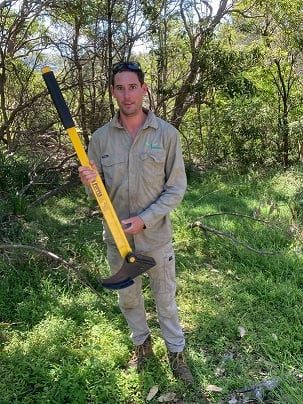
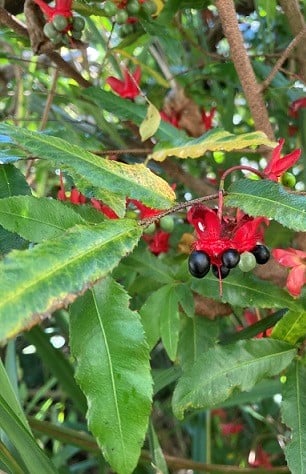
Pittwater Reserves

New Shorebirds WingThing For Youngsters Available To Download
A Shorebirds WingThing educational brochure for kids (A5) helps children learn about shorebirds, their life and journey. The 2021 revised brochure version was published in February 2021 and is available now. You can download a file copy here.
If you would like a free print copy of this brochure, please send a self-addressed envelope with A$1.10 postage (or larger if you would like it unfolded) affixed to: BirdLife Australia, Shorebird WingThing Request, 2-05Shorebird WingThing/60 Leicester St, Carlton VIC 3053.

 Shorebird Identification Booklet
Shorebird Identification Booklet
The Migratory Shorebird Program has just released the third edition of its hugely popular Shorebird Identification Booklet. The team has thoroughly revised and updated this pocket-sized companion for all shorebird counters and interested birders, with lots of useful information on our most common shorebirds, key identification features, sighting distribution maps and short articles on some of BirdLife’s shorebird activities.
The booklet can be downloaded here in PDF file format: http://www.birdlife.org.au/documents/Shorebird_ID_Booklet_V3.pdf
Paper copies can be ordered as well, see http://www.birdlife.org.au/projects/shorebirds-2020/counter-resources for details.
Download BirdLife Australia's children’s education kit to help them learn more about our wading birdlife
Shorebirds are a group of wading birds that can be found feeding on swamps, tidal mudflats, estuaries, beaches and open country. For many people, shorebirds are just those brown birds feeding a long way out on the mud but they are actually a remarkably diverse collection of birds including stilts, sandpipers, snipe, curlews, godwits, plovers and oystercatchers. Each species is superbly adapted to suit its preferred habitat. The Red-necked Stint is as small as a sparrow, with relatively short legs and bill that it pecks food from the surface of the mud with, whereas the Eastern Curlew is over two feet long with a exceptionally long legs and a massively curved beak that it thrusts deep down into the mud to pull out crabs, worms and other creatures hidden below the surface.
Some shorebirds are fairly drab in plumage, especially when they are visiting Australia in their non-breeding season, but when they migrate to their Arctic nesting grounds, they develop a vibrant flush of bright colours to attract a mate. We have 37 types of shorebirds that annually migrate to Australia on some of the most lengthy and arduous journeys in the animal kingdom, but there are also 18 shorebirds that call Australia home all year round.
What all our shorebirds have in common—be they large or small, seasoned traveller or homebody, brightly coloured or in muted tones—is that each species needs adequate safe areas where they can successfully feed and breed.
The National Shorebird Monitoring Program is managed and supported by BirdLife Australia.
This project is supported by Glenelg Hopkins Catchment Management Authority and Hunter Local Land Services through funding from the Australian Government’s National Landcare Program. Funding from Helen Macpherson Smith Trust and Port Phillip Bay Fund is acknowledged.
The National Shorebird Monitoring Program is made possible with the help of over 1,600 volunteers working in coastal and inland habitats all over Australia.
The National Shorebird Monitoring program (started as the Shorebirds 2020 project initiated to re-invigorate monitoring around Australia) is raising awareness of how incredible shorebirds are, and actively engaging the community to participate in gathering information needed to conserve shorebirds.
In the short term, the destruction of tidal ecosystems will need to be stopped, and our program is designed to strengthen the case for protecting these important habitats.
In the long term, there will be a need to mitigate against the likely effects of climate change on a species that travels across the entire range of latitudes where impacts are likely.
The identification and protection of critical areas for shorebirds will need to continue in order to guard against the potential threats associated with habitats in close proximity to nearly half the human population.
Here in Australia, the place where these birds grow up and spend most of their lives, continued monitoring is necessary to inform the best management practice to maintain shorebird populations.
BirdLife Australia believe that we can help secure a brighter future for these remarkable birds by educating stakeholders, gathering information on how and why shorebird populations are changing, and working to grow the community of people who care about shorebirds.
To find out more visit: http://www.birdlife.org.au/projects/shorebirds-2020/shorebirds-2020-program
Aussie Bread Tags Collection Points

From June 1971:
From July 31, 1988:
Turimetta Rocks!
Photo taken by Joe Mills this week
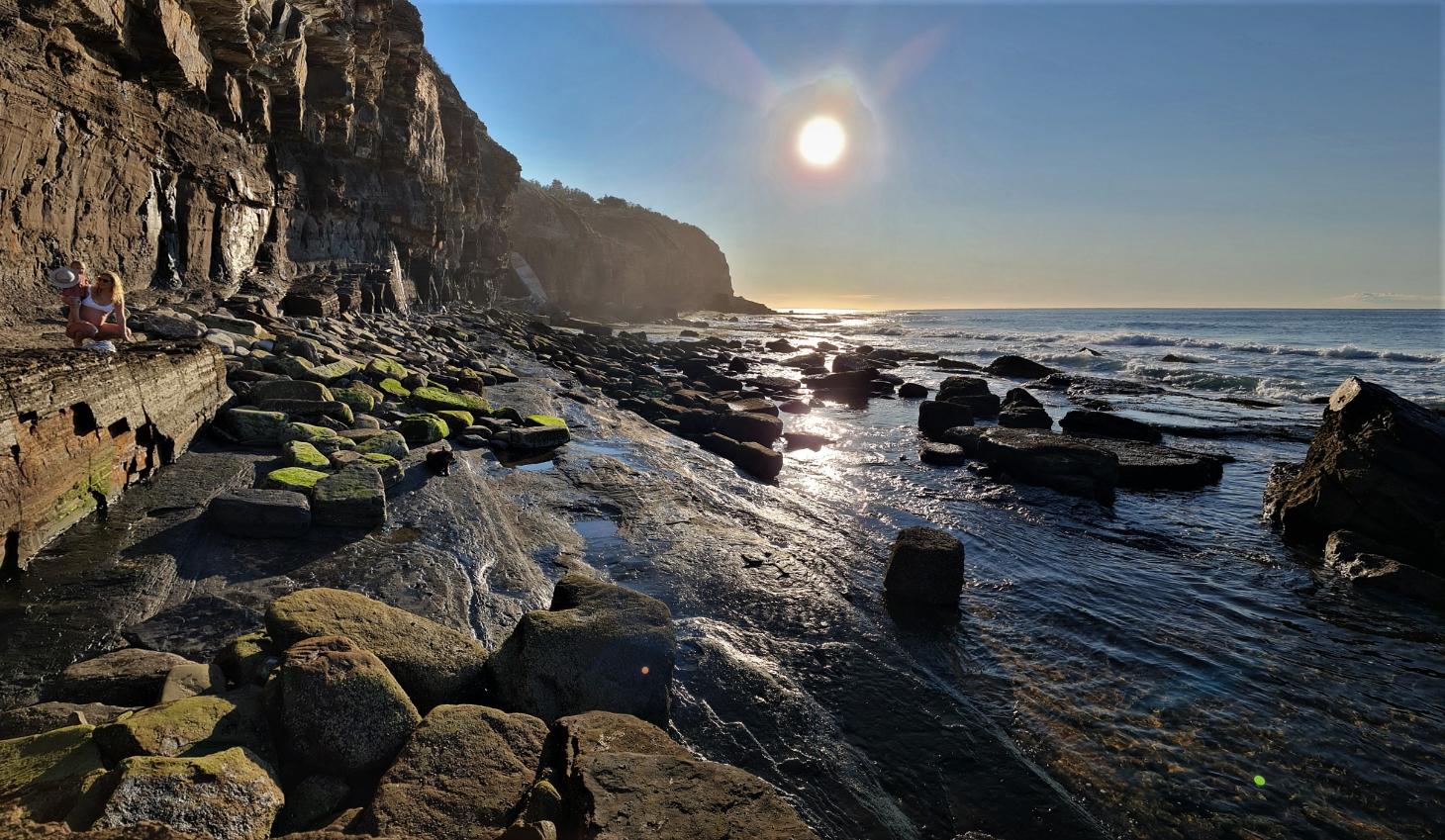
After Dark Photo Competition: Northern Beaches
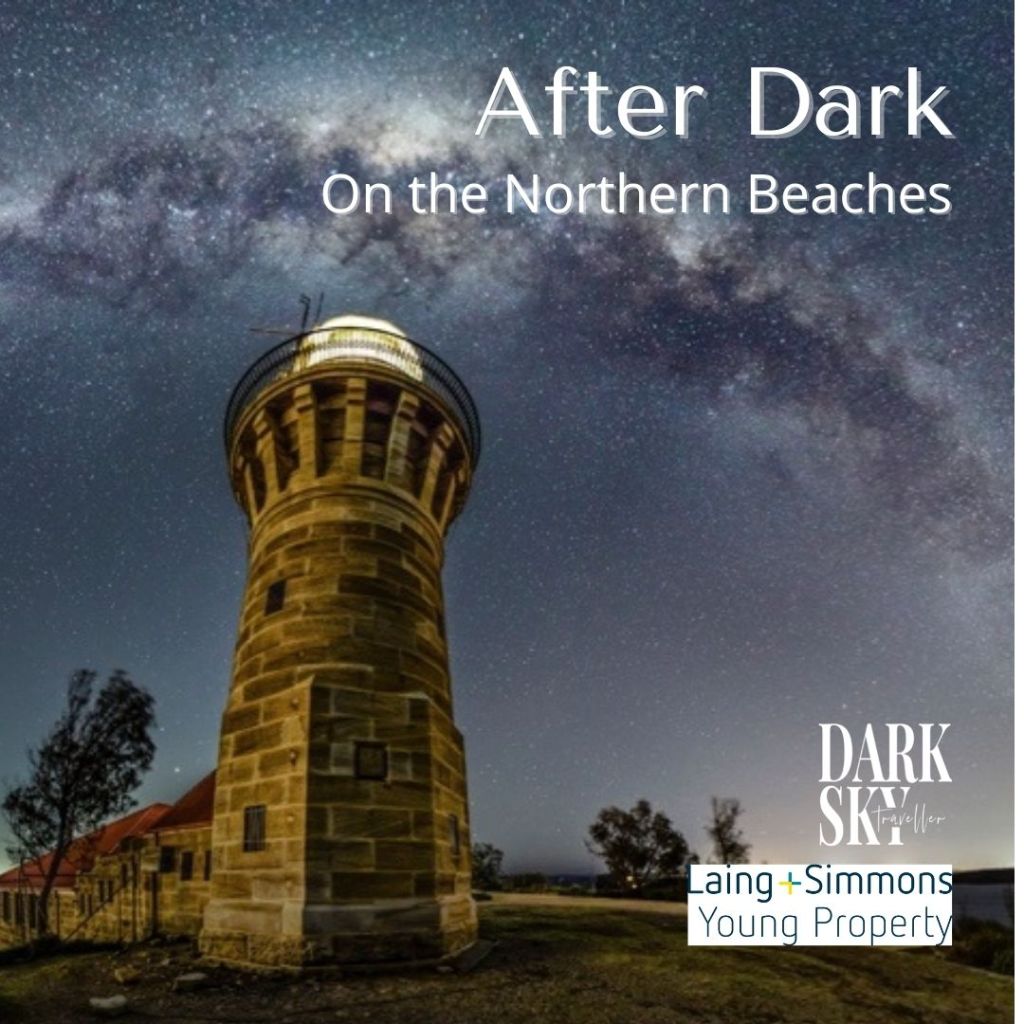 The Northern Beaches are one of the best places in Sydney to view the night sky and appreciate this wonderful asset.
The Northern Beaches are one of the best places in Sydney to view the night sky and appreciate this wonderful asset.Details
- Land – manmade and/or natural formations, wildlife, flora or fauna
- Sea – waterways, beaches, or marine areas, sea life
- Sky – aspects of the night sky, moon, starscapes, clouds or wildlife
- Junior – under 16 years featuring any one of these categories.
- Entry fees are $10 for the first category entered and $10 for each subsequent category entered.
- Up to six entries per category are permitted.
- Fees should be paid by the PayPal gateway on the entry website. Credit and debit cards can be used on this gateway.
- If entry payments are not received by the deadline, then the submitted entries will not be accepted for judging.
- Entries will be accepted only from Australian residents of the Commonwealth of Australia and its Territories.
- There will be two sections of entry – General and Junior (18 or younger)
- There will be three categories of entry for the General Section; Portraying the night time environment featuring Land, Sea or Sky.
- The Junior Section is for photographers 18 years old or younger and will have one open category.
- All entries must be taken within the Northern Beaches LGA and must be taken between sunset and sunrise.
- Images can be taken at any time of the year on or after 1 September 2019.
- The top 5 images of each category will be judged by the organising committee and will be hung at the Studio, Careel Bay Marina for general public display.
- Photographers represented in the top 5 images of each category will be notified that they are in the top 20 images (15 September 17:00 AEST).
- There is a limit of six (6) entries per category per photographer.
- In the case of images with multiple authors, the instigator of the image will be considered to be the principal author and the one who “owns” the image. The principal author MUST have performed the majority of the work to produce the image. All authors MUST be identified and named in the entry form along with their contributions to the production of the image.
- Entries must be in digital form and will be accepted ONLY through submission via the dedicated website at: afterdark.myphotoclub.com.au
- To preserve anonymity, the submitted image files should not contain identifying metadata.
- For judging purposes, still images must be submitted as JPG files with the longest side having a dimension no greater than 4,950 pixels in Adobe 1998 colour space.
- All photographs must have been taken no more than 2 years before the closing date of entry.
- Entry fees are $20 for the first entry and $10 each subsequent entry. Fees should be paid by the PayPal gateway on the entry website. Credit and debit cards can be used on this gateway.
- If entry payments are not received by the deadline, then the submitted entries will not be accepted for judging.
- Photographers of the top 20 images (5 in each category) will be notified 15 September and images printed, framed and hung by the organising. Artists may choose to pay $55 for this service to be undertaken on their part or undertake printing and framing at their own cost. Images must be ready for hanging 17:00 (AEST) 29 September 2021.
- Images will be listed on sale during the exhibition at the artist’s discretion. $100 of the sale will be donated to the charity the Australasian Dark Sky Alliance.
- Winners for the Land Scape, Sea Scape, Sky Scape and Youth entry will be announced Thursday 30th September 2021.
- People’s choice will confirmed by popular vote throughout the exhibition and will be announced on Saturday 30 October, 2021.
- Submissions close at 24:00 (AEST) on Wednesday, 1 September 2021. No entries will be accepted past this date.
- All winners should make an effort to attend the presentation of the awards on 30 September 2021
- The winning entries will be exhibited for the entire Exhibition After Dark, at the Studio, Careel Bay Marina between 30 September and 2 November, 2021.
- Permission to reproduce entries for publication to promote the competition and exhibitions and dark sky-related events and activities on the northern beaches will be assumed as a condition of entry. The copyright of the image remains with the author, and we will try to ensure that the author is credited where the image is used.
- All entries must be true images, faithfully reflecting and maintaining the integrity of the subject. Entries made up of composite images taken at different times and/or at different locations and/or with different cameras will not be accepted. Image manipulations that produce works that are more “digital art” than true astronomical images, will be deemed ineligible. If there is any doubt about the acceptability of an entry, then the competition organisers should be contacted, before the entry is submitted, for adjudication on the matter at the following email address: marnie@darkskytraveller.com.au
- If after the judging process, an image is subsequently determined to have violated the letter and/or the spirit of the rules, then that image will be disqualified. Any prizes consequently awarded for that image must be returned to the competition organisers.
- The competition judges reserve the right to reject any entry that, in the opinion of the judges, does not meet the conditions of entry or is unsuitable for public display. The judges’ decisions will be final.
- Submission of an entry implies acceptance of all the conditions of entry and the decisions of the competition judges.
- Entries Open: 24:00 (AEST) Sunday, 11 July 2021
- Entries Close: 24:00 (AEST) Wednesday, 1 September 2021
- Top 20 announced: 17:00 Wednesday, 15 September 2021
- Photography bump in: Midday Wednesday 29 September 2021
- Exhibition Launch and Presentation of Awards: Thursday 30 September 2021
- Bump out – 2 November 2021
- Category Winner: An image deemed to be the best in that category as judged by the judging panel.
- “The People’s Choice”: This will be judged by gathering votes obtained in the exhibition venue, and online.
- Category Winner: $200 – to each of the image deemed to be the best in each of the four (4) category.
- “The People’s Choice”: $200 – will be judged by gathering votes obtained in the exhibition venue, and online.
Father's Day 2021: A Short Insight Into Dad's Day Being Established In Australia
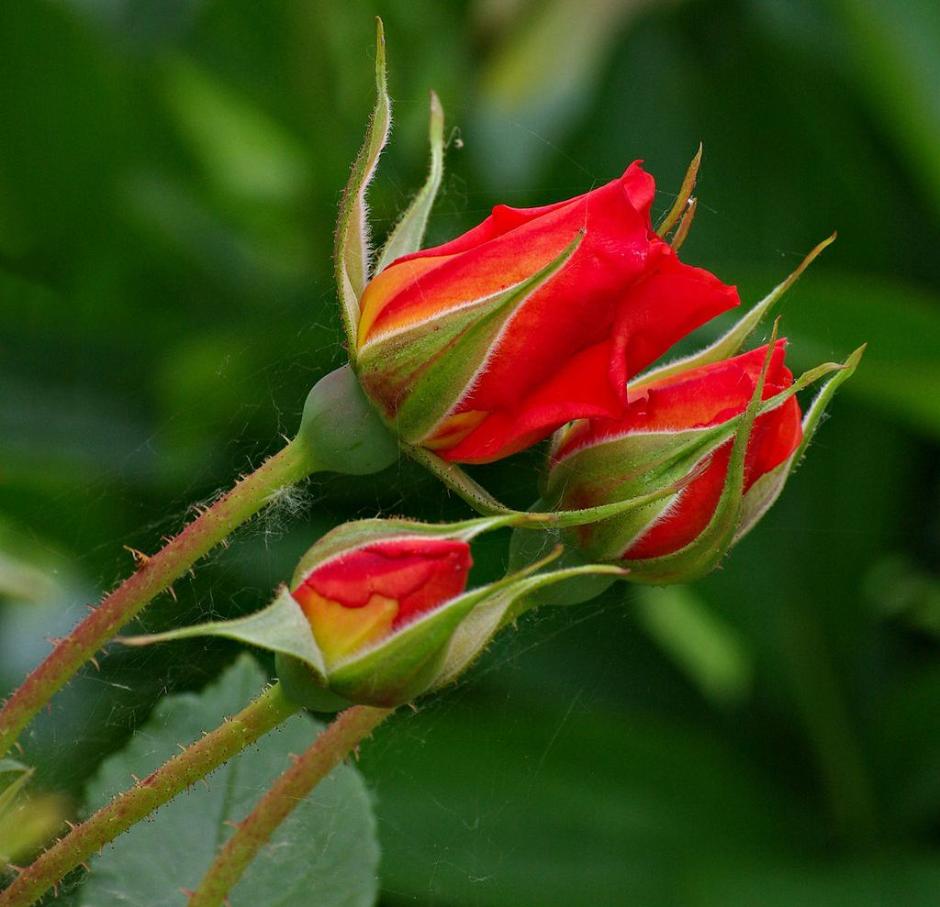
Red roses (Rosa x cultivar),opening buds, in a garden, France. SLPC Photo.
Before I lost my dad every Sunday the usual ‘E.T. phone home’ telephone call was made – home being wherever my parents were, and they were out, at a Spring Fair, so the mobile was where they could be reached…
“Hi Dad – it’s Me.”
“Yes, Hello Me.” Laughs…
Laughs as 'Me' is one of several children who has bellowed since knee high whenever a parental call rings through the house – “which child is that?” – “it’s me!”… “Me who?” – “ME!!!!!”
Luckily voices mature and the difference between individual intonations can be discerned.
Back to the Spring Fair…
“Can you hear it? It’s lovely here, heaps of people – hold on, I’ll put your mother on…”
“Wait a moment Dad – what do you want for Father’s Day?”
“Nothing!”
Sigh….
“Would that be the purple nothing or do you want the green nothing this year dad?”
“The purple nothing.”
“Fine. Heaps of the Purple nothing for you it is.”
Dad always got a cheeky card and a lottery ticket (plus other goodies) - and even then; ''sorry Dad if you’re up at your usual just past dawn, checking the Issue for typos and seeing you’re getting the same old purple/green nothing again'' -
He always gets a lottery ticket because 1. He won the lottery in getting ‘me’ or, in obverse, children are a lottery and you never know what you’re going to get! And 2. He may win the lottery and gain back some of the squillions that started with the Women’s Hospital fees at birth and are added to today with the champagne he’ll insist on providing for lunch as well as that meal itself.
All this hunting around for purple nothings makes you think about Father’s Day itself though; When and where did Father’s Day spring from and when did we here in Australia begin giving over a day to mark the pater familias?
Begun in America in 1908, months after Mothers Day, Father’s Day being celebrated as a tribute to year round dedication and love and sacrifice, took longer to be established than Mother’s Day in Australia.
We already had a “Mothering Day’ that went back a few centuries, lapsed, and then was easily revived in this newest form quite quickly:
MOTHERS' DAY.
The effort which is being made to introduce the observance of the second Sunday in May as mothers' day—a custom widely recognised in the United States—met with some success yesterday.
The wearing of a white flower, which was suggested as an appropriate symbol of truth and purity, though not greatly in evidence, was noticeable here and there; but the chief feature which seemed to direct attention to the idea was the pulpit references. In city and suburban churches preachers spoke of the reverence due to mothers, and in some instances brief addresses were given to the young people to emphasize what the world owed to the influence of good and virtuous maternal parents. MOTHERS DAY. (1909, May 10). The Register(Adelaide, SA : 1901 - 1929), p. 7. Retrieved from http://nla.gov.au/nla.news-article57856993
Every other man I encountered in the streets of New York to-day (Sunday, May 9), wore the white carnation in his buttonhole in honour of "Mothers' Day." Almost every woman carried a huge carnation bouquet. The adornment was not confined to the young. Elderly mothers and fathers in the Fifth-avenue church parade were decked out with white blooms in memory of their own mothers. In the florists' shops the only demand was for white carnations. Sermons in the churches were mostly about mother- hood.
Telegraphic reports from other States tell of similar enthusiasm. In Chicago a congress and exposition of mother-hood are projected later in the week at which medals will be offered to mothers of large families and mothers whose families by their subsequent careers have demonstrated the worth of their upbringing.
The whole nation, in fact, is on a wave of revolt against the new ideas of progressive womankind, and is bent on acclaiming motherhood and motherliness. The keynote of the sentiment which inspires the day is sounded in this editorial utterance : — "It is not mawkish, effusive sentimentality which has created this commemoration of one of the fundamental facts of human existence. It is affection deep as life itself. The silent display of that single flower today is all that is needed for outward observance. The rest lies deep in man's own heart, along with all that his home means to him, and that he does not talk about."
Yet the celebration is not unanimous.
A few ultra-progressive American women openly scoff at the display. MOTHERS DAY. (1909, July 5). The Mercury (Hobart, Tas. : 1860 - 1954), p. 6. Retrieved from http://nla.gov.au/nla.news-article9987080
MOTHERS' DAY.
SYDNEY, Monday.— Mothers' Day was observed in Sydney yesterday by a large section of the community. MOTHERS' DAY. (1915, May 11). The Richmond River Express and Casino Kyogle Advertiser (NSW : 1904 - 1929), p. 5. Retrieved from http://nla.gov.au/nla.news-article128581248
Although this simple expression (shown below) did appear in Australian newspapers soon after it had been inaugurated in the US of A, there were many discussions and calls for such a tribute, and a shifting of when and how, before the first weekend of official Spring became our annual celebrating of Father’s Day.
FATHERS' DAY.
Let us wear a white carnation
For the dear old mother's sake;
She's the best of God's creation,
And as good as He can make;
But the fathers, plain and prosy,
Should be recognised some way.
For their lives are not so rosy,
But, like dogs, they need their day.
Not the sly dads or the fly dads,
Who when rocky grows the road,
Duties flouting,' take an outing,
And let mother bear the load;
They deserve no compensation
But a cowhide or a goad.
Let us give some recognition
To the dads who, year by yea^.
Keep their posts with grim decision,
Loss of job their greatest fear.
They are working uncomplaining
In the mill and market-place,
Just a modest living gaining,
As they keep their steady pace.
Not the club dads or the dub dads.
But the dads who, day by day,
Keep on working, never shirking,
And at night take home their pay.
They deserve some recognition.
Not one day, but every day.
—A. F. Dyer in the New York Times.
FATHERS' DAY. (1909, June 26). The World's News (Sydney, NSW : 1901 - 1955), p. 20. Retrieved from http://nla.gov.au/nla.news-article133972405
And just one insight into why it took so long to be established points out in dour and disdainful terms:
"FATHERS' DAY."
A NEW FASHION.
The first Sunday in June of each year is to be called in the United States Father's day. But is it really necessary to proclaim in so formal a fashion father's decline from his former high estate” asks the New York Post. ''Until our own era his supremacy was taken as a matter of course. There was no Fathers' Day fin Greece or Rome. The head of a household needed no rose in his buttonhole to tell him that he was what he was. Grant that his abuse of power justified the abdication which in our time has been forced upon him, is it generous to compel him to label himself one day in every year? Why should he be dragged from that obscurity which was once the shelter of his wife and daughter into the fierce light that now beats upon them? It may very well be true that he needs encouragement. But surely his spirit is not yet so broken as to make him welcome attentions more suited to the hospital than the counting room. Besides, the wearing of a rose is now superfluous. The income tax law will provide all the identification that the ordinary father will require.” "FATHERS' DAY.". (1913, December 4). Darling Downs Gazette(Qld. : 1881 - 1922), p. 5. Retrieved from http://nla.gov.au/nla.news-article189197893
Present Day Fathers.
Is it because fathers of the present day are clean shaven and do not wear frock coats that they have less control over their children than the fathers of thirty or more years ago is the question prompted by a contribution to the Birmingham Post.
The fashions 'of that time made for a show of gravity, wisdom, ripeness, responsibility, says the writer. Hirsute countenances made a show of strength where often there was nothing strong except the growth of hair. Then consider the clothing of our fathers — what squareness, what weight, what respectable grandeur. There is a fashion in fathers as well as in the clothes they wear, and for better or worse the parental attitude has changed. Freedom of intercourse' may help to' work wonders with our children, but at a price. In unbending to meet the mind of the child, in our fellowship with its childish whims and sports, we may have to suffer many shocks and 'jolts to our paternal dignity. We were brought up to respect and honour our father, but it was easy for us to do. The question is; are we justified in looking for respect and honour from our off-spring? We can be highly respected citizens at a trifling cost and we can have our share of honour from outside the family circle without in the slightest degree raising our own inward estimate of ourselves. But have we earned what we mean by respect and honour from the young, the innocent, the dependent, the helpless? Are we such big, wise, real adults, such great men as our fathers seemed to be, aye, and were, to all intents and purposes, in the eyes of youth? The answer is in the negative. Present Day Fathers. (1927, May 12). Wellington Times (NSW : 1899 - 1954), p. 9. Retrieved from http://nla.gov.au/nla.news-article143256935
During the mid 1920’s periodicals called for letters on people’s thoughts on establishing a Father’s Day observation in Australia, some offering inducements of 10 shillings for first prize and 5 for second for such. Others preceded this invitation with whole hearted support with South Australia (where seat belts were first established) and Tasmanian(where daylight saving first commenced in Australia) and Victoria (where we first established an Australian ‘Federated’ Parliament) leading the way and the first observances springing from the various churches:
'FATHERS' DAY.'
From H. M. SKEWES:— I wish to express my warm appreciation of 'Aldyth's' plea for a Fathers' Day. As the daughter of one whose self-sacrificing devotion to duty and the good of others was as strong and --unfailing as that of any one else. I fully share in die sentiments regarding the place of honour to which the father is entitled, -not only as the patient, uncomplaining toiler, and the bearer of the burdens of others, as well as his own, just because it is the place assigned 'to him by his Maker, and from this place he 'is too often thrust, and is far from being held in 'the esteem he should be. In the ideal home the father ought to be the honoured head, while the mother— 'The heart of the home is she,' and equally to be honoured. "FATHERS' DAY.". (1920, June 8). The Register (Adelaide, SA : 1901 - 1929), p. 8. Retrieved from http://nla.gov.au/nla.news-article62716057
WHY NOT FATHERS' DAY.
From "A MOTHER," — I was pleased to see "Daughter's" question, "What has dear old dad done, anyway." Dad for the most part has been the stronghold of the family, spending many years of toil and business anxiety for its maintenance and comfort. "Mothers' Day is a splendid institution, but we would be even more pleased and proud to observe a "Fathers’ and Mothers Day" combined, characterized by wearing white for mother and red for father. Such a delightful day would help to fulfil the command, "Honour thy father and thy mother." WHY NOT FATHERS' DAY. (1920, May 15). The Register(Adelaide, SA : 1901 - 1929), p. 11. Retrieved from http://nla.gov.au/nla.news-article62717481
FATHERS' DAY.
From "FATHER":—A correspondent advocates the setting apart of a day to be called "Fathers' Day." I hope the idea will not be adopted. If we desired it, we could not share the sacred halo that surrounds the mother in the home, and I am sure we do not wish to share it in public. I hope that Mothers Day will become a fixed institution in the life of every nation, but let as not overdo it by attempting to share the love, honor, and reverence to which every mother is entitled and thereby probably detract from its importance. VIEWS AND COMMENTS. (1922, May 17). The Advertiser(Adelaide, SA : 1889 - 1931), p. 11. Retrieved from http://nla.gov.au/nla.news-article49096506
FATHERS' DAY.
In addition to Mothers' Day, Fathers' Day, as an institution, has taken firm hold in various portions of the United States of America. Both of these institutions have drawn attention to the value of family life, and have deepened respect for mothers and fathers. Fathers' Day will be celebrated in the Brompton Methodist Church tomorrow. FATHERS' DAY. (1922, June 17). The Advertiser (Adelaide, SA : 1889 - 1931), p. 12. Retrieved from http://nla.gov.au/nla.news-article49101631
WHY NOT "FATHERS' DAY"
From "A SELLER":— Might a miserable, dishonourable hussy of a woman make a suggestion regarding "Fathers' Day?" The downtrodden fathers should select the modest daisy as their emblem — most men are "daisies," you know, and it would be appropriate. An appropriate "hymn" would be: —
What would you give for our father,
You who are wanting to buy?
We wouldn't want millions of sovereigns
Piled up as high as the sky.
All ladies are fond of a bargain,
And should jump at this chance with vim.
If he is put on the market,
What will you give for him?
WHY NOT "FATHERS' DAY". (1923, May 18). The Register(Adelaide, SA : 1901 - 1929), p. 7. Retrieved from http://nla.gov.au/nla.news-article64118230
These two seem to indicate the beginnings of what would become International Men’s Day and may indicate why November in some states was first chosen as the day to celebrate Father's Day in post WWI Australia and incorporating the 11/11th or Remembrance Day:
FATHERS' AND MOTHERS' DAY.
The finale to a week of Jubilation was provided at the City Park yesterday afternoon in the way of a demonstration organised by the recently-formed Soldiers' Fathers and Mothers Association Designated Fathers' and Mothers' Day, it was only fitting that the parents of heroes should have their opportunity to publicly demonstrate. They chose to call the people together to listen to patriotic music and to sing the old hymns of praise to the Almighty. It was a happy Idea, for the boys will declare that the hardest part of the past four years' business has been for their parents at home. Many a father and mother on Monday night offered up a silent prayer at the end of it all. An ideal afternoon induced another large gathering to assemble around the flag and flower bedecked band rotunda. About an hour and a half the crowd spent very pleasantly, and few put in an appearance without a white flower in the lapelle of their coat to signify their love and honour for the parents of brave men who have achieved glorious things. The Railway Band occupied the rotunda, and were responsible for splendid music. Opening with the National Anthem, "All People that on Earth do Dwell," Kiplinars "Recessional," "La Marseilles," and "0 God, Our Help in Ages Past" were sung by the gathering, led by a choir seated in front of the rotunda. Interspersed with them were--March, "New Colonial;" overture, "Miralda;" selection, "Trooping the Colours;" sacred selection, “Hoesnna;" song, "Land of Hope and Glory;" and selection, "In This Hour of Softened Splendour," played by the band, under the baton of Mr. L. Corrick. Cheers followed the National Anthem, played at the close. The president of the association (Mr.J. C. Newton) addressed the gathering briefly towards the close. He thanked the people for the support given to the association in attending the function. The object was practically to complete the week's celebrations by singing hymns and listening to patriotic music, so that the fathers and mothers might join together In singing sonsgs of thanksgiving to God. He explained that the aims of the association were to help the soldiers, but where a husband had gone to the war the association would be only too pleased to assist his family, and also the widows and mothers of soldiers or nurses. Their motto was "Carry on,' and they would endeavour to carry on to relieve suffering and sorrow. Their sphere was to cover the whole of humanity where difficulties existed. The City Band, under the conductorship of Mr. Chester Edwards, visited the General Hospital yesterday afternoon and played many patriotic and stirring airs. Mr. Hardwicke Weedon vice chairmen of the board of management, was present, and on behalf of the medical stall and patients conveyed thanks to the members of the band for their consideration after having passed through a strenuous week of playing in the city. FATHERS' AND MOTHERS' DAY. (1918, November 18).Examiner (Launceston, Tas. : 1900 - 1954), p. 6 Edition: DAILY. Retrieved from http://nla.gov.au/nla.news-article51009770
FATHERS' DAY SERVICE.
The father and son movement originated in Providence, Rhode island, on the evening of May 26, 1909, in the form of a father and son supper, organized by Mr B M Russell, the boys' work secretary of the YMCA, who thought fathers should be better acquainted with their sons The event spread to other associations, and was given prominence during the men in religion movement Churches throughout USA began to adopt the plan of bringing fathers and sons together in special services social and athletic activities In 1913 the Cleveland YMCA wrote to some 500 mayors, urging them to make a new year’s proclamation in the community interests of fathers and sons In 1917 the international committee of the Y M C A adopted the suggestion of promoting a national father and son day the success of which prompted a father and son week in 1918, associating the movement with Lincoln s birthday )Later a joint committee of representatives of the International Sunday School Association and the Y M CA was appointed for Canada and U.S.A, and the movement was recommended to the whole Christian Church, the suggested date, November 6-12 bringing Armistice Day into the period The movement seeks to advance all community interests pertaining to fatherhood and sonhood, and recognises an obligation to help maintain world peace The Australia fathers' day is observed in October or November in the same spirit with which mothers' day is enshrined and a red flower is the emblem A fathers day service was held last evening in the Memorial Church in the presence of a great congregation Mr Humphrey Bishop being the soloist The Rev C Bernard Cockett, M-A explained the objects of the movement and preached on 'Reunion in Eternity'. FATHERS' DAY SERVICE. (1923, October 22). The Mercury(Hobart, Tas. : 1860 - 1954), p. 9. Retrieved from http://nla.gov.au/nla.news-article23673337
FATHERS' DAY.
From "SCARLET LEAVES": — Everyone seems to want a Fathers' Sunday. South Australia has led the way in many directions, and surely she will gladly lead the way in this. All good mothers had fathers, and most of them probably had good ones, and all fathers will gladly welcome the heartfelt prayers and sympathy of the community. Fathers are bearing heavy burdens just now, and many who would have been fathers have laid down their lives for the rest of us, that our homes might be in peace. In token of this could we not have a Fathers' Sunday while the red poinsettia and red salvia are filling our gardens with beauty, and when we can get the red vine leaves and virginia creeper to decorate our churches? It is only some curious oversight that did not arrange to have Fathers' included when Mothers' Sunday was instituted. With apologies to all fathers for the omission, let us rectify the mistake. FATHERS' DAY. (1923, May 22). The Register(Adelaide, SA : 1901 - 1929), p. 10. Retrieved from http://nla.gov.au/nla.news-article64110417
When observances did begin they were put to good use in caring for others
FATHERS' DAY
On behalf of the old men at Lidcombe, Mrs. J. Heyden is anxious to make Fathers' Day as big a success as was Mothers' Day at Newington. Donations of mufflers, bed socks, cigarettes, pipes, tobacco, coffee essence, condensed milk, and next Friday cakes, jam sandwiches, sweets, etc., may be left at Feminist Club, Culwulla Chambers, Castlereagh-street, of at Florists, 5 Norton-street, Leichhardt.FATHERS' DAY. (1924, June 1). Sunday Times (Sydney, NSW : 1895 - 1930), p. 2. Retrieved from http://nla.gov.au/nla.news-article128136243
FATHERS’ DAY.
Somebody has suggested that we ought to have a Fathers’ Day. As with mothers, there are fathers and fathers. You have the father who never goes out at night and the father who is never in at night. But does the father get a fair deal?. Is he not often regarded as a sort of walking cashbox that has no right ever to be empty? The strain of raising the necessary finances for the home, and of so winning his own advancement as to be able to' give his own family a good start, makes him almost a negligible quantity in the home. Many men find that the “struggle for life” in business or profession means constant day and night work. Does the father make no sacrifice ? I heard of one father who was never well dressed until he was able to take over his son’s cast-off suits. Does the father get a fair deal? Is he not often held up to the child as a sort of bogey? “You behave, Tommy, or I’ll tell your father on you,” or “You just wait until father gets home and see what, you’ll get,” and so on ad. lib. ; And when father does tan the kiddies’ hides mother tells him in front of them he is a cruel brute. A friend of mine told me the story of an acquaintance of his who tried to bring up his lad in the way he should go. Mother always interfered and the lad soon learned that there was safety behind mother. The time came when the mother wanted father to use his influence, but it was too late. A boy’s life was ruined because father was not allowed to carry out Solomon’s now ‘unfashionable advice.'
Still it would be nice to have a Fathers’ Day. Some men would enjoy the novel experience of sitting in church and receiving a metaphorical pat on the back. And it wouldn’t be hard to wear a virtuous look and try to forget that the “quid” which, ought to have been spent on the kiddies’ boots “went west.” FATHERS’ DAY. (1925, May 22). Pinnaroo and Border Times(SA. : 1911 - 1954), p. 2. Retrieved from http://nla.gov.au/nla.news-article189156775
There were more debates about when:
FATHERS' DAY. The second Sunday in June has been set aside as "Fathers' Day," in order to bring a little cheer to the old men at Lidcombe Asylum. Mrs. J. Heyden, of Leichhardt, is appealing for donations of pipes, tobacco, mufflers, mittens, Balaclava caps, bed-socks, puzzles, games, cakes, and sweets; and gifts may be left at Mr. F. J. Moore's boot repairing depot, opposite Fountain, Parramatta.FATHERS' DAY. (1925, June 5). The Cumberland Argus and Fruitgrowers Advocate (Parramatta, NSW : 1888 - 1950), p. 2. Retrieved from http://nla.gov.au/nla.news-article103764555
FATHERS' DAY
As decided at the annual conference in 1927, the first Sunday in November will be kept as Father's Day – The Land
Fathers' Day
At the Annual Conference of the Country Women's Association it was decided to observe the first Sunday in November as Fathers' Day, and members of the Association were requested to wear a Red Rose on that day as the symbol of love. Fathers' Day. (1928, November 2). Manilla Express (NSW : 1899 - 1954), p. 2. Retrieved from http://nla.gov.au/nla.news-article193870938
The shift from November and other months towards September and recognition by those who accept advertising in newspapers that those who pay for such want their support of what is now a beneficial commercial observance became more apparent - the want to celebrate fathers who were alive as much as some obscure link with the first week of Spring ('fonts'/sprins as such as father's anciently were described), shifted the emphasis away from fathers we had lost to fathers we still had and kept Remembrance Day for respecting and honouring those we should always remember:
"FATHERS' DAY"— SEPTEMBER- 1;
"Father's Day" in U.S. A. is now an established- annual event, rapidly rivaling "Mothers' Day"' It is one day of the year, so father says, when he receives some of the appreciation due to him. In Melbourne there was a move to have such a pay and it was an outstanding success. With the improvement in general conditions, Melbourne apparently feels that now is the time to establish "Fathers' Day" permanently,' and September 1 has been selected as the day. Brisbane retail drapers and mercers are supporting the Idea wholeheartedly, and showcards, stickers, . &c., calling attention to the significance of "Fathers' Day" is being featured in the various departments, supplemented in many instances by window displays. All these will convey suggestions for giving father some little gift on this particular day. Why should not 100,000 dads wake up to find themselves famous— for a day—and in their own family circles on Sunday, September 1. "FATHERS' DAY"--SEPTEMBER 1. (1935, August 27). The Telegraph (Brisbane, Qld. : 1872 - 1947), p. 17 Edition: CITY FINAL LAST MINUTE NEWS. Retrieved from http://nla.gov.au/nla.news-article180633089
And even:
STOP PRESS
FATHERS' DAY SYDNEY, Wednesday.
A discussion as to who was responsible for Inventing Fathers Day took place before the President of the Industrial Commission to-day, when Its Inquiry Into Chain Stores was continued.
Edgar Barton Coles, Director of G. J. Coles, Ltd., mentioned that, store managers received bulletins drawing attention to events to come such as centenary celebrations and Fathers' Day.' When the President Inquired who Invented Fathers' Day, the secretary of the shop Assistants Union, Mr. F. O'Dea, said they were worked up by the retailers. Witness declared, however, that stores catering for men's wear and hairdressers were responsible. Witness agreed with the president that the object of the day was to sell more goods. STOP PRESS. (1936, October 28). The Maitland Daily Mercury(NSW : 1894 - 1939), p. 7. Retrieved from http://nla.gov.au/nla.news-article125368095
But the tide changed and whether this was sent in by someone with a fiscal interest in promoting the day, or a genuine gent who had brought up children by himself, it echoes similar growing sentiment to shower he who is known for giving red roses with some thornless petals of love
Why Not Fathers' Day ?
(To the Editor.)
Sir,-I was listening to a sermon the other night by one of our esteemed ministers of religion.
It was "Mothers' Day," and this reverend gent was expatiating on what mothers had done for their children in the face of great odds, minus a deficient husband. He quoted children who had developed Into great men, and these included poets, statesmen, musicians, etc.
Now cannot we "put the boot on to the other foot," and ask what about the fathers?
Some fathers have produced many great men, and they have possessed a deficient wife. Why not have a "Fathers' Day," once a year, just to hear what our reverend friends have to 'say regarding us? I am - etc
“Father”
Brisbane. Why Not Fathers' Day?. (1935, May 22). Daily Standard(Brisbane, Qld. : 1912 - 1936), p. 4. Retrieved fromhttp://nla.gov.au/nla.news-article183664692
FATHERS' DAY
Fathers' Day finds World-Wide favor
To America belongs the distinction of having originated both Mothers' Day and Fathers' Day. A pretty story lies behind the inspiration of Mothers' Day, a symbolism which found world -wide recognition in a night. Fathers' Day may not have originated in such romantic circumstances, but it, too, has found universal appeal.
Both occasions are commercialised by traders, but the sentiment which motivated the movements in the first place has never been allowed to be submerged. From America it has radiated to almost every country in the world. Fathers' Day has been designated an occasion to teach citizens that dads are more than mere biologic incidents and are, therefore, entitled to due recognition on their one holiday. Probably in the United States to a greater degree than anywhere else in the world is Fathers' Day paid the respect that its founders felt it would achieve, but support and sentiment are steadily increasing in other countries, notably in Australia, where, despite the event being still in its infancy, it has found an exceptional response. It is abundantly clear that this year's observance will be on a far bigger scale than previously. It has been determined that Dad should have his day so that next Sunday fathers of all creeds and sizes, blonde or brunette, rich or poor, will be lavished the affections and gifts of families in the city and in country hamlets from east to west and north to south of the continent. FATHERS' DAY. (1936, September 2). The Daily News (Perth, WA : 1882 - 1950), p. 10 Edition: FINAL EXTRA. Retrieved fromhttp://nla.gov.au/nla.news-article82528335
FATHERS' DAY
The first Sunday in September is coming to be recognised as Fathers’ Day, as the second Sunday is May is looked upon as Mothers' Day. On Mothers' Day we wear a white flower, and on Fathers' Day we are asked to wear a red flower. The occasion will be remembered at the Methodist Church on Sunday, when a special Father and Son service will be held at night. Fathers and sons are given a special invitation to this service. The subject of Rev. A. E. Brawn's address will be "Fatherhood, Human and Divine." LOCAL AND GENERAL. (1937, September 3). Coffs Harbour Advocate (NSW : 1907 - 1942; 1946 - 1954), p. 2. Retrieved from http://nla.gov.au/nla.news-article187837962
Fathers' Day On September 4
Fathers' Day will be held this year on Sunday, September 4. During the past few years it has become the practice to give a small taken of esteem to fathers on Fathers' Day, and, with this in mind, most of the Adelaide shops have made special provision for such gifts. Many shops have special gift envelopes, which can be presented with ties, socks and other small gifts. Fathers' Day On September 4. (1938, August 24). The Advertiser (Adelaide, SA : 1931 - 1954), p. 19. Retrieved from http://nla.gov.au/nla.news-article35607883
FATHERS' DAY
Growing Movement
RECOGNITION NEXT SUNDAY
An anniversary of wide recognition in many parts of the world, Fathers’ Day, will be observed in Tasmania on Sunday next. Essentially a gesture on the part of the younger people to the love and influence of the home, the days set apart for the honoring of fathers and mothers are now regarded as an occasion for the sending of small gifts and remembrances.
Mothers' Day, which is observed annually in May, was inaugurated in modest fashion, but it is now a strong movement in the Commonwealth. Fathers' Day is a more recent development, but it is firmly established in the United Stales, and it has grown substantially in Britain and Australia. Recently, it has also become of much wider influence in Now Zealand.
The demand for small gifts and for other forms of affection appropriate to the day will be catered for by the trading community. Special displays are being arranged by stores and shops and, In addition to the wide range of gifts which is being prepared, special wrappings are to be available.
Retaining much of the sentiment of home life, the widespread recognition of days sot apart for the honoring of fathers and mothers is regarded as a means of at least in part refuting much of the criticism which is levelled at the younger generation. In the past few years many sons and daughters have been keen to express their appreciation by the purchase of small gifts for their parents on these anniversaries, and it is considered there will be even greater interest on the day set apart for the fathers next Sunday. FATHERS' DAY. (1939, August 31). Advocate (Burnie, Tas. : 1890 - 1954), p. 2. Retrieved from http://nla.gov.au/nla.news-article68321200
Fortunately the heart and head prevailed and although it took a few more decades to be firmly established, we all get to say 'Happy Father's day' to our own dads and to every gentleman who is a father in one form or another today.
FATHERS' DAY
By DRYBLOWER
I sing a song of Fathers' Day, a song too seldom sung
By the rising generation, while the generation's young,
A sons too seldom warbled in the newly-wakened West,
A song of songs long overdue in many a natal nest.
Its clarion chords are many, but they oft remain as mute—
Mute through some misunderstanding and the rifting in the lute.
But let misunderstanding like a vapor wilt away,
And whatsoe'er you may forget, forget not Fathers' Day.
Fathers' Day — Fathers' Day,
While you toil and while you play
Give a kindly thought to someone growing old and growing grey.
Though he's passed his primal peak
Some sweet solace for him seek
And remember this day week—
Fathers' Day.
He has steered through many life-storms and has doldrumed many calms
Since he carried you, a baby, in his fond paternal arms.
His steps are staid and slower, but his heart as fondly beats
As when he faced with fortitude what every human meets.
You have crowed upon his shoulder as he carried you on high,
To see the world's processions and its wonderments go by.
While you cooed within your cradle or your toddling steps he'd guide,
He stood between you and the care that threatens far and wide.
Fathers' Day — Fathers' Day,
When the debt you owe you weigh
Did he anything deny you, did he ever say you nay?
'Twixt all dangers staunch he stood
Till he'd steered you through the wood,
So make the day a good
Fathers' Day.
Look around you — look around you, there is plenty at your call
To put within his toil-worn hand or hang upon a wall.
There are souvenirs a-plenty, there are gifts his home to grace
To bring a whisper to his heart, a smile upon his face.
Great or small it doesn't matter, big or little doesn't count,
The spirit that accepts it doesn't measure the amount.
As long as in the offering, sweet love has had its say
The gods that watch for good deeds done, will bless you Fathers' Day.
Fathers' Day — Fathers' Day,
Bind him to you while you may,
Do not let some triviality some good intention slay
When next Sunday morn you greet
Him who bore the burdens' heat
Be you not ashamed to greet
Fathers' Day.
* * * *
Life was never very lengthy, time flits by with every breath
And there are some divisions bit'rer far than mortal death.
The cold night, the callous word, the sneering and the slight,
The dull clouds of suspicion when his life-sky should be bright.
Cast your heart back to the pathways when he took you by the hand,
Recall the leagues of travail that his tenderness has spanned.
Some time when for some good he rose above the common clay,
And let some sweet memento consecrate this Fathers' Day.
Fathers' Day — Fathers' Day,
Let affection filial sway;
It won't be what you purchase and it won't be what you pay,
You are deep within his debt
But there's time a-plenty yet
So see you don't forget
Fathers' Day!
FATHERS' DAY. (1936, August 30). Sunday Times (Perth, WA : 1902 - 1954), p. 19. Retrieved from http://nla.gov.au/nla.news-article58769774
Father's Day 2015: A Short Insight Into Dad's Day Being Established in Australia - For W A G - threads collected and collated by A J Guesdon in 2015.
We studied 100 years of Australian fatherhood. Here’s how today’s dads differ from their grandfathers
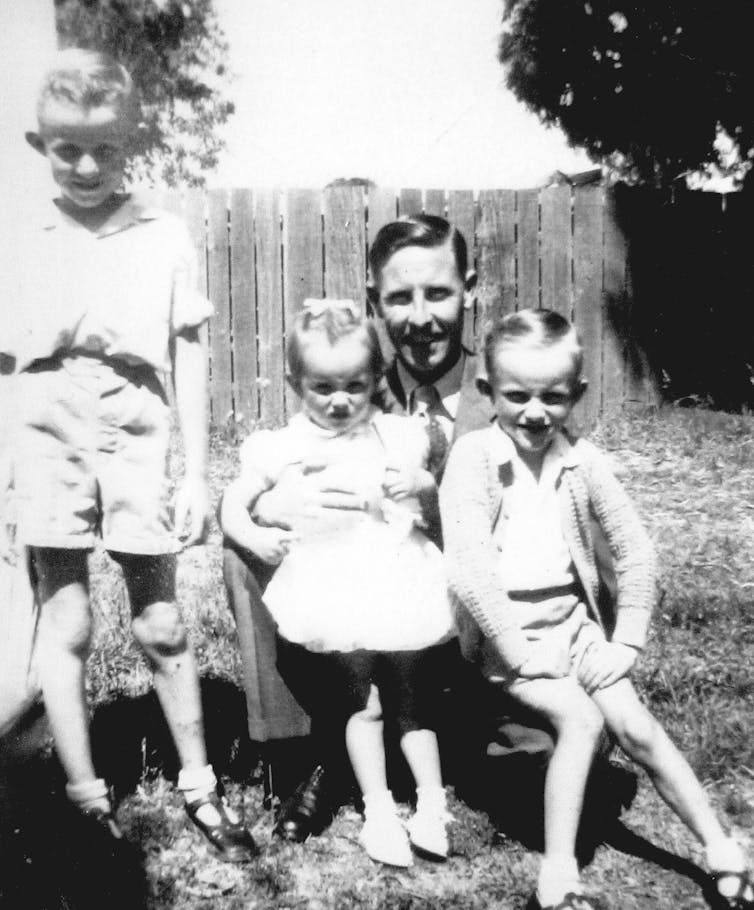
Today’s Australian fathers are believed to be more “hands on” and engaged with their children than the stereotypical absent breadwinner of generations past.
However, our research exploring Australian fatherhood between 1919 and 2019 has found that while men’s family roles have changed, deep-rooted societal and cultural forces keep them from being the kind of fathers many of them would like to be.
The Breadwinner Of The Early 1900s
Our research examined oral history interviews with (and about) fathers from diverse backgrounds, along with archival sources including letters, diaries and government files. Our goal was to better understand the experience of Australian fathering over the past 100 years.
We found a key factor shaping the history of Australian fatherhood has been the demands of paid work and the enduring power of the provider role — even in situations where dads are not the sole earners.
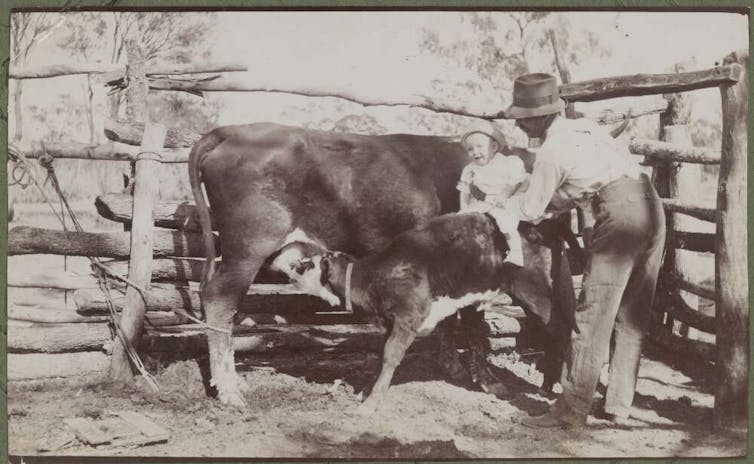
While the breadwinner father is hardly a uniquely Australian phenomenon, the ideal became institutionalised here in distinctive ways.
The 1907 Harvester Judgement, a landmark court ruling, established the principle that the male basic wage should support a wife and three children. This decision, which in turn ensured lower wages for women, remained the basis for setting Australia’s minimum wage until the 1970s.
Male breadwinner assumptions shaped not just the country’s wages but also welfare and tax policy, so that it simply made better financial sense for fathers to work and mothers to stay at home with the kids. This entrenched a gendered division of labour in family roles that would last for generations.

The Great Depression then made many fathers failed breadwinners. Geoffrey Ruggles, who was born in rural Victoria in 1924, recalled in an oral history interview that when his war-veteran father lost work, his mother was “forced to scrub other people’s washing”.
Humiliation fuelled marital discord and damaged Ruggles’ relationship with his father. He found an alternative father figure in his navy officer uncle:
[My uncle] had a lot of glamour about him […] an extrovert, a bright outgoing, merry man. A contrast to my father who was a sad sack. So Uncle Tom was a great fellow to be with, he gave me tools and helped me to start things like that, and fostered an idea of innovation – of doing what I wanted to do.
The sons of struggling Depression-era families often grew up determined to be good providers for their own families.
Many were also veterans who sought the stability of “traditional” family life. These men became the stereotypical, Holden-driving, breadwinner fathers of the “imagined fifties”, counterpart to the stereotypical 1950s housewife.

These stereotypes are not entirely wrong. The sole-breadwinner father is often assumed to be the historical norm, but in fact this family arrangement was broadly achievable for only a brief time between the early 1950s and 1970s. For the only time in Australian history, many working-class families could manage on one wage.
By the mid-1970s, however, recessions, deindustrialisation and the casualisation of the workforce shattered the economic security of the (male) “job for life”. At the same time, feminism and equal pay were mounting a new challenge to the male breadwinner stereotype.
The “New Man” Of The Late 20th Century
History is so often circular. The sons of the postwar, breadwinner fathers wanted to do things differently from their dads, too.
In another oral history interview, Peter, a man born in Melbourne in 1956, recalled:
As a teenager in the 1970s […] most of the guys that I knew had lousy relationships with their dads. And I think that was really common […] a lot of them had been to war, they’d come home and their role was to build a family, you know, build a financial basis for it so they worked long hours and they just really didn’t seem to relate to their sons.
We all got on really well with each other’s mothers. But the fathers were very distant figures and it’s very different from today.

The social, cultural and economic transformations sweeping Australia from the mid-1970s brought new opportunities and expectations for fathers. Feminism and the growing numbers of working mums challenged traditional gender roles in families and contributed to the emergence of the popular ideal of the “new man” by the 1980s.
Fathers of this generation were more likely to be present at the births of their children, and to be physically and emotionally “present” dads.
The inevitable outcome of these changes, some assumed, would be a dual worker-carer model of family life in which mothers and fathers have more equal parenting roles.
Read more: How Hemingway felt about fatherhood
The “Modified Breadwinner” Family
Yet, today’s fathers still find their working lives to be a significant barrier to their ability to be active and engaged fathers.
Since the mid-1990s, the most common family formation has been the “modified breadwinner” model. Mothers typically return to work after having children, usually part-time, while the full-time working father earns the primary wage.
Although fathers are caring for children slightly more than in the past, time use surveys confirm how much more time women spend doing childcare today compared to men. The unpaid labour of household and family management still largely falls on mothers, with dads “helping”, as homeschooling during COVID has laid bare.
Fathers interviewed in the late 1990s and early 2000s express a desire to be more involved, but are tied to paid work that limits the time and opportunity for parenting. Many speak of the stress of trying to meet expectations at work, as well as home, and some feel excluded from family life.
Peter, a man born in the mid-1950s in Victoria, recalls:
I was probably working pretty long hours and a lot of the duties were left up to my wife to do […] Even on the weekends, I found that if the kids had a choice of who they would go with, they tend to choose my wife anyway. I found that distressing quite often.
I never used to get home from work till 7:00-7:30. My job was to earn money, and the only time I did stuff around the house was on the weekend and for the kids.
The fathers who spend the most time with their children tend to be those living in less typical family types, including single and stay-at-home dads.
Gay male couples with kids are less detached from their children’s daily care than fathers in heterosexual couple families, perhaps because they are able to evade the “gender baggage” that influences men’s and women’s roles in families.
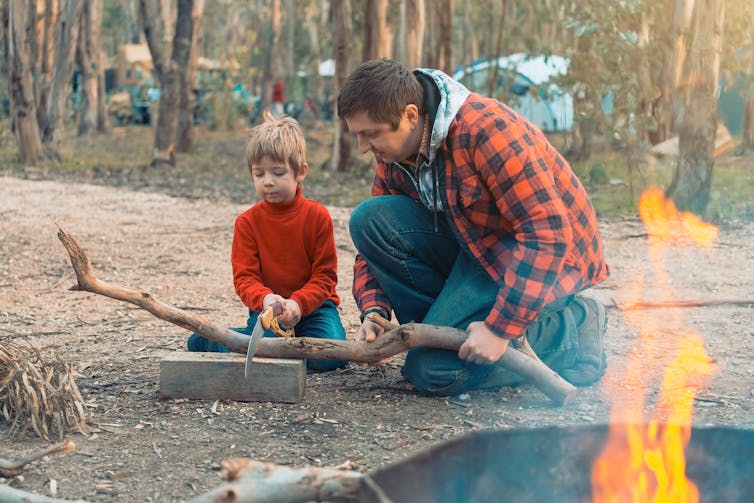
The Parenting Paradox
Today’s Australian fathers face a striking paradox. They are expected to be more “hands-on dads”, yet there’s been little systemic change in their working lives (including access to, and uptake of, parental leave and flexible work). There’s also been little change to gendered roles in family arrangements: a situation that, admittedly, many fathers have been happy to roll with.
Most fathers are still working long hours and many are concerned about how little time they have to be engaged fathers. Today’s dads may not view breadwinning as their raison d'être, but the breadwinner model of Australian fatherhood is not yet “history”.![]()
Kate Murphy, Senior Lecturer in Contemporary History, Monash University and Alistair Thomson, Professor of History, Monash University
This article is republished from The Conversation under a Creative Commons license. Read the original article.
People’s Choice Awards In The NSW Training Awards
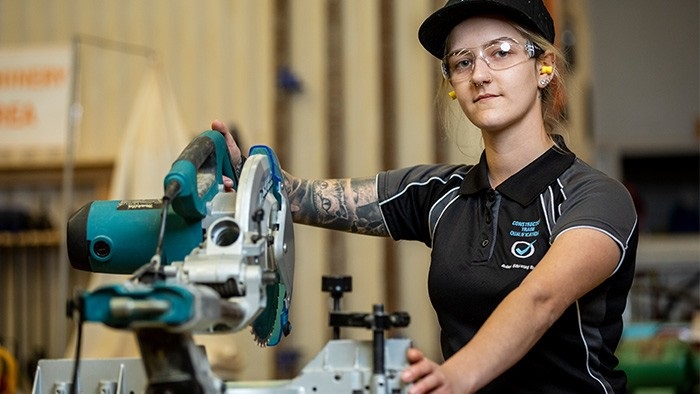
NESA Media Statement: HSC Major Projects
- Drama
- Textiles and Design
- Design and Technology
- Industrial Technology
- Visual Arts
- English Extension 2
- Music 1 (compositions)
- Music 2 and Extension (compositions and musicology)
- Society and Culture Personal Interest Project
HSC Online Help Guide
Stay Healthy - Stay Active: HSC 2021

TAFE Fee-Free Online Courses Available For 16-24 Year Olds
- live or work in NSW
- be an Australian Citizen, a permanent resident, a New Zealand citizen, or a humanitarian visa holder
- have left school
- aged from 16 - 24 inclusive, or
- in receipt of a Commonwealth Government benefit, or
- an unemployed person, or
- people expected to become unemployed
Teens Show Tremendous Bravery In Narrabeen Beach Rescue
August 20, 2021: By Surf Life Saving NSW
“The dangers didn’t scare me, I was just hoping the child and father would be okay.”
These are the words of Liam Doughty – the soon to be 17-year-old who paid homage to his nipper training in the aftermath of a fearless double rescue at Narrabeen Beach last month.
He’s no stranger to the ocean; as a talented surfer, Liam almost has saltwater running through his veins. His father confesses he practically grew up on the picturesque Narrabeen Beach, and was a North Steyne SLSC nipper for many years.
However, with that confidence and familiarity comes the understanding that, at times, the ocean is a treacherous place.
And just after 4.30pm on Wednesday August 11, those dangers reared their head in the worst possible way.
“My friend and I were swimming and it was my friend who first heard the commotion coming from the beach,” Liam recalled.
“At first, I didn’t know what was happening, but our first instinct was that there was a shark in the water from all the screaming so we both swam halfway to shore.
“When the screaming didn’t stop, we looked up and finally saw what they were pointing at.”
Caught in a strong rip, a father and son were fighting desperately against the current. Instincts kicked in, and Liam and his friend, Oscar acted as they believe anyone in their position would have.
“I knew that they were in trouble and obviously don’t have experience and knowledge about rips,” he said.
“We sprinted across the sandbank towards them and jumped in. Oscar got to the boy first as he wasn’t in a good state, and then I got to the father and asked if he was ok. He was panicked but said he could just manage to get in.
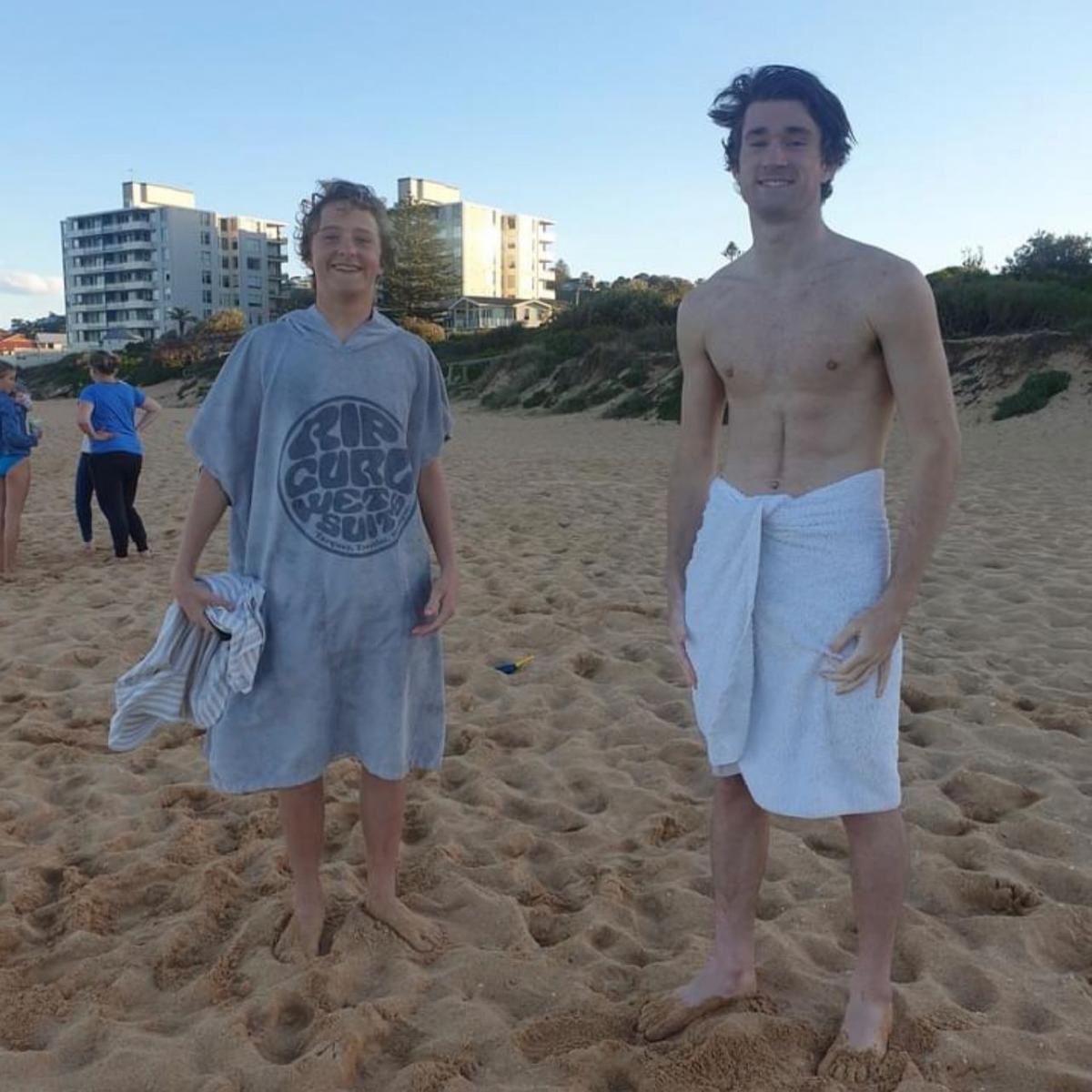
L-R Oscar Hugill and Liam Doughty, source: Narrabeen RSL Facebook Page
“I swam beside him to make sure he was ok, but once we got to the beach the immediate concern was the boy.
“Ambulances then arrived to help, and we spoke to the family and others on the beach.”
Reflecting on the incident a few days later, Liam was able to fully grasp the magnitude of what had unfolded that day and was grateful for his involvement with his local surf club as a junior which prepared him to be capable in situations just like this one.
“I called on two key skills that I learned through Nippers,” he said.
“The first being how to effectively run across a sandbank - it is very important as you can be so much quicker than just normally running.
“The other was being able to identify a rip and understanding what they do.
“Once I got to there, I saw they were both trying to swim against the rip and into shore. Knowing that its nature is to go straight out to sea, I swam across the rip towards the sandbank.
“If the rip was any stronger than it was, I would’ve allowed it to take us out, then swam across back to the sand bank.”
While the young boy was transported at the time to Northern Beaches Hospital in a stable condition for observation, Liam and Oscar’s actions ensured that both the man and his son escaped the rip with little more than a bad memory.
“My previous training definitely helped,” Liam concluded.
Surf Life Saving Australia Urges Public To Volunteer For Individual And Community Benefit
September 2, 2021
“Our club, is your club”
Surf Life Saving Australia (SLSA) exists to save lives, create great Australians and build better communities and as the 2021/22 patrolling and summer season approaches, SLSA is encouraging members of the public across the country to join their local surf club.
SLSA, Australia’s largest volunteer movement with over 181,000 members across 315 clubs nationwide, is launching a recruitment drive ahead of the start of the new season highlighting the value and benefit of surf lifesaving clubs to the community, and also the individuals involved.
“It has never been more important or easier to join your local surf club,” said SLSA President John Baker ESM. “Surf clubs around the country are more than just a building or a service, they’re a home, a family, and we are asking all Australians to join us and make it ‘your club’ too. There is a place for everyone at the surf club and everyone is welcome.”
Whether it’s at the beach, through bushfires, floods or the COVID-19 pandemic, surf lifesavers and Surf Life Saving Clubs continue to be at the heart of communities offering emergency services, respite and support, all with a friendly sense of belonging and community spirit.
The Deloitte Access Economics 2020 report on ‘The Social and Economic Value of Surf Life Saving Australia’ highlighted that 90% of Surf Life Saving Club members said that being a part of their club assists them to positively contribute to their community while over 80% of members said that Surf Life Saving gave them a sense of purpose and belonging in their life.
Research conducted by Volunteering Australia from the first 12 months of the COVID-19 pandemic in Australia (April 2020 to April 2021) found that those who were able to volunteer through the pandemic reported a significantly and substantially smaller decline in life satisfaction for those volunteers who did not stop volunteering, compared to those who stopped, or who never volunteered in the first place.
For those who continued volunteering, levels of psychological distress were also substantially lower than those who stopped volunteering, and those who had never volunteered.
“We know that volunteering gives people a purpose and it has been proven to increase physical and mental wellness in everyday life, especially through the challenges of the past 18 months due to COVID-19,” said Baker ESM.
“In light of this we are actively encouraging new and returning members to join our clubs, to find that sense of purpose and belonging whilst at the same time helping the wider community … our club is your club.”
Surf Clubs around the country are at the heart of local communities and offer a variety of roles both on and away from the beach or they can simply be a place to gather, create new friendships and support individual and community wellbeing.
For more information on how to join your local Surf Life Saving Club click here – www.sls.com.au/join
Viewpoint On Hobart: 1975
Australian Research Takes Off: CUAVA
August 30, 2021; The Hon Alan Tudge MP, Minister for Education and Youth and Senator Andrew Bragg, Senator for New South Wales
Australian research has soared to new heights, with a locally designed and built satellite launched into space on board a SpaceX rocket at Cape Canaveral in the US.
The mission is a key project of the Australian Research Council Training Centre for CubeSats, Uncrewed Aerial Vehicles, and their Applications (CUAVA), partly funded by the Morrison Government.
Minister for Education and Youth Alan Tudge congratulated all those involved in the project.
“What a great display of Australian research on the world stage – and beyond,” Minister Tudge said.
“It is another example of the power of research commercialisation, with the Government’s $4.8 million in funding laying the foundation for researchers to partner with local and global businesses.
“This project is significant for the Australian space sector and will grow our research capability in the cutting-edge industry of commercial space and unmanned aerial vehicles.
“The centre is also helping to train a new generation of researchers and workers in this critical industry.”
Senator for New South Wales, Andrew Bragg said this was one of many missions helping to develop a sustained commercial and scientific space industry in NSW and Australia.
“The University of Sydney is at the forefront of developing new instruments, technology and products to solve crucial problems, and develop a world-class Australian industry in CubeSats,” Senator Bragg said.
“Their exciting work will help create local jobs in New South Wales and benefit the state and Australian economy.”
Cubesats are small light weight rectangular boxes packed-full of high-tech equipment that provide an easier way to access near-Earth orbit for scientific and commercial purposes.
The SpaceX rocket will deliver the CubeSat, CUAVA-1, to the International Space Station for deployment, expected later this year or early 2022.
CUAVA-1, an Australian designed and built spacecraft, was launched onboard a Space-X Falcon 9 SpX-23 rocket on Sunday, 29th of August 2021, from the Kennedy Space Center at Cape Canaveral, Florida.
A lead project of the Australian Research Council Training Centre for CubeSats, Uncrewed Aerial Vehicles and their Applications (CUAVA), this first mission is one of many expected to help pave the way for the development of a sustained commercial and scientific space industry in NSW and Australia.
CUAVA-1 will carry four experimental payloads intended to give scientists and research students fresh insights from near-Earth orbit during its 12-month mission. CUAVA-1 is being launched to the International Space Station for deployment into orbit about 400 kilometres above Earth, expected later this year.
The CUAVA-1 mission aims to:
- Investigate Earth’s plasma environment and space weather using onboard radiation detectors;
- Observe Earth using novel imaging technology;
- Test equipment designed for use in a future satellite that will search for signs of life on planets around Alpha Centauri, our nearest star system;
- Link with the international amateur radio union for education and outreach.
The CUAVA-1 mission will give students and postdoctoral researchers unique access to develop skills and experience with space-flight in readiness for employment within the Australian space industry. The Director of CUAVA, Professor Iver Cairns from the School of Physics at the University of Sydney, said: “This mission shows that Australian universities are at the forefront of our emerging national space industry. Our CUAVA Training Centre is leading in the development of near-Earth space technology and is a critical link in training the next generation of space engineers and scientists.”
Partly funded by the NSW Government, the project is an important step in the development of Australia’s burgeoning space industry.
NSW Minister for Jobs, Investment, Tourism and Western Sydney Stuart Ayres said: “CUAVA is leading the way in developing the space technology of the future and training the people that will use it. “NSW congratulates CUAVA on the launch of its first satellite. Our state is home to almost half of Australia’s space-related businesses and generates around half of all space-related revenue nationally: there is no better place to support space technology research and development to create the jobs of the future.”
Australian Research Council CEO Professor Sue Thomas said the launch was a significant outcome from the Training Centre. “We increasingly rely on access to space for vital data and services, and a skilled workforce is required to grow the sector and capitalise on global opportunities – it is exciting to see CUAVA undertaking this essential research. CUAVA is funded under the ARC’s Industrial Transformation Training Centres scheme which fosters close partnerships between researchers and end-users to provide innovative Higher Degree by Research and postdoctoral training for industries that are vital to Australia’s future.”
CUAVA-1 mission control will be the first space-flight managed by Saber Astronautics through the new Responsive Space Operations Centre (RSOC) in Adelaide. CEO of Saber Astronautics, Dr Jason Held said: “Saber is delighted to fly the CUAVA-1 satellite out of the newly minted Responsive Space Operations Centre, which went live at Lot Fourteen in Adelaide last March.”
The CUAVA-1 launch is also a vital step in building international space cooperation. The Cape Canaveral launch is being managed through the Japanese launch provider, Space BD.
Cubesats are a low-cost and simple way to access near-Earth obit for scientific and commercial purposes. They are built from small boxes just 10 centimetres cubed, weighing no more than 1.3 kilograms each, and are packed-full of high-tech equipment. CUAVA-1 will include three cubes, making a box 30 centimetres long and about three kilograms in mass.

Based at the University of Sydney, CUAVA is a joint project involving the University of NSW, Macquarie University, multiple Australian commercial and government partners and the Rochester Institute of Technology in the USA. CUAVA’s government partners are the Australian Bureau of Meteorology and the Department of Defence. Its commercial partners include Air@Wave Communications, ArborCarbon, HyVista and Saber Astronautics.
For more information about CUAVA and this mission visit their website.
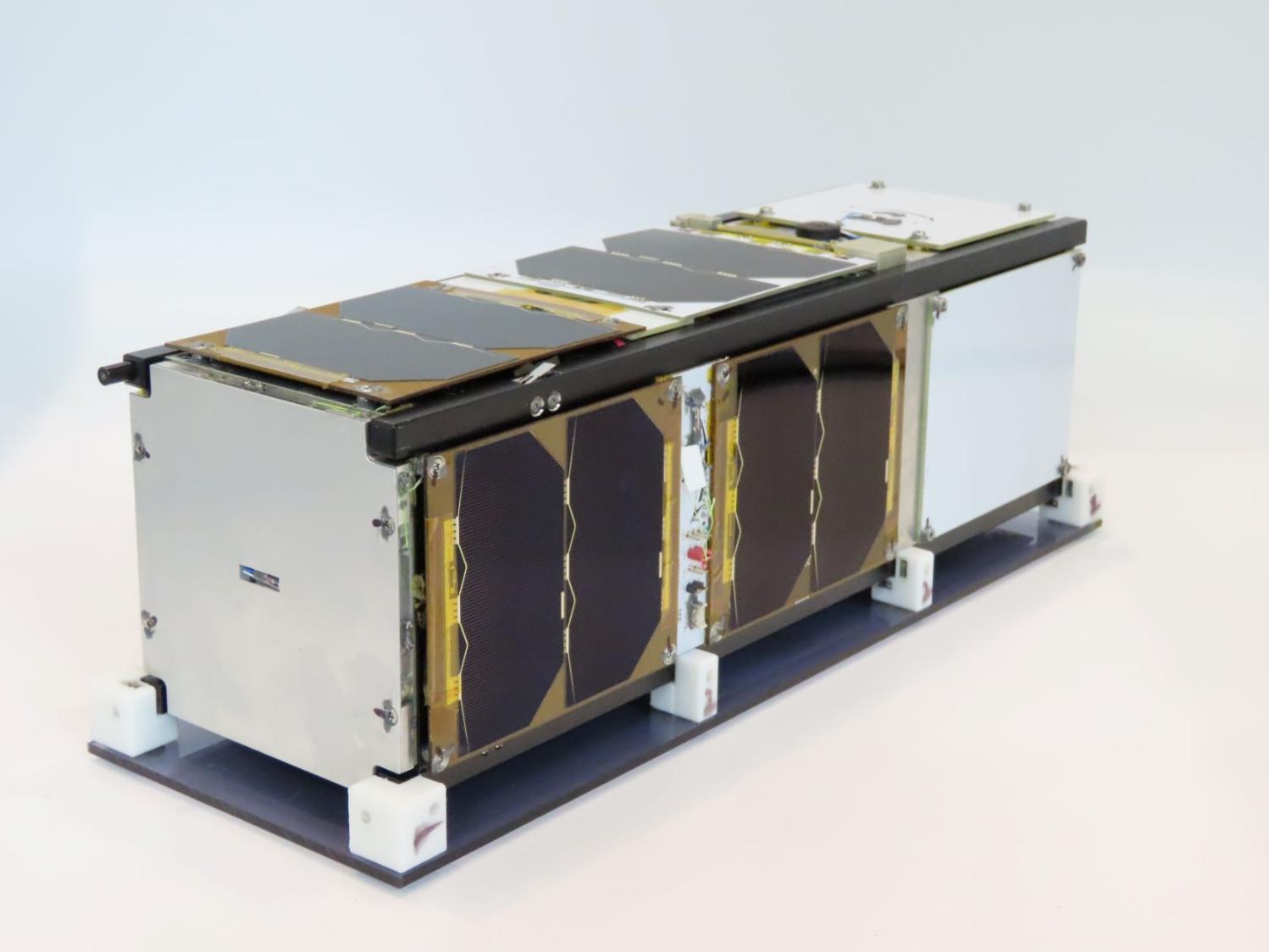
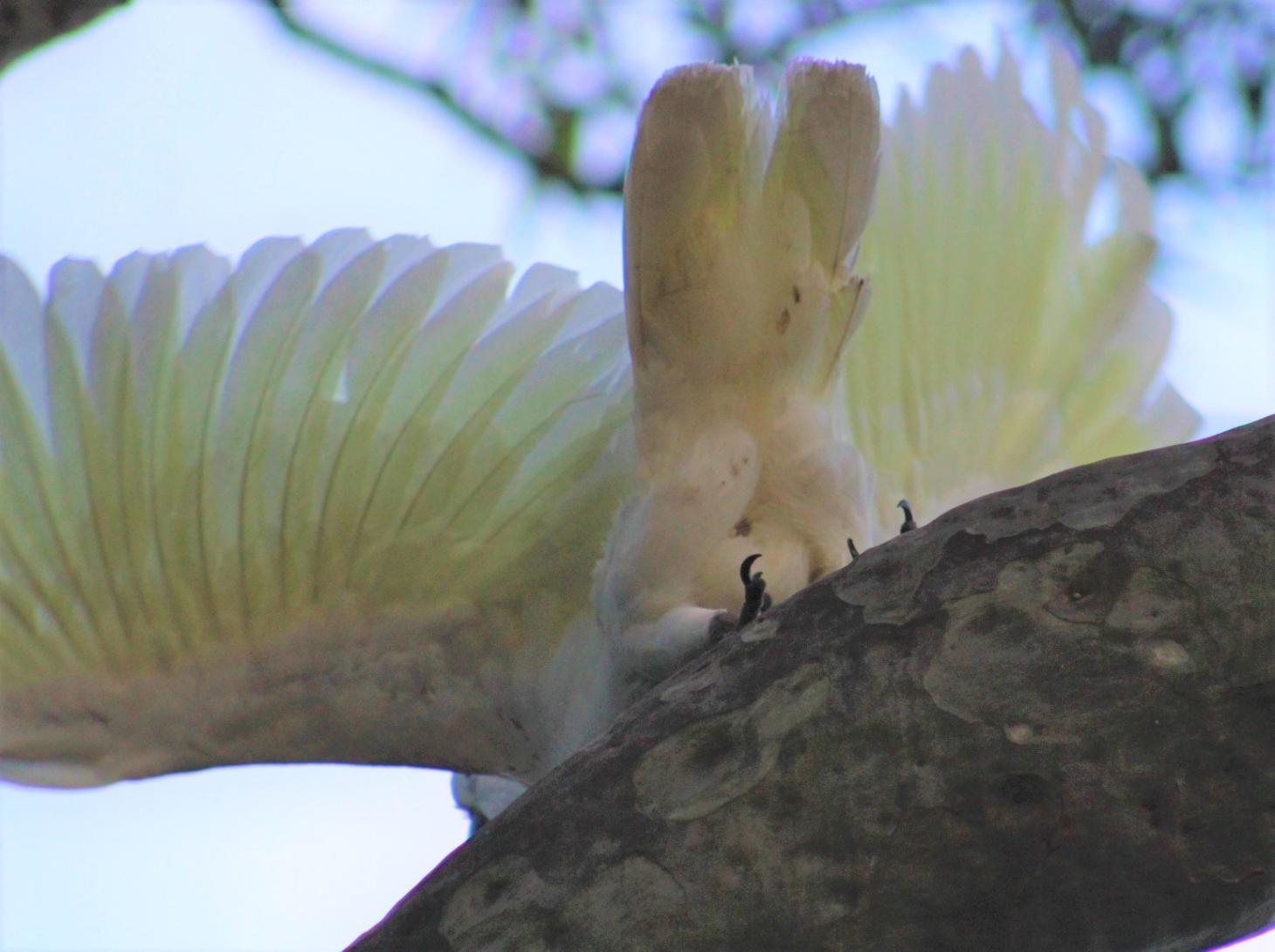
Ficus Rubiginosa - Damun (Gadigal), Port Jackson Fig; Must See September 2021
Published August 31, 2021 by the Royal Botanic Gardens and Domain
Starting life on rocks or sometimes attached to trees this locally occurring fig tree can grow to thirty metres tall with a broad shade giving canopy. Find out more with horticulturist and manager of volunteer programs, Botanic Gardens Greater Sydney, Paul Nicholson.
From bespoke seats to titanium arms, 3D printing is helping paralympians gain an edge
James Novak, The University of Queensland and Andrew Novak, University of Technology SydneyMajor sporting events like the Paralympics are a breeding ground for technological innovation. Athletes, coaches, designers, engineers and sports scientists are constantly looking for the next improvement that will give them the edge. Over the past decade, 3D printing has become a tool to drive improvements in sports like running and cycling, and is increasingly used by paralympic athletes.
The Paralympics features athletes with a diverse range of abilities, competing in a wide range of different categories. Many competitors use prosthetics, wheelchairs or other specialised components to enable them to perform at their best.
One interesting question is whether 3D printing widens or narrows the divide between athletes with access to specialised technologies, and those without. To put it another way, does the widespread availability of 3D printers — which can now be found in many homes, schools, universities and makerspaces — help to level the playing field?
Forget Mass Production
Mass-manufactured equipment, such as gloves, shoes and bicycles, is generally designed to suit typical able-bodied body shapes and playing styles. As such, it may not be suitable for many paralympians. But one-off, bespoke equipment is expensive and time-consuming to produce. This can limit access for some athletes, or require them to come up with their own “do-it-yourself” solutions, which may not be as advanced as professionally produced equipment.
3D printing can deliver bespoke equipment at a more affordable price. Several former paralympians, such as British triathlete Joe Townsend and US track athlete Arielle Rausin, now use 3D printing to create personalised gloves for themselves and their fellow wheelchair athletes. These gloves fit as if they were moulded over the athlete’s hands, and can be printed in different materials for different conditions. For example, Townsend uses stiff materials for maximum performance in competition, and softer gloves for training that are comfortable and less likely to cause injury.
3D-printed gloves are inexpensive, rapidly produced, and can be reprinted whenever they break. Because the design is digital, just like a photo or video, it can be modified based on the athlete’s feedback, or even sent to the nearest 3D printer when parts are urgently needed.
Read more: Paralympians still don’t get the kind of media attention they deserve as elite athletes
Harder, Better, Faster, Stronger
An elite athlete might be concerned about whether 3D-printed parts will be strong enough to withstand the required performance demands. Fortunately, materials for 3D printing have come a long way, with many 3D printing companies developing their own formulas to suit applications in various industries - from medical to aerospace.
Back in 2016, we saw the first 3D-printed prosthetic leg used in the Paralympics by German track cyclist Denise Schindler. Made of polycarbonate, it was lighter than her previous carbon-fibre prosthetic, but just as strong and better-fitting.
With research showing sprint cyclists can generate more than 1,000 Newtons of force during acceleration (the same force you would feel if a 100-kilogram person were to stand on top of you!), such prosthetics need to be incredibly strong and durable. Schindler’s helped her win a bronze medal at the Tokyo games.
More advanced materials being 3D printed for Paralympic equipment include carbon fibre, with Townsend using it to produce the perfect crank arms for his handbike. 3D printing allows reinforced carbon fibre to be placed exactly where it is needed to improve the stiffness of a part, while remaining lightweight. This results in a better-performing part than one made from aluminium.
3D-printed titanium is also being used for custom prosthetic arms, such as those that allow New Zealand paralympian Anna Grimaldi to securely grip 50kg weights, in a way a standard prosthetic couldn’t achieve.
Different Technologies Working Together
For 3D printing to deliver maximum results, it needs to be used in conjunction with other technologies. For example, 3D scanning is often an important part of the design process, using a collection of photographs, or dedicated 3D scanners, to digitise part of an athlete’s body.
Such technology has been used to 3D-scan a seat mould for Australian wheelchair tennis champion Dylan Alcott, allowing engineers to manufacture a seat that gives him maximum comfort, stability and performance.
3D scanning was also used to create the perfect-fitting grip for Australian archer Taymon Kenton-Smith, who was born with a partial left hand. The grip was then 3D-printed in both hard and soft materials at the Australian Institute of Sport, providing a more reliable bow grip with shock-absorbing abilities. If the grip breaks, an identical one can be easily reprinted, rather than relying on someone to hand-craft a new one that might have slight variations and take a long time to produce.
Read more: 3 reasons why Paralympic powerlifters shift seemingly impossible weights
All these technologies are increasingly accessible, meaning more non-elite athletes can experiment with unique parts. Amateurs and professionals alike can already buy running shoes with 3D-printed soles, and 3D-printed custom bike frames. For those with access to their own 3D printer, surf fins, cycling accessories and more can be downloaded for free and printed for just a few dollars.
However, don’t expect your home 3D printer to be making titanium parts anytime soon. While the technology is levelling the playing field to a certain extent, elite athletes still have access to specialised materials and engineering expertise, giving them the technological edge.
_This article was coauthored by Julian Chua, a sports technology consultant at ReEngineering Labs and author of the Sports Technology Blog.![]()
James Novak, Senior Research Fellow and Adjunct Lecturer, The University of Queensland and Andrew Novak, Senior Research Fellow, University of Technology Sydney
This article is republished from The Conversation under a Creative Commons license. Read the original article.
What art are you engaging with in lockdown? Australians are mostly watching TV — but music, singing and dancing do more for your mood

How have you been passing the time during lockdown? Have you been taking an online drawing class, or did you join an online choir? Perhaps you focused on gardening, or finally picked up that guitar in the corner to have a go?
We have long known creative activities help us cope during hard times. Engaging with the arts enhances physical and mental well-being, can boost our sense of accomplishment and meaning, and strengthen our resilience to cope with life’s challenges.
The arts help give life beauty.
So we wanted to explore how Australians turned to art during lockdowns in 2020. We wanted to know which art forms most appealed to Australians, and which ones were helping Australians cope with the lows of lockdown.
In our newly published research, we found many Australians improved their mood using the arts. But the activities we turned to the most frequently weren’t necessarily the ones which could most improve our sense of well-being.
What Makes Us Feel Better?
In an online survey, we asked Australians which artistic creative activities they had been undertaking during the lockdown, and which activities they normally participated in but weren’t under lockdown.

We also asked our participants to rank their activities from most to least effective at making them “feel better”. Measures for anxiety, depression, loneliness and emotion regulation were taken to help us identify any relationships between mental health and well-being and arts engagement.
The most popular activities were watching films and television, listening to music and cooking and baking. Listening to music was ranked as the most effective activity at making our participants feel better — but watching films and television ranked more than halfway down the list, at 18 out of 27.
Read more: Great time to try: baking sourdough bread
Of the most effective activities, singing took second place and dancing came in third.
The Power Of Music
Three of the four most frequently undertaken activities (watching films and television, listening to music and reading) are usually considered passive or receptive activities: engaging with the artistic creation of others, rather than creating our own new art.
It comes as little surprise the most prevalent activities were receptive ones, since they could be easily done from home. But passive activities were often not the ones which were effective in helping us through trying times.
Active arts activities are beneficial partly because they involve seeking out novel ideas, experiences and possibilities, which in turn have positive cognitive, physical, emotional and social effects.
Read more: Great time to try: learning to draw
But listening to music seemed to be different from other passive arts activities.
Music has long been regarded as an effective coping tool. We use music to regulate our emotions and to create a refuge for healing and imaginative play.

Listening to music can also accompany daily activities such as cooking or doing household chores much better than activities such as watching television or reading. Some of music’s well-being benefits may originate in this combination of aesthetic and practical elements.
We also found anxious and depressed Australians seem to be turning to music as a coping mechanism or emotional crutch significantly more than others. People often report specifically listening to sad music to help improve their mood.
While this might seem counter intuitive, listening to sad music while in a negative state can produce a positive outcome as a form of processing or catharsis.
(However, people living with depression should approach listening to sad or negative music with caution. Emerging research indicates those with clinical depression may find the outcome of sad music to be more negativity instead of positive release.)
Get Up And Moving
Participants who reported exercising more during the pandemic compared to their pre-pandemic routine fared significantly better in terms of mental health and well-being compared to those undertaking less or the same amount of exercise than prior to the pandemic.
This finding supports a growing body of research showing increased physical activity during lockdown is a robust method for maintaining mental wellness.
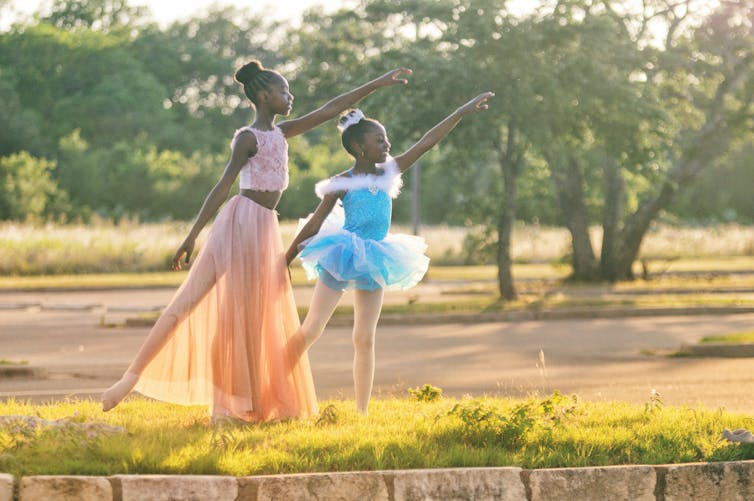
It also indicates why participants found dancing to be so beneficial. Not only is dance a form of artistic expression, it can be more effective than other forms of exercise at reducing body fat and is linked to numerous physical and psychological benefits.
Sadly, dancing was the activity most likely to have ceased under lockdown, followed by theatre rehearsals and performances, and singing.
Your Own Artistic Helper
There are clear public health and safety reasons for why so many people had to stop dancing, singing and making theatre during the COVID-19 pandemic. But these activities are very effective in helping us navigate difficult times.
Read more: Great time to try: knitting your first woolly scarf
With this in mind, artistic creative activities — and in particular active activities such as singing and dancing — warrant additional support and consideration as an important and efficient aspect of Australia’s mental health response to COVID.
For those interested in incorporating singing and dancing into your lockdown routines, there is no shortage of inspiration for how to do so online. The arts always seem to find a way.![]()
Frederic Kiernan, Research Fellow, Creativity and Wellbeing Hallmark Research Initiative, The University of Melbourne; Anthony Chmiel, Postdoctoral Research Fellow at the MARCS Institute for Brain, Behaviour and Development, Western Sydney University, and Jane Davidson, Deputy Director ARC Centre of Excellence for the History of Emotions, The University of Melbourne
This article is republished from The Conversation under a Creative Commons license. Read the original article.
Yes, audiobooks count as ‘real reading’. Here are 3 top titles to get you started

Audiobook listening has been called a “silent revolution” in the publishing industry over the last decade. The US audiobook market is estimated to be worth US$1.1 billion annually and is growing at a rate of more than 10% each year. Industry insiders say this is a fresh market, with 37% of Australian audiobook listeners only taking up the habit in the last year.
Audiobook downloads (up 15% on the previous year) were part of a pandemic boost for publisher revenues. Some are read by the authors themselves or by famous actors including Elizabeth Moss and Tom Hanks.
But are listeners really reading? If we challenge what we think we know about reading, audiobooks can be seen as not just a cheat’s shortcut for catching up on classics and bestsellers, but a new way to engage more people with stories.
Read more: How reading aloud can be an act of seduction
From Vinyl To Digital
Audiobooks are not new. The term refers to any authored print book vocalised through a variety of technologies — from records through to cassette players, and CDs. Digitally downloaded or streamed audiobooks have added a new dimension to this heritage technology, traditionally viewed as a compensatory tool for visual impairment or reading difficulties such as dyslexia and the rarer condition of alexia.
The surge in audiobook sales is likely a halo effect of the huge popularity of podcasts. But audiobooks are single-voiced, immersive listening experiences. Audiobooks do not include book-length texts “read” by an automated voice.
Audible (owned by Amazon) dominates the audiobook market and is now getting into the “original audiobook” game, meaning they produce the audio version rather than a book publisher. Other services offer “born audio” productions. Storytel Originals bypass print as the starting point in the traditional book publishing cycle.
Librivox — a site dedicated to making “all books in the public domain available, narrated by real people and distributed for free” emerged from a group of friends reading aloud from Joseph Conrad’s The Secret Agent. It draws its 15,000 titles from Project Gutenburg’s 60,000 free ebooks.
Unlike the commercial services, with narration and soundscapes on par with radio drama productions, the quality of Librivox audiobooks is highly variable. There are excellent recordings and “readings that sound as if they come from your worst nightmare of community theatre — either monotone or way over the top”, according to one LA Times reviewer.

How We Read
Reading is a complex process. Rather than a single cognitive act of decoding, we know from imaging technologies that reading engages several discrete actions within the brain’s visual region. When the reader encounters an irregular letter-sound relationship, neurologist Stanislas Dehaene tells us the auditory brain region fires up as well.
When reading, we engage a bundle of brain skills that have evolved over centuries if not millennia. A recent study used fMRI scans to show people generate word meaning in the same way whether they see it or hear it.
Though reading is still usually thought of as a stationary, silent and solo practice, there is a long tradition of reading communally and aloud. This is not only reading by adults to children, but also among adults.
Streamed audiobooks available through smartphones enable reading-as-listening while mobile. The kinetic dimension of reading-as-listening while moving through space, commuting, walking or while driving is yet to be fully understood.

Read more: Books offer a healing retreat for youngsters caught up in a pandemic
New Reading, Old Storytelling
Audiobooks challenge established practices and assumptions about reading, but also remind us of the oral cultures of storytelling from which print cultures developed.
In Australia, streamed audiobook listening might offer a 21st century way of celebrating the affective, imaginative and kinetic dimensions of the Indigenous songlines that criss-cross the continent, either by remediating print books or bypassing the written form altogether.
Listening to audiobooks may help to close the gender gap common with reading literature. The Reading the reader report from Macquarie University found that more than 60% of “frequent readers” are women. Of “non-readers”, three quarters are men. Yet, men and women are equally likely to consume digital format books such as ebooks and audiobooks. Audiobooks may inspire more male readers to participate in bookclubs, which traditionally involve more women than men.

Read more: Freud, Nietzsche, Paglia, Fanon: our expert guide to the books of The White Lotus
Audiobooks could also be used more in higher education. Princeton University Press recently announced the release of their PUB audio series, signalling new educational formats for scholars and students.
Rather than being one act for one purpose, literacy researcher Sam Duncan argues reading is a bigger umbrella than we may have previously realised, under which sits a diversity of practices, involving different “skills, challenges and pleasures”.
Listening-as-reading to vocalisations of books enables a level of imaginative and affective engagement that should not be diminished by our traditional assumptions.
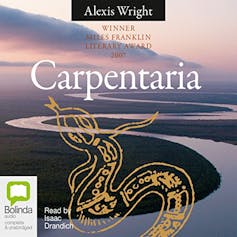
Here Are Three Great Books To Listen To:
1. Carpentaria By Alexis Wright
The audiobook of Alexis Wright’s epic Carpentaria, is narrated by Noongar actor and dramaturg Isaac Drandich. Using a range of voices, he offers the reader-as-listener an enhanced experience.
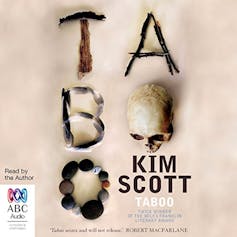
2. Taboo By Kim Scott
Reading his own book, Kim Scott’s gentle voice animates his sparse prose style beautifully.
The novel dramatises a brutal past event and its present day reckoning.
3. The Odyssey By Homer. Translated By Emily Wilson.
Claire Danes’s vocalising of Emily Wilson’s translation brings this ancient text into the contemporary world through plain speaking and her emphasis on satellite characters. ![]()
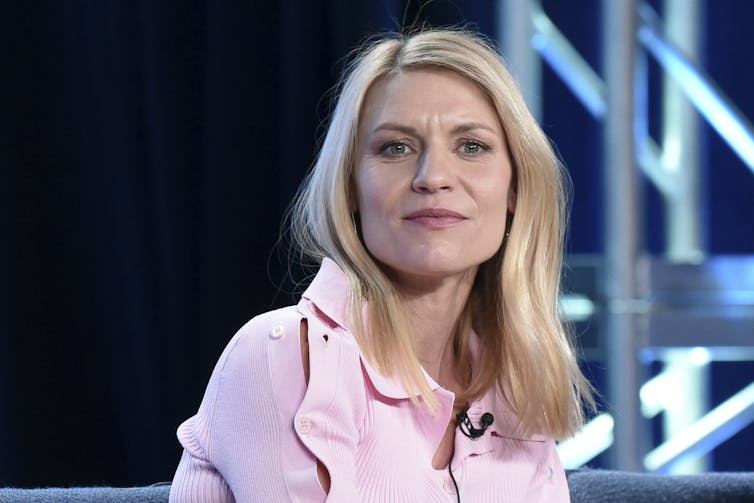
Brigid Magner, Senior Lecturer in Literary Studies, RMIT University and Linda Daley, Senior lecturer, RMIT University
This article is republished from The Conversation under a Creative Commons license. Read the original article.
Friday essay: 10 photography exhibitions that defined Australia

Australians have always loved photography exhibitions. They are consistently among the most well attended at our museums and galleries, and have formed an important part of our cultural landscape since the middle of the 19th century.
Our research reveals a fascinating history of encounters, spaces, and techniques of display — hidden in more conventional accounts that focus on famous photographers and iconic images.
Here are ten exhibitions that represent some key chapters in this history.
Read more: Ten photos that changed how we see human rights
1. J. W. Newland’s ‘Daguerrean Gallery’, Sydney, 1848
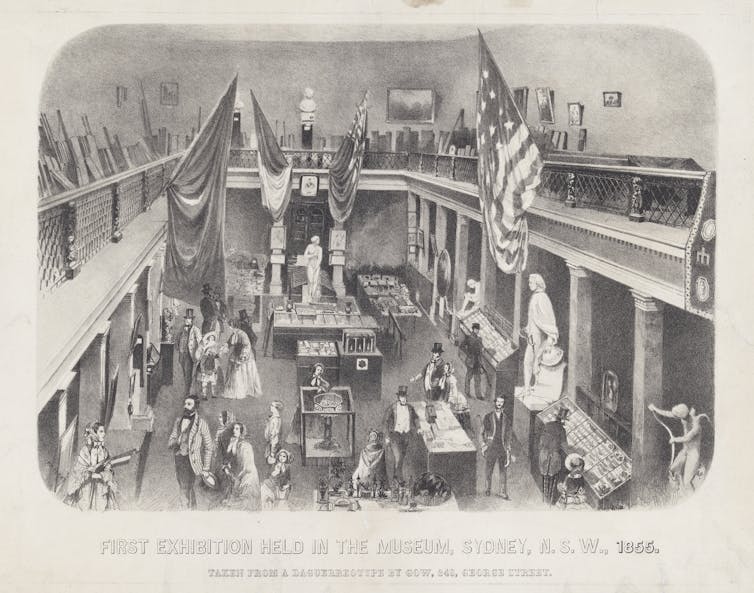
Visitors to Australia’s first photography exhibition in 1848 climbed the steps above a wine and spirits store in the centre of Sydney to the studio of J. W. Newland. He had just arrived with 200 daguerreotypes made during an almost three-year journey from New Orleans, thorough Central and South America, across the Pacific to New Zealand, and finally to Sydney.
In delicate images formed on polished silver plates ranging from the size of an iPad to an iPhone, visitors saw “views” of other great Pacific ports such as Peru’s Callao, “specimens” of various Indigenous people, and “likenesses” of celebrities they had only read about in newspapers. These included Queen Pomare IV of Tahiti who had famously become caught up in French and British colonial rivalry.
Visitors could also have their own portrait taken for the gallery, joining the other daguerreotypes Newland advertised as covering “two thirds of the globe”.
2. The Australian Intercolonial Exhibition, Melbourne, 1866
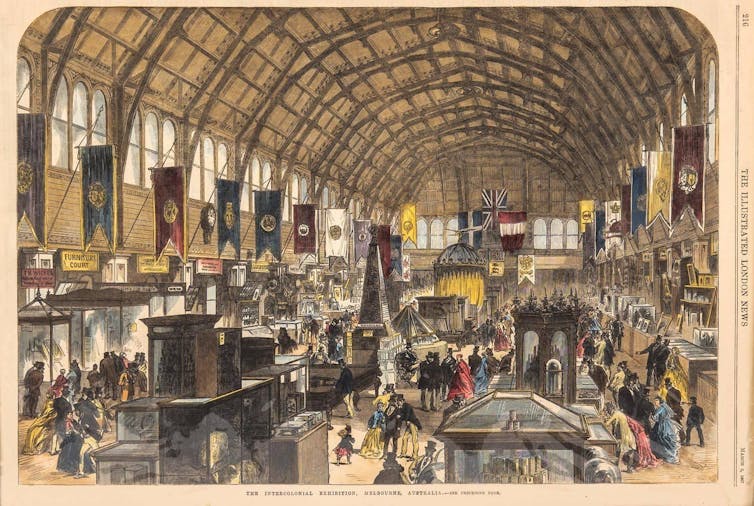
In 1866, where Victoria’s State Library now stands, two purpose-built, timber exhibition halls were filled with commodities from ten Australasian colonies for the first Intercolonial Exhibition. The hundreds of photographs crammed between the profusion of the displays were such an important component they attracted their own review from the now defunct Australian Monthly Magazine.
This “wanderer amongst the photographic views” thought they exhibited “the high standard of taste to which we, as inhabitants of new colonies, have arrived”. Like the pyramidal “trophies” of canned foods and confectionery placed throughout the exhibition spaces, the photographs visualised and quantified colonial prosperity.
Scale and spectacle were everything. Many views of the new colonial buildings were contact printed from glass plate negatives 25 x 30 cm in size, and one multi-panelled panorama of Sydney stretched over a metre in length. Viewers could peer into the binocular lenses of a stereoscope, which enabled them to see a number of paired images taken from slightly different angles as a sequence of 3D views of Hobart.
3. Harold Cazneaux’s ‘One Man Show’, Photographic Society Of New South Wales, Sydney, 1909
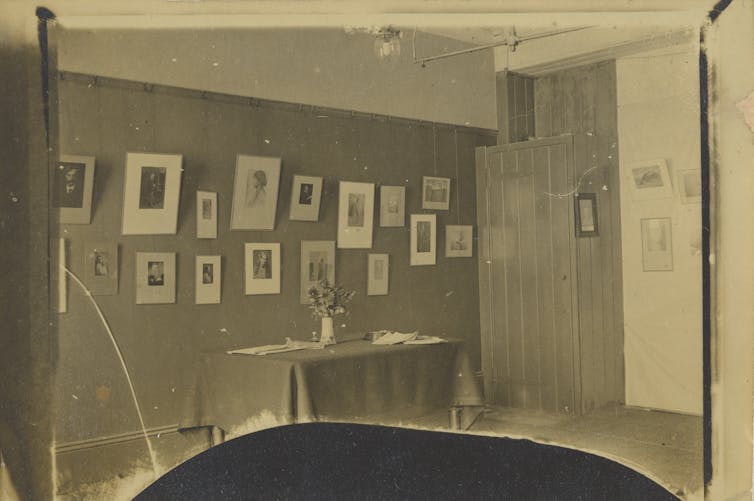
At the turn of the 19th century, Australian photography was transformed by the self-consciously artistic style of Pictorialism. In 1909, one of its emergent figures, Harold Cazneaux, held the first solo show by an individual Australian photographer.
Its 26 portraits, landscapes, seascapes, harbour scenes and “picturesque city corners” showed what “any energetic cameraist can secure in his lunch hour, if he is gifted with the ‘seeing eye’.”
Cazneaux proudly documented the tasteful installation of his show in the Sydney rooms of the Photographic Society of New South Wales. Each print was individually mounted behind a wide cardboard mat in an elegant frame and numbered, referring to a catalogue on a table beneath a vase of flowers. Cazneaux had set the template for thousands of photographers’ shows to come.
4. Wolfgang Sievers And Helmut Newton’s New Visions In Photography, Federal Hotel, Melbourne, 1953
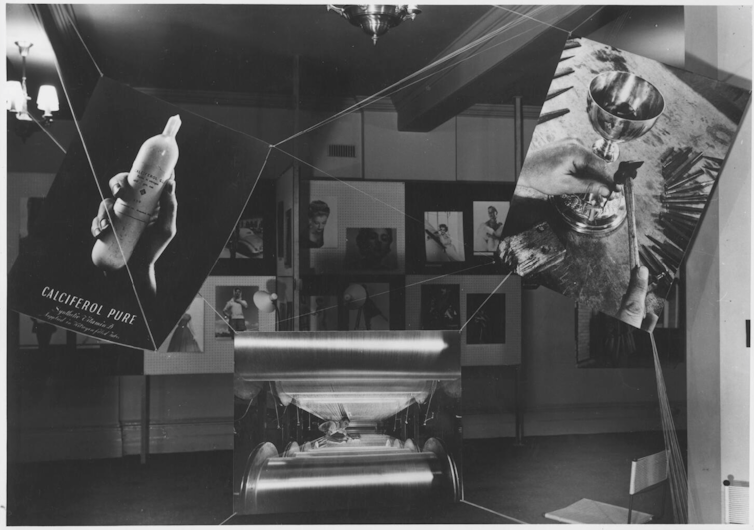
Staged over five days at the Federal Hotel on Melbourne’s Collins Street in 1953, Wolfgang Sievers and Helmut Newton declared the bold aim of New Visions in Photography in an introductory wall panel. It was “to demonstrate … the potential of industrial and fashion photography as a means of better promotion and bigger sales”.
The two German émigrés embodied a dramatically new approach to the photograph. Sievers’ industrial and architectural studies and Newton’s fashion images both exploited radical vantage points and close-ups to produce bold, graphic compositions in sharp, high contrast black and white — reflecting Australia’s emergence as a modern nation.
The magazine-like display matched the formal qualities of the photographs. Instead of framed images in a row, enlarged unframed photographs were presented on white pegboard and suspended in the air by fine thread, sometimes at radical angles.
This dramatic sculpting of space in the old hotel underscored Sievers and Newton’s belief in photography’s potential to make the world anew.
5. Urban Woman, Melbourne Town Hall, 1963
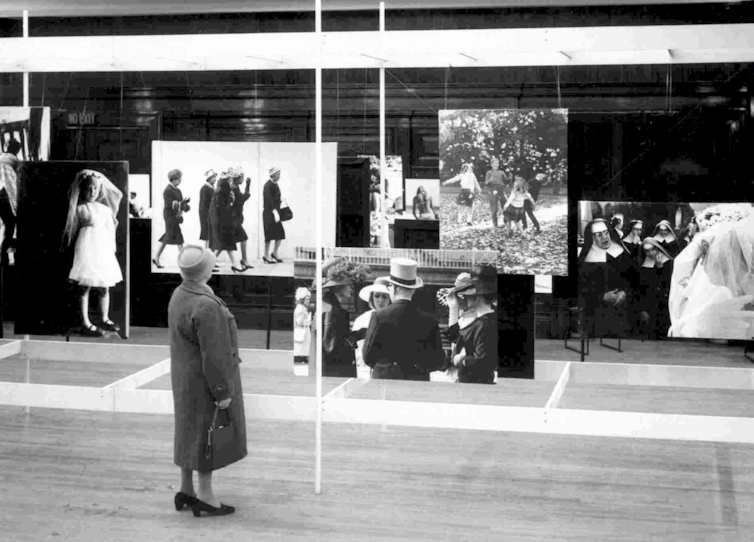
Urban Woman was the most ambitious and accessible exhibition by a collective of Melbourne-based amateur photographers including Albert Brown, George Bell, Roy McDonald and John Crook who called themselves Group M. Earnest teachers and chemists, they were inspired by the tradition of social documentary.
Urban Woman comprised over 200 mostly candid, long, focal length images by 13 photographers (all male), selected by designer Max Forbes. Inspired by the photographers’ observation of the “loneliness” of young suburban mothers, they aimed “to confront reality with an unprejudiced eye”.
The fact that an exhibition about women was made exclusively by men went unnoticed in the significant press coverage it attracted.
Conceived as a direct response to the international blockbuster The Family of Man, which toured to Australia in 1959, Urban Woman appealed to similar humanist sentiment. Its design featured purpose-built wooden structures to display huge, unframed prints, with subjects arranged from youth to old age.
6. Frontiers, National Gallery Of Victoria, 1971

The National Gallery of Victoria became the first Australian gallery to establish a department of photography in 1967, despite opposition from some trustees (one of whom referred to photography as a “cheat’s way of doing a painting”). At the time, it was one of only a handful of such departments in the world.
Frontiers featured the experimental and abstract photography of John Cato, Peter Medlen, Stanislaus Ostoja-Kotkowski, Mark Strizic and John Wilkins. All-male photography exhibitions remained common until the pioneering exhibitions of feminist photographers such as Sue Ford and Carol Jerrems in the mid-1970s.
The work in Frontiers was self-consciously contemporary, even psychedelic. Cato’s environmental protest work comprised 52 prints installed on crimson screens with strobe lighting. Ostoja-Kotkowski’s light transparencies, formed by laser beams and infra-red, were backlit from spotlights mounted on the ceiling. Strizic presented a 10-metre colour mural (later destroyed due to chronic fading).
7. William Yang, Sydneyphiles, Australian Centre For Photography, 1977
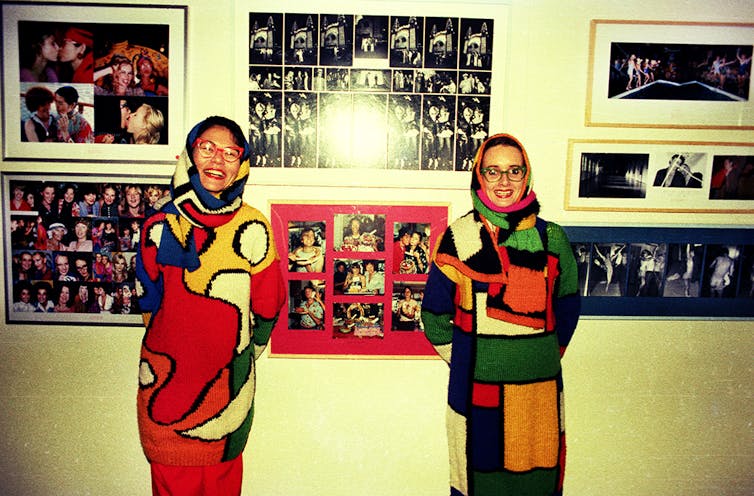
In 1977, William Yang used the walls of the new Australian Centre for Photography for a diaristic exhibition, Sydneyphiles. This was Yang’s first exhibition, in which his small scale colour and black and white photographs of Sydney’s gay community and its art, fashion and socialite scenes were hung closely alongside and above each other to cover the walls like a giant personal scrapbook.
Sydneyphiles is significant for reasons beyond its controversial sexual content. It was an early example of the Centre moving beyond a more conventional framed black and white modernist tradition.
It is likely the first exhibition by an Asian-Australian photographer, and it included its community as part of the event (the press release notes Yang “invited many of the subjects of his photography” to his exhibition). Yang later said the exhibition “launched me as a photographer”.
8. National Aboriginal And Islander Photographers Exhibition, Aboriginal Artists Gallery, Sydney, 1986
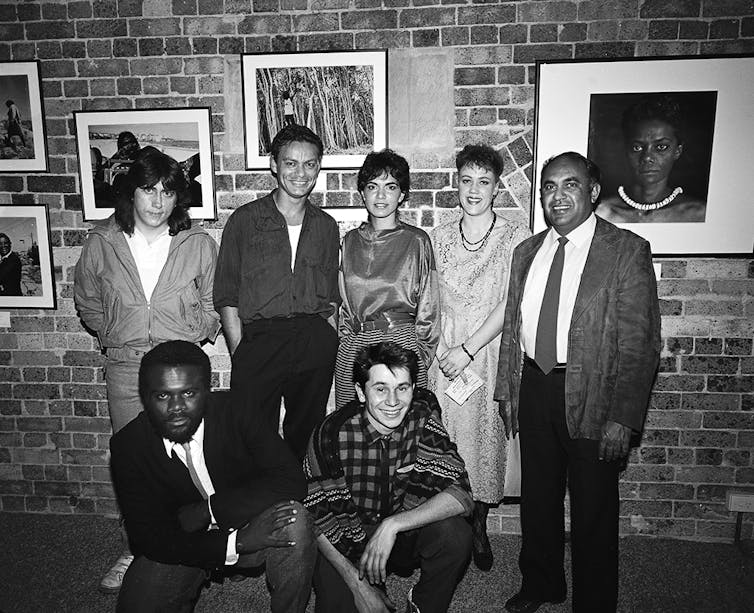
The first exhibition in which Aboriginal people had control over their own photographs took place in 1986 during what is now known as NAIDOC week. On the raw brick walls of Sydney’s Aboriginal Artists Gallery, ten Indigenous photographers hung their exhibition.
They included Mervyn Bishop, Australia’s first Aboriginal press photographer, and others such as Brenda L. Croft, Michael Riley and Tracey Moffatt, who went on to become important figures in Australian art.
The show featured photographs that later became touchstones, such as Moffatt’s portrait of actor David Gulpilil relaxing at Bondi beach in board shorts and face paint.
It was an immediate success, as Moffatt ruefully commented: “To be honest, we got the kind of publicity which makes me want to vomit; e.g. ‘they’re Aborigines, they’re articulate, and gee whizz, they take good pictures’ sort of stuff. I guess I shouldn’t complain because we got a lot of people coming through looking at the show and buying work, which is what we do like!”
9. Photography Is Dead! Long Live Photography!, Museum Of Contemporary Art, Sydney, 1996

In 1996, as the medium was being transformed by the impact of digital photography, the Museum of Contemporary Art mounted Photography Is Dead! Long Live Photography! For curator Linda Michael its 32 exhibitors were “artists using photography”, not photographers per se. They saw photographs not as transparent windows onto the world, but as a material within themselves.
Some large unframed prints were suspended to curl delicately out from the wall, others were bonded onto aluminium for an industrial look; some were expressionistically cut up, others were physically sculpted.
Some — such as Jane Eisemann’s surrealist imagery and Patricia Piccinini’s glossy advertising style portraits of a celebrity starlet holding a genetically modified pet — were digitally produced, with computer manipulation an intrinsic part of their meaning.
10. Hoda Afshar’s Remain, The Substation, Melbourne, 2019

Photographs have long appeared in public space in the form of corporate messaging. They can be projections or billboards. To offer different messages, Tehran-born, Melbourne-based artist Hoda Afshar is one of many who have taken advantage of inexpensive, large-scale printing to give voice to the experiences of marginalised people.
In 2019 Afshar presented her striking, collaboratively-produced portraits of asylum seekers incarcerated by the Australian Government on Manus Island on 2.4-metre-high billboards along the train line that skirts The Substation in the western Melbourne suburb of Newport.
The Christ-like image of the Iranian journalist Behrouz Boochani was already becoming iconic, having won a major photography prize and circulated in newspapers and Afshar’s Instagram account (arguably the most important site for photography today).
But the public display amplified the political potency of her ghostly black-and-white portraits to new audiences. As she has said, “When you make a socially and politically engaged work, the intention is to communicate with the people”.
These moments are drawn from our book Installation View: Photography Exhibitions in Australia (1848-2020) published by Perimeter Editions in 2021.![]()
Daniel Palmer, Professor, School of Art, RMIT University and Martyn Jolly, Honorary Associate Professor, School of Art and Design, Research School of Humanities and the Arts, College of Arts and Social Sciences, Australian National University
This article is republished from The Conversation under a Creative Commons license. Read the original article.
Boomers vs millennials? Free yourself from the phoney generation wars

Generational thinking is a big idea that’s been horribly corrupted and devalued by endless myths and stereotypes. These clichés have fuelled fake battles between “snowflake” millennials and “selfish” baby boomers, with younger generations facing a “war on woke” and older generations accused of “stealing” the future from the young.
As I argue in my book, Generations, this is a real shame. A more careful understanding of what’s really different between generations is one of the best tools we have to understand change – and predict the future.
Some of the great names in sociology and philosophy saw understanding generational change as central to understanding society overall. Auguste Comte, for example, identified the generation as a key factor in “the basic speed of human development”.
He argued that “we should not hide the fact that our social progress rests essentially upon death; which is to say that the successive steps of humanity necessarily require a continuous renovation … from one generation to the next”. We humans get set in our ways once we’re past our formative years, and we need the constant injection of new participants to keep society moving forward.
Understanding whether, and how, generations are different is vital to understanding society. The balance between generations is constantly shifting, as older cohorts die out and are replaced by new entrants. If younger generations truly do have different attitudes or behaviours to older generations, this will reshape society, and we can, to some extent, predict how it will develop if we can identify those differences.
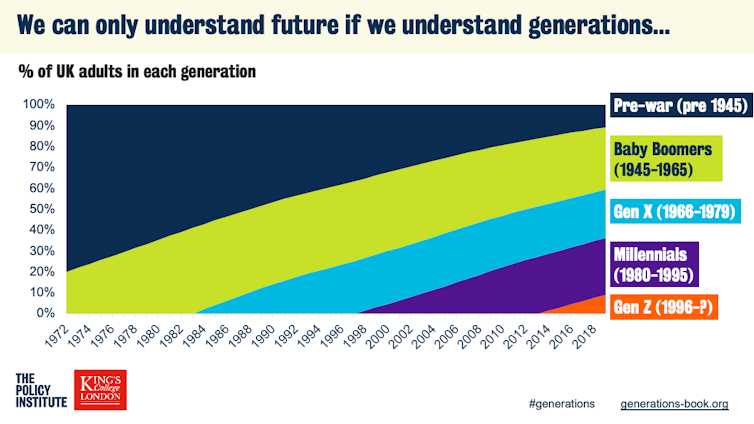
But in place of this big thinking, today we get clickbait headlines and bad research on millennials “killing the napkin industry” or on how baby boomers have “ruined everything”. We’ve fallen a long way.
Myth Busting
To see the true value of generational thinking, we need to identify and discard the many myths. For example, as I outline in the book, gen Z and millennials are not lazy at work or disloyal to their employers. They’re also no more materialistic than previous generations of young: a focus on being rich is something we tend to grow out of.
Old people are not uncaring or unwilling to act on climate change: in fact, they are more likely than young people to boycott products for social purpose reasons.
And our current generation of young are not a particularly unusual group of “culture warriors”. Young people are always at the leading edge of change in cultural norms, around race, immigration, sexuality and gender equality. The issues have changed, but the gap between young and old is not greater now than in the past.
Meanwhile, there are real, and vitally important, generational differences hidden in this mess. To see them, we need to separate the three effects that explain all change in societies. Some patterns are simple “lifecycle effects”, where attitudes and behaviours are to do with our age, not which generation we are born into. Some are “period effects” – where everyone is affected, such as in a war, economic crisis or a pandemic.
And finally, there are “cohort effects”, which is where a new generation is different from others at the same age, and they stay different. It’s impossible to entirely separate these distinct forces, but we can often get some way towards it – and when we do, we can predict the future in a much more meaningful way.

There are many real generational differences, in vitally important areas of life. For example, the probability of you owning your own home is hugely affected by when you were born. Millennials are around half as likely to be a homeowner than generations born only a couple of decades earlier.
There is also a real cohort effect in experience of mental health disorders, particularly among recent generations of young women. Our relationship with alcohol and likelihood of smoking is also tied to our cohort, with huge generational declines in very regular drinking and smoking. Each of these point to different futures, from increased strain on mental health services to declining alcohol sales.
But lifecycle and period effects are vitally important too. For example, there is truth in the idea that we grow more conservative as we age. One analysis suggests that this ageing effect is worth around 0.35% to the Conservatives each year, which may not sound like a lot, but is very valuable over the course of a political lifetime.
And, of course, the pandemic provides a very powerful example of how period effects can dramatically change things for us all.
Reaching Beyond The Avocado
When there is such richness in the realities, why are there so many myths? It’s partly down to bad marketing and workplace research – that is, people jumping on the generation bandwagon to get media coverage for their products or to sell consultancy to businesses on how to engage young employees.
This has become its own mini-industry. In 2015, US companies spent up to US$70 million (£51 million) on this sort of “advice” according to the Wall Street Journal, with some experts making as much as US$20,000 an hour. Over 400 LinkedIn users now describe themselves solely as a “millennial expert” or “millennial consultant”.
Campaigners and politicians also play to these imagined differences. Our increasing focus on “culture wars” often involves picking out particular incidents in universities, such as the banning of clapping at events or the removal of a portrait of the Queen to exaggerate how culturally different young people today are.
Maybe less obviously, politicians such as former US President Barack Obama repeatedly lionise coming generations as more focused on equality, when the evidence shows they’re often not that different. These assertions are not only wrong, but create false expectations and divides.
Some have had enough, calling on the Pew Research Center in the US, which has been a champion of generational groups, to stop conducting this type of analysis. I think that misses the point: it’s how it’s applied rather than the idea of generations that’s wrong.
We should defend the big idea and call out the myths, not abandon the field to the “millennial consultants”.![]()
Bobby Duffy, Professor of Public Policy and Director of the Policy Institute, King's College London
This article is republished from The Conversation under a Creative Commons license. Read the original article.
We asked 9,000 Australians about their mental health needs post-COVID — this is what they want

The COVID-19 pandemic has taken an enormous toll on people’s mental health around the world.
Even in Australia, where the numbers of those infected, hospitalised, and dying from COVID-19 have been much lower than in most other countries, our research has shown the mood of the population has been badly affected by lockdowns and restrictions on freedoms.
This in turn can make it harder for people to work and participate in society. That’s why policy makers need to turn their attention to what they can do to support people as they adapt to life in a COVID-normal world.
Findings from our new survey research offer important clues to what people think will help them adjust.
Our Research
In 2020 we conducted two anonymous online surveys of Australians over 18 about their experiences of living with COVID 19 and their mental health. The first was launched in April, just after nationwide COVID-19 restrictions began. The second was done in August when restrictions had eased except in Victoria.
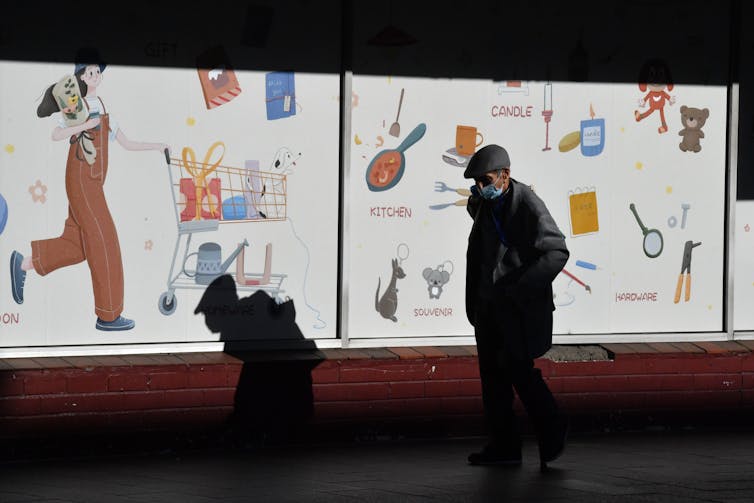
In the second survey we included a list of 16 potential policies and asked respondents to tell us which ones would help them recover from the COVID-19 restrictions.
They included policies around mental health, financial support, employment assistance, access to telehealth, support for community organisations, and government management of future pandemics.
What We Found
More than 13,000 people completed the first survey.
This showed more than one in four had significant symptoms of depression and more than one in five had significant symptoms of anxiety during the first month of COVID restrictions. This was at least double the rates of non-COVID times.
The second survey was completed by more than 9,000 people. We were surprised to find people who lived in parts of the country where restrictions had eased were not feeling much better than they did at the time of the first survey. Less surprising was people in locked-down Victoria were feeling much worse than people elsewhere.
Of all the potential policy solutions, respondents most strongly backed planning for next time. Almost half (46%) said, “to have a publicly available plan about management of future pandemics” would be “very helpful” for their personal recovery.
This policy option was the most supported across genders, ages, places of residence, and socioeconomic circumstances.
Four other potential policies were rated as “very helpful” by more than 30% of respondents: two related to mental health support, one to individual financial support, and one to support for community organisations.
“Access to face-to-face counselling with a mental health professional” and “a GP asking me about my mental health” as well as “financial support for living expenses” were most strongly supported by respondents who identified as women or non-binary and those in the youngest group. This was probably because they were more likely than men and older people to have lost their job and experience financial hardship as a result of COVID-19 restrictions.
“Additional support for community organisations” (such as Men’s Sheds, community choirs, sports clubs, environmental groups) was rated as “very helpful” by around one third of people of all genders and ages.
Why Policymakers Need To Listen
The findings from our study offer policymakers insights into what people in Australia think would help as we all adjust to the reality that COVID-19 is likely to be part of their lives for the foreseeable future.
The United Nations has already recommended all countries plan a response to the mental health consequences of the pandemic. We argue this planning should be guided by evidence, and as the OECD recommends, the community needs to be involved in working out the details.

The most popular proposed policy among those surveyed was for a publicly available pandemic management plan. This is particularly notable because a key recommendation from the Health Department after the H1N1 pandemic in 2009 was that a comprehensive plan for managing pandemics should be developed for the whole of Australia.
“Effective communications, robust science-based decision making and a flexible public health response system able to respond rapidly to a crisis” were identified as essential components of such a plan.
Had this recommendation been implemented then, it is likely Australia’s response to the COVID-19 pandemic would have been quicker, better coordinated among the commonwealth, state, and territory governments - and so less confusing and more effective.
Read more: Lockdowns make people lonely. Here are 3 steps we can take now to help each other
It supports the argument by international disaster risk reduction experts that governments need to change the mindset from “if” to “when” future pandemics will occur.
And as a weary public works its way through more lockdowns and worrying daily updates, they need to know lessons have been learned. Reassurance Australia is ready for “next time” will be an essential plank of their mental health recovery.![]()
Karin Hammarberg, Senior Research Fellow, Global and Women's Health, School of Public Health & Preventive Medicine, Monash University; Heather Rowe, Senior Research Fellow, Jean Hailes Research Unit, School of Public Health & Preventive Medicine, Monash University; Jane Fisher, Finkel Professor of Global Health, Monash University; Maggie Kirkman, Senior Research Fellow, Global and Women's Health, School of Public Health and Preventive Medicine, Monash University, and Thach Tran, Research Fellow, School of Public Health and Preventive Medicine, Monash University
This article is republished from The Conversation under a Creative Commons license. Read the original article.
Opening up when 80% of eligible adults are vaccinated won’t be ‘safe’ for all Australians
Anne Kavanagh, The University of Melbourne; Helen Dickinson, UNSW, and Nancy Baxter, The University of MelbourneWe’ve all grown tired of lockdowns, border closures and other restrictions. So the promise of a freer life, when 70% and then 80% of Australians aged 16 and older are vaccinated, feels like a beacon on the horizon.
Prime Minister Scott Morrison, some premiers, and leading public servants have promised us at 80% we can live “safely” with COVID-19, or come out of our “caves” in the PM’s parlance.
The narrative is one of Team Australia and we are “all in this together”. But are we really?
Risks of COVID-19 infection, serious disease and death are not equitably distributed. They disproportionally cluster among the most disadvantaged. Vaccine access and uptake is also lower in many disadvantaged groups.
Opening the country at 80% without ensuring these groups have met or exceeded those targets will result in substantial avoidable illness and death.
Who Is Most Vulnerable To Serious Disease?
The risk of serious COVID-19 and death is related to “clinical vulnerability”, such as whether the person has underlying health conditions like diabetes or respiratory disease.
First Nations Australians, disabled Australians, prisoners and people living in rural and remote Australia have much higher levels of chronic conditions, which have their roots in social and economic disadvantage.
Read more: The COVID-19 crisis in western NSW Aboriginal communities is a nightmare realised
On top of their clinical vulnerability, these groups face multiple barriers to accessing quality health care, including intensive care. These barriers might include lack of physical access, discrimination, an inability to access culturally competent care, and/or geographical distance.
What Have We Learnt From Other Countries?
Across the world, COVID-19 infection rates have occurred at higher rates in aged-care facilities, disability group homes and institutions and jails.
Besides aged-care residents, Australia hasn’t yet seen the high death rates in clinically vulnerable groups that other countries have witnessed.
In the United States, Indigenous Americans have had the highest rate of COVID-19 deaths – dying at three times the rate of white Americans (when adjusting for the fact that Indigenous Americans are younger than non-Indigenous Americans).
High rates of death have also been seen among:
- Black and Hispanic Americans
- those in rural areas
- prisoners, who were three times as likely than the rest of the population to die of COVID-19 (after taking into account the differences in age and sex between the prison and general populations).
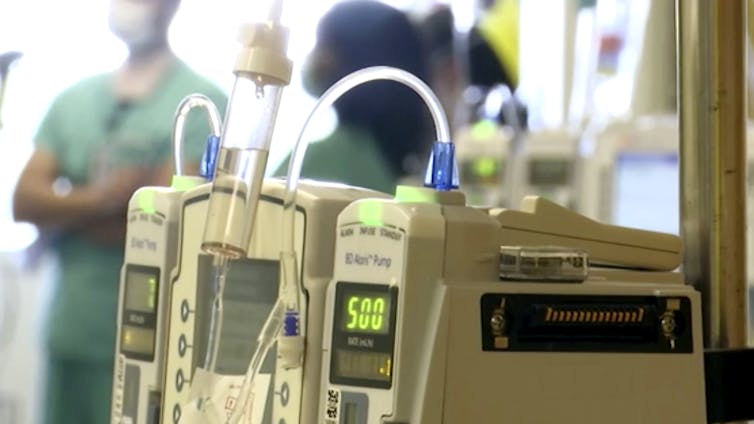
In the United Kingdom, people with intellectual disability were eight times more likely than the rest of the population to die of COVID and disabled people made up 60% of the deaths.
Intellectual disability was second only to age as a risk factor for death from COVID-19 in the US.
What’s Happening In Australia?
COVID-19 infections are more common in disadvantaged areas, both in Australia and internationally.
Residents in disadvantaged communities are more mobile, live and work in close proximity to other people, and are more likely to be essential workers who can’t work from home. These areas also tend to have high concentrations of ethnic minority and migrant communities.
Victoria’s second wave included outbreaks among residents and workers in aged-care facilities, along with outbreaks in health care, meatworks, and disability group homes.
In NSW’s current wave, outbreaks are spreading rapidly in First Nations communities in western NSW and in prisons.
Who Is Getting Vaccinated?
Australia’s vaccine rollout strategy prioritised people at most risk of serious disease and death from COVID-19.
Phase 1A included aged-care and disability group home residents and the workers who support them.
In Phase 1B, First Nations Australians over 55 years and people with disability with chronic conditions were eligible.
People prioritised in these phases were meant to be vaccinated by April.
Read more: Australia has not learned the lessons of its bungled COVID vaccine rollout
More recently, all participants in the National Disability Insurance Scheme and Indigenous Australians 12 years and older became eligible.
Prisoners are not explicitly included as a priority population.
But the strategy came without an implementation plan and vaccination levels are appallingly low in many groups.
Vaccination rates are substantially lower among Indigenous Australians than the population rates in every state and territory, except Victoria where Indigenous vaccination rates are much higher.
In western NSW, where COVID-19 is rapidly spreading through First Nations communities, 11.6% if Indigenous Australians are fully vaccinated compared with 28.9% of non-Indigenous Australians.
Information about vaccination rates among disabled people and workers are not routinely shared and tend to be leaked to the media. On August 22, for example, the Sunday Age revealed just 27% of NDIS participants were fully vaccinated, lagging behind the national rate.
Vaccination of prisoners and prison staff has also been slow. Many states only started their prison vaccination rollout in the last couple of months and data on vaccination coverage in correctional services have not been released (or perhaps even collected).
No Targets Yet For Vaccinating Vulnerable Groups
The Doherty-led COVID-19 vaccination modelling is cited as justifying the federal government’s 80% target. The modelling report acknowledges:
particular attention should be paid to groups in whom socioeconomic, cultural and other determinants are anticipated to result in higher transmission and/or disease outcomes.
The Doherty Institute’s director, Professor Sharon Lewin, emphasised that we need to achieve 80% targets for all Australians including our most disadvantaged citizens.
However, the model itself did not specifically evaluate the potential impact on high-risk groups. Nor does the Commonwealth National Transition Plan focus on equity.
Disadvantaged Australians face triple jeopardy – low vaccination rates, greater likelihood of being infected with COVID-19, and higher risks of serious disease and death from COVID-19.
These risk factors are significant individually. But some individuals face intersectional disadvantage. Indigenous people, for example, experience disability at a higher level than the general population. And people with mental health issues are over-represented in prisons.
Until now, we have relied on public health measures to contain the spread of COVID-19. If we relax these and move quickly to rely mainly on vaccination without ensuring equitable delivery, those most at risk will face a disproportionately greater burden of serious illness and death.
What Can Be Done?
Thankfully, vaccine supply is improving. Australians are being vaccinated at unprecedented levels, particularly in NSW.
However, unless we explicitly move to an equity-based strategy for vaccination, “at risk” populations will be left even further behind.

Equitable allocation of vaccines requires:
- defining priority groups and geographical areas
- allocating an increased share of vaccines or vaccination appointments
- tailoring outreach and communication
- offering vaccinations close to or in workplaces and places where people live including private homes, aged-care facilities, and prisons
- monitoring vaccination uptake
- inclusion of vaccine targets for priority groups in the national plan.
Continuing our current strategy will mean that when we decide the time is right to “live with COVID”, many people who should have been the highest priority for vaccination could die.
We demand a rethink of our vaccine strategy to have an explicit focus on equitable vaccine allocation. Otherwise, it’s simply not “safe” for many Australians to come out of Morrison’s proverbial cave.![]()
Anne Kavanagh, Professor of Disability and Health, Melbourne School of Population and Global Health, The University of Melbourne; Helen Dickinson, Professor, Public Service Research, UNSW, and Nancy Baxter, Professor and Head of Melbourne School of Population & Global Health, The University of Melbourne
This article is republished from The Conversation under a Creative Commons license. Read the original article.
Archaic Laws Prevent Conservationists From Bidding On Public Resources; Experts Think This Should Change
Low-Sodium Salt Prevents Stroke
Notes
1SSaSS: Salt Substitute and Stroke Study into the effect of salt substitutes on cardiovascular events and death
2Tian M, et al. The effect of salt substitute on cardiovascular events and death (SSaSS). N Engl J Med. 10.1056/NEJMoa2105675
3Cogswell ME, Mugavero K, Bowman BA, Frieden TR. Dietary sodium and cardiovascular disease risk -- measurement matters. N Engl J Med. 2016;375:580-586.
4Aburto NJ, Hanson S, Gutierrez H, et al. Effect of increased potassium intake on cardiovascular risk factors and disease: systematic review and meta-analyses. BMJ. 2013;346:f1378.
5Greer RC, Marklund M, Anderson CAM, et al. Potassium-enriched salt substitutes as a means to lower blood pressure. Hypertension. 2020;75:266-274.
6Neal B, Tian M, Li N, et al. Rationale, design, and baseline characteristics of the Salt Substitute and Stroke Study (SSaSS)-A large-scale cluster randomized controlled trial. Am Heart J. 2017;188:109-117.
7Poorly controlled blood pressure was defined as: systolic blood pressure ≥140 mmHg if on blood pressure lowering medication or systolic blood pressure ≥160 mmHg if not on blood pressure lowering medication.
8Marklund M, Singh G, Greer R, et al. Estimated population wide benefits and risks in China of lowering sodium through potassium enriched salt substitution: modelling study. BMJ. 2020;369:m824.
9Bhat S, Marklund M, Henry ME, et al. A systematic review of the sources of dietary salt around the world. Adv Nutr. 2020;11:677-686.
Bruce Neal, Yangfeng Wu, Xiangxian Feng, Ruijuan Zhang, Yuhong Zhang, Jingpu Shi, Jianxin Zhang, Maoyi Tian, Liping Huang, Zhifang Li, Yan Yu, Yi Zhao, Bo Zhou, Jixin Sun, Yishu Liu, Xuejun Yin, Zhixin Hao, Jie Yu, Ka-Chun Li, Xinyi Zhang, Peifen Duan, Faxuan Wang, Bing Ma, Weiwei Shi, Gian Luca Di Tanna, Sandrine Stepien, Sana Shan, Sallie-Anne Pearson, Nicole Li, Lijing L. Yan, Darwin Labarthe, Paul Elliott. Effect of Salt Substitution on Cardiovascular Events and Death. New England Journal of Medicine, 2021; DOI: 10.1056/NEJMoa2105675
Bright Idea: New LEDs Can Detect Off-Food And Lethal Gases
Can A Piece Of Sticky Tape Stop Computer Hackers In Their Tracks?; New Steps Towards Quantum Communications Say ‘Yes’
Increased Survival With Eye Melanoma In Clinical Trial
Disclaimer: These articles are not intended to provide medical advice, diagnosis or treatment. Views expressed here do not necessarily reflect those of Pittwater Online News or its staff.